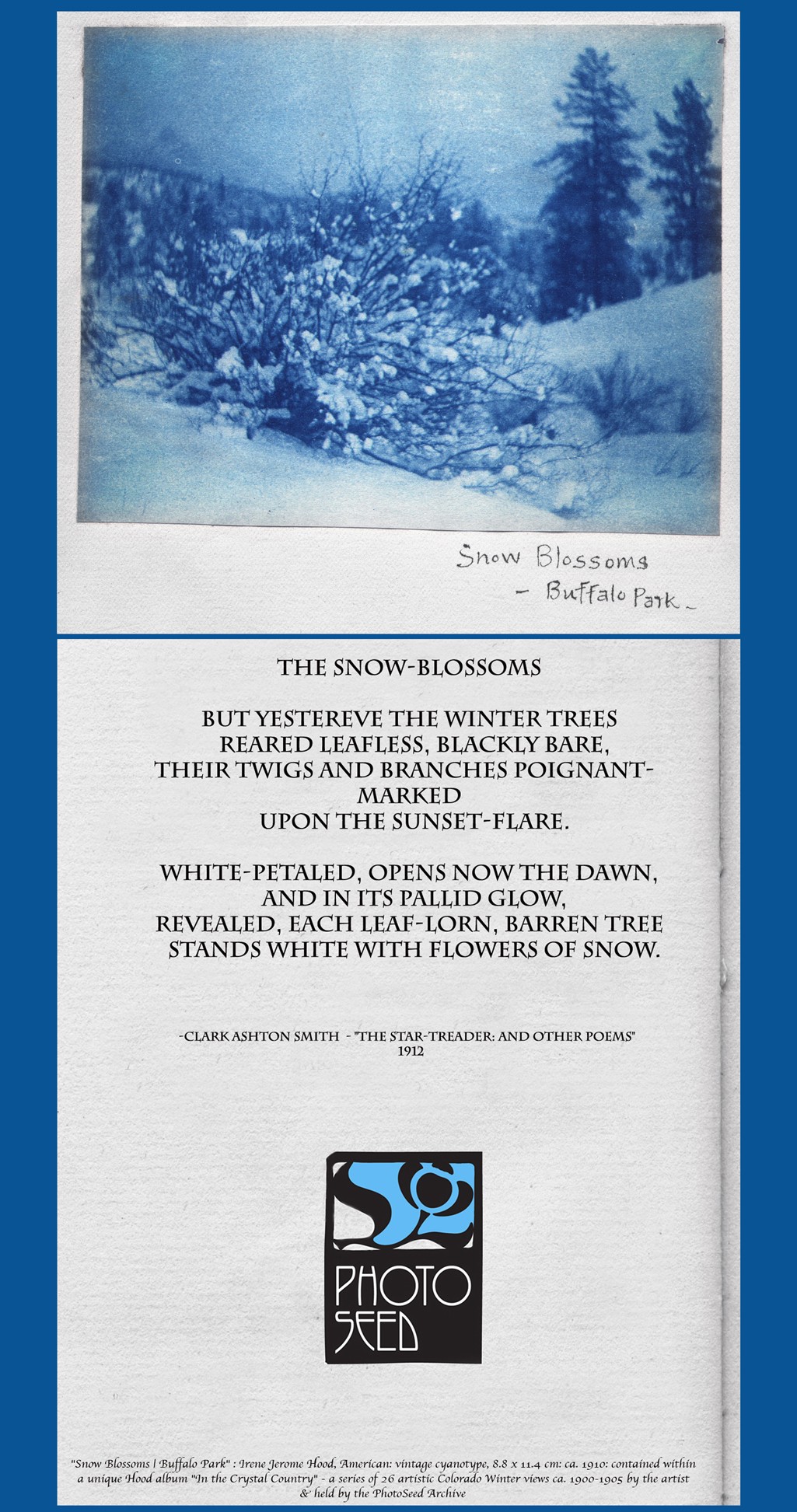Category
Color Photography
14 entries in this category | view all categories
Winter Poem
Posted January 2023 in Alternate Processes, Color Photography, Painters|Photographers, PhotoSeed, Texts, Typography
Deep Holbein
Posted March 2021 in Alternate Processes, Color Photography, New Additions, Significant Photographers, Significant Photographs
A reappraisal of old photos has recently invaded the public conversation of late. Artificial intelligence, in the form of video driver technology invented by Israeli company D-ID, was licensed earlier this year to genealogy and DNA company MyHeritage with the moniker Deep Nostalgia™. Old photographs, no matter their original medium, are brought to life as short animated video clips, and may never be seen in the same way again.
 Screenshot: Animated “A Holbein Woman” from YouTube. Cropped image of the same by American photographers Frances & Mary Electa Allen, ca. 1890 using the Deep Nostalgia™ app licensed to genealogy and DNA company MyHeritage. Original source photograph from PhotoSeed Archive.
Screenshot: Animated “A Holbein Woman” from YouTube. Cropped image of the same by American photographers Frances & Mary Electa Allen, ca. 1890 using the Deep Nostalgia™ app licensed to genealogy and DNA company MyHeritage. Original source photograph from PhotoSeed Archive.
Taking up the company’s free offer to try out the technology, I applied it to a recent archive acquisition, A Holbein Woman, taken in the very early 1890’s by Deerfield, Massachusetts sister photographers Frances Stebbins and Mary Electa Allen. You can see the result in a short 12 second video posted to YouTube embedded above in this post.
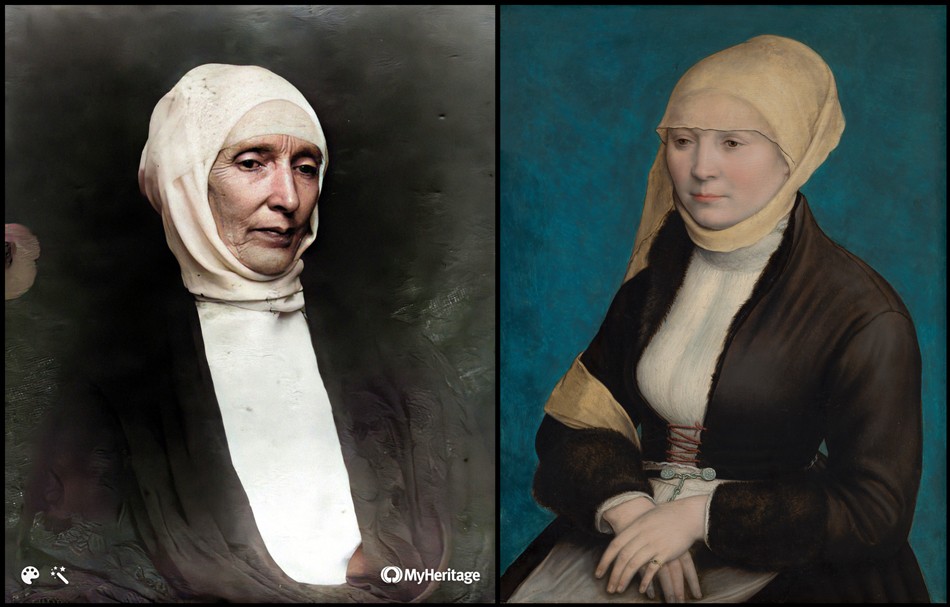 Left: Colorized version of “A Holbein Woman” by American photographers Frances & Mary Electa Allen, ca. 1890. Created by DeOldify deep learning experts Jason Antic and Dana Kelley, this colorizing technology has been licensed from DeOldify by DNA company MyHeritage, with their branding of MyHeritage In Color™. Source photograph from PhotoSeed Archive. Right: “Portrait of a Woman from Southern Germany”: c. 1520-25: Formerly attributed to Hans Holbein the Younger, Germany: (1497/1498-1543): Oil on panel: 45 x 34 cm: Courtesy: collection of the Mauritshuis museum in The Hague.
Left: Colorized version of “A Holbein Woman” by American photographers Frances & Mary Electa Allen, ca. 1890. Created by DeOldify deep learning experts Jason Antic and Dana Kelley, this colorizing technology has been licensed from DeOldify by DNA company MyHeritage, with their branding of MyHeritage In Color™. Source photograph from PhotoSeed Archive. Right: “Portrait of a Woman from Southern Germany”: c. 1520-25: Formerly attributed to Hans Holbein the Younger, Germany: (1497/1498-1543): Oil on panel: 45 x 34 cm: Courtesy: collection of the Mauritshuis museum in The Hague.
The photograph, considered a masterwork of early genre pictorialist portrait photography, is of their mother Mary Stebbins Allen, (1819-1903) and in itself done after the then fashionable practice (1.) of an imitation painting: in this case, a Renaissance portrait by Bavarian artist Hans Holbein the Elder. (c. 1460-1524) To add another layer of mystery, research I did last year revealed the primary source portrait- the oil painting (c.1520-1525) known as “Portrait of a Woman from Southern Germany” in the collection of the Mauritshuis museum in The Hague, was originally attributed to Holbein’s son “The Younger”, (c. 1497-1543) with the now updated disclaimer by the museum’s curators as being “formerly attributed” to this artist. This painting can be seen at upper right, with a colorized version of the Allen sisters portrait run through remarkable colorization technology MyHeritage In Color™ at left.
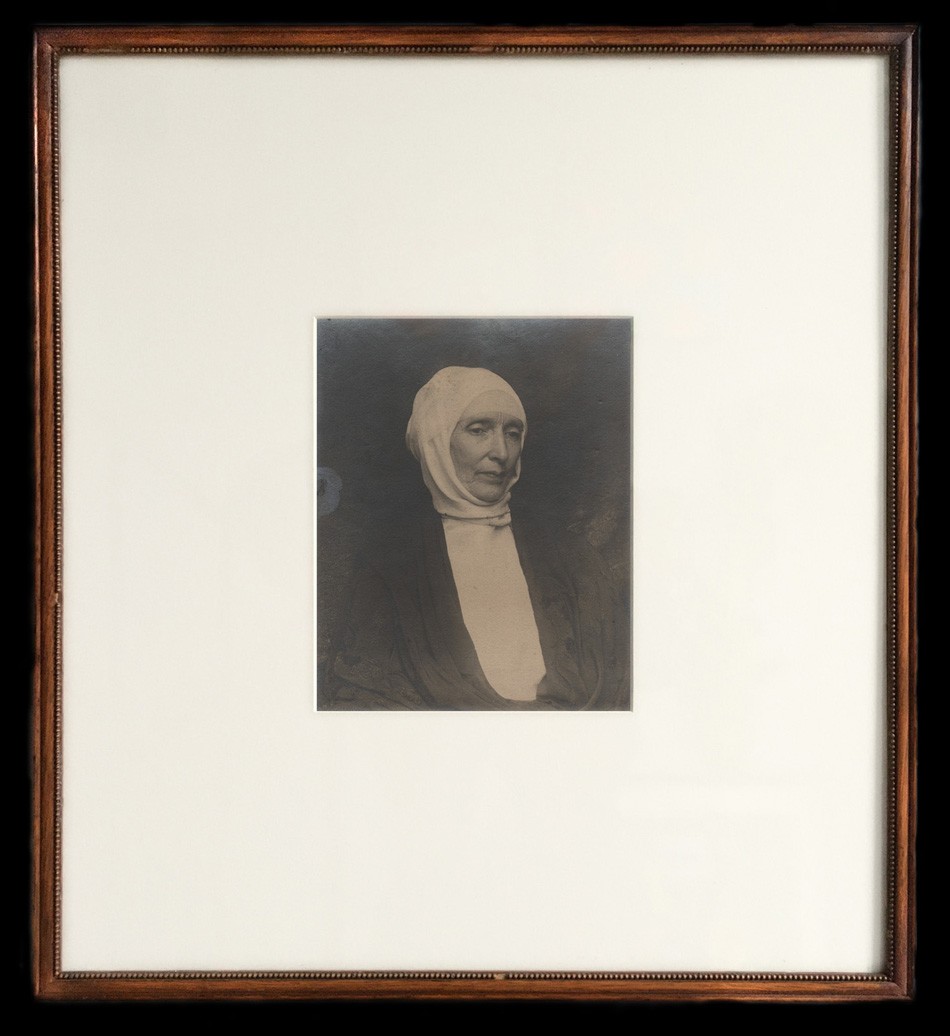 “A Holbein Woman”: Frances Stebbins & Mary Electa Allen, American: 1854-1941 & 1858–1941. Gelatin silver print ca. 1890: 20.1 x 16.3 cm laid down on light gray card mount 35.2 x 27.8 cm: presented here in original ca. 1896 beaded wood frame by Greenfield, MA framer Dunklee & Freeman with original overmat replaced. Done with the intent of being a tribute imitation painting to Hans Holbein’s “Portrait of a Woman from Southern Germany”, the subject of this portrait is the photographer’s mother Mary Stebbins Allen. (1819-1903) The result: “A Holbein Woman”, was one of the earliest and most successful examples of portraiture done by the Deerfield, MA sisters. From: PhotoSeed Archive.
“A Holbein Woman”: Frances Stebbins & Mary Electa Allen, American: 1854-1941 & 1858–1941. Gelatin silver print ca. 1890: 20.1 x 16.3 cm laid down on light gray card mount 35.2 x 27.8 cm: presented here in original ca. 1896 beaded wood frame by Greenfield, MA framer Dunklee & Freeman with original overmat replaced. Done with the intent of being a tribute imitation painting to Hans Holbein’s “Portrait of a Woman from Southern Germany”, the subject of this portrait is the photographer’s mother Mary Stebbins Allen. (1819-1903) The result: “A Holbein Woman”, was one of the earliest and most successful examples of portraiture done by the Deerfield, MA sisters. From: PhotoSeed Archive.
Another words, if being accurate to revisionist history but without the convenient addition of a famous name, (2.) the Allen sisters efforts in the modern day might conceivably be retitled “A Formerly Attributed Woman” rather than “A Holbein Woman”.
And although it is but one example reanimated from that era using new technology, it seems reasonable to conclude 21st Century progress courtesy of Deep Nostalgia™ may only reinforce and belie a continuation of certain prejudices and expectations from the past, the same criticism that could be leveled at video driver technology being only an approximation of humanity, leaving us devoid of the true mannerisms of those who actually lived.
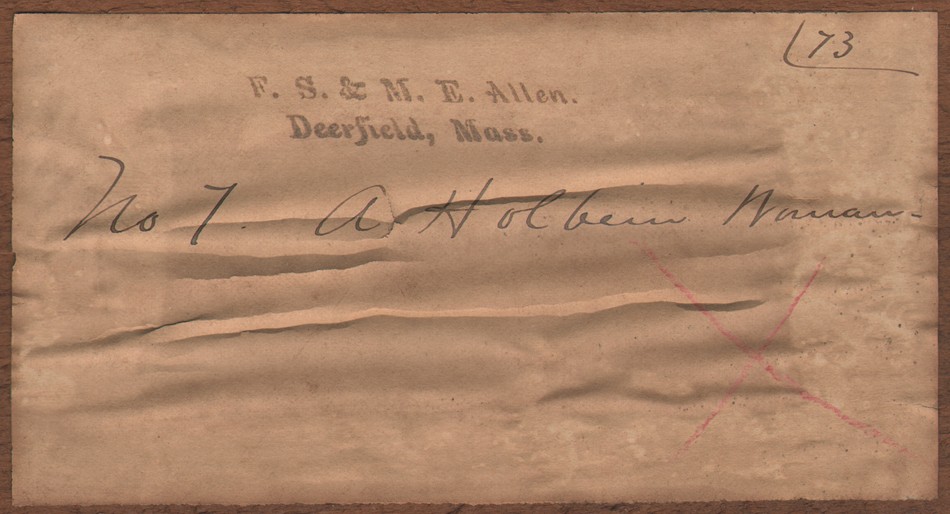 Exhibition label: “A Holbein Woman”: ca. 1896. Pasted white-paper label (7.2 x 13.6 cm) (preserved and cut out from) wood backing board with black ink photographers stamp: F.S. & M.E. Allen. Deerfield, Mass.; in black ink believed to be in the hand of the photographers: No 7 A Holbein Woman: 73 to upper right corner, faint X mark in red ink in lower right. From: PhotoSeed Archive
Exhibition label: “A Holbein Woman”: ca. 1896. Pasted white-paper label (7.2 x 13.6 cm) (preserved and cut out from) wood backing board with black ink photographers stamp: F.S. & M.E. Allen. Deerfield, Mass.; in black ink believed to be in the hand of the photographers: No 7 A Holbein Woman: 73 to upper right corner, faint X mark in red ink in lower right. From: PhotoSeed Archive
“Creepy” is one online descriptor I kept encountering in people’s reactions to this new technology, but when has that ever stopped “progress”? (3.) Are we doomed or can fleeting perceptions of the past in old photographs brought to “life” change our future for the better, our marveling reactions to it as incidental as the new shiny object of the here and now? Only time will tell. (4.) David Spencer-
Notes:
1. The worldwide pandemic brought on by COVID-19 lockdowns inspired a massive revival of imitation paintings and other works of art including photography. Amsterdam’s Rijksmuseum in March, 2020 promoted their Stay at Home Challenge!, inviting people to recreate modern day reinterpretations from masterworks in their collection. This was soon followed by the Getty museum in California. One of the very first “challenge” accounts to promote this revived genre was the Netherlands Instagram account Tussen Kunst & Quarantaine- translating to “between art and quarantine” which first inspired the Rijksmuseum challenge.
2. This would never happen.
3. An examination of ethical concerns as a result of so-called Deepfake technology contained within Deep Nostalgia™ is explored in a New York Times article written by Daniel Victor from March 10, 2021: Your Loved Ones, and Eerie Tom Cruise Videos, Reanimate Unease With Deepfakes.
4. That shiny object has been here since February, 2021. Care to upload a selfie, historical photograph or stock pic of Kim Jong-un, Mao Zedong or Joe Biden and see yourself or them “sing” to popular music? Then download the WOMBO app here. Guardian technology columnist Helen Sullivan reports on March 12, 2021 the app just might be giving competition to Deep Nostalgia™.
Casting out Intrusions
Posted October 2020 in Color Photography, Documentary Photography, New Additions
On this first day of November, the words of American photographer Frederick Britton Hodges, who wrote the following lines about the month in 1915, seem an appropriate tonic for the constant upheaval of the present:
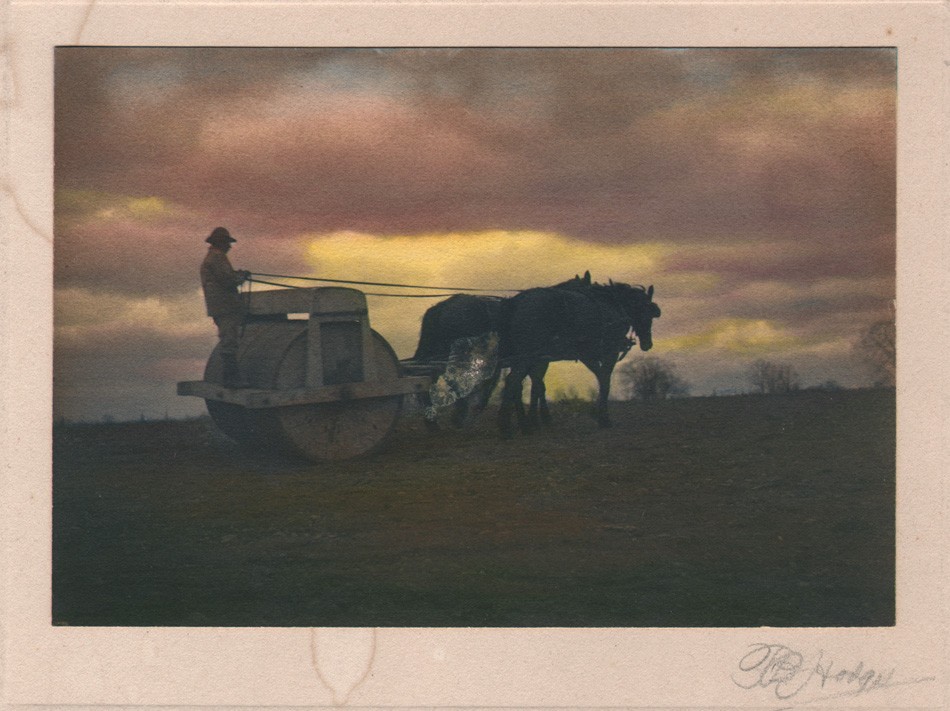 “November Skies”: Frederick Britton Hodges, American: 1868-1955. Vintage platinum print with applied watercolors, ca. 1915: 11.5 x 16.7 cm tipped onto 17.0 x 21.3 cm mount, signed by the artist in graphite at lower right corner. (slight water damage) Born in Rome, New York and spending his entire life there, Hodges was not only a prolific photographer, but a journalist, poet, and naturalist who spent his waking days wandering off the beaten paths of Oneida County New York while documenting the delights of nature with his pen and camera. These often personal and lengthy observations illustrated with his own photographs reached a national audience in photographic journals as well as his local newspaper, the Daily Sentinel of Rome. There, his articles appeared as early as 1886, the year he purchased his first camera and continued until 1938, when his own weekly column was launched. This lasted until 1955, the year of his passing. From: PhotoSeed Archive
“November Skies”: Frederick Britton Hodges, American: 1868-1955. Vintage platinum print with applied watercolors, ca. 1915: 11.5 x 16.7 cm tipped onto 17.0 x 21.3 cm mount, signed by the artist in graphite at lower right corner. (slight water damage) Born in Rome, New York and spending his entire life there, Hodges was not only a prolific photographer, but a journalist, poet, and naturalist who spent his waking days wandering off the beaten paths of Oneida County New York while documenting the delights of nature with his pen and camera. These often personal and lengthy observations illustrated with his own photographs reached a national audience in photographic journals as well as his local newspaper, the Daily Sentinel of Rome. There, his articles appeared as early as 1886, the year he purchased his first camera and continued until 1938, when his own weekly column was launched. This lasted until 1955, the year of his passing. From: PhotoSeed Archive
“The years’ end in November, after all the glorious riot of summer verdure, brings opportunities to observe how full of inspiring force are the more subtle phases of Nature. We are shown to what an extent we are charmed by the variety of form. …
Let us call November the broadening month, the month in which we cast out the selfish intrusions that will creep in and occupy some of the valuable space in our minds, and look with clear, sane eyes. Our ideas are not large enough—no, it is hard to make them so. It takes us a long time to discover good in the work of others, that we disdained, at first, to give a second glance.” (1.)
1. Excerpt: F.B. Hodges: “November”, The Camera, (The Camera Publishing Company): November, 1915. pp. 641-42.
Henry Ravell: Embracing Art & Photography
Posted August 2020 in Alternate Processes, Cameras, Color Photography, Documentary Photography, Framing, History of Photography, New Additions, Painters|Photographers, Photography, Scientific Photography, Significant Photographers
“Coburnesque”, or, in the style of American master pictorialist Alvin Langdon Coburn, (1882-1966) was how the work of now forgotten American photographer Henry Ravell (1864-1930) was described in 1908 by London’s Amateur Photographer & Photographic News.
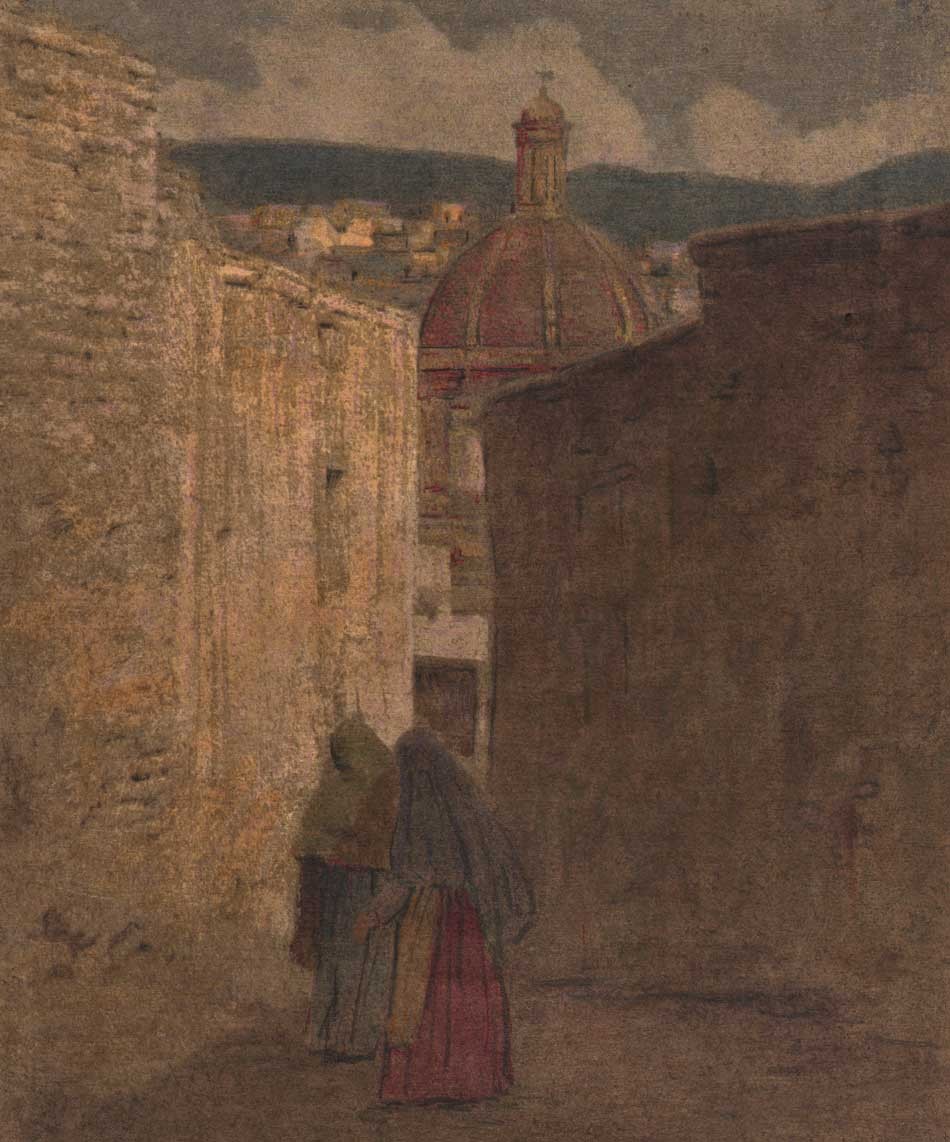 Detail: “A Narrow Street-Guanajuato”: Henry Ravell, American: 1864-1930. Vintage multiple color gum print c. 1907-14. Image: 33.1 x 23.5 presented loose within brown paper folder with overall support dimensions of 39.8 x 58.8 cm. In central Mexico, with the dome of a church framing the skyline at center in background, two native women make their way along one of Guanajuato’s narrow streets. Henry Ravell perfected the gum bichromate process to a very high level. Probably in 1906-07, he began experimenting in multiple color gum. In Germany, around this same time, similar examples were being done by the brothers Theodor (1868-1943) and Oscar Hofmeister, (1871-1937) as well as Heinrich Wilhelm Müller. (1859-1933) From: PhotoSeed Archive
Detail: “A Narrow Street-Guanajuato”: Henry Ravell, American: 1864-1930. Vintage multiple color gum print c. 1907-14. Image: 33.1 x 23.5 presented loose within brown paper folder with overall support dimensions of 39.8 x 58.8 cm. In central Mexico, with the dome of a church framing the skyline at center in background, two native women make their way along one of Guanajuato’s narrow streets. Henry Ravell perfected the gum bichromate process to a very high level. Probably in 1906-07, he began experimenting in multiple color gum. In Germany, around this same time, similar examples were being done by the brothers Theodor (1868-1943) and Oscar Hofmeister, (1871-1937) as well as Heinrich Wilhelm Müller. (1859-1933) From: PhotoSeed Archive
Under the headline “Local Colour.” by journal critic “The Magpie”, a discussion of the merits around Ravell’s new color multiple gum printing process was considered for their large readership. Commenting on a series of his Mexican church photographs published in the May issue of the Century Magazine, “Magpie” writes:
“Who is this Mr. Ravell, and what is his wonderful colour process, which is not “on the negative”? Multiple-gum, one may surmise- and one may also venture to guess that Mr. “de Forest” (Lockwood de Forest- editor) has, notwithstanding this flourish of trumpets, nothing very much to tell us. The Ravell photographs, illustrating “Some Mexican Churches,” are Coburnesque, and the pictures are, in their very Yankee style, fine and strong- which is more than can be said for those in our English monthlies. Couldn’t Mr. Ravell be induced to send some examples of his work to the R.P.S. or Salon? We badly need some new American exhibitors.” (June 16, p. 600)
A reassessment of Ravell’s output is long overdue in elevating him back to his rightful position as one of the more important practitioners of pictorialism in the early 20th Century canon of American artistic photographers.
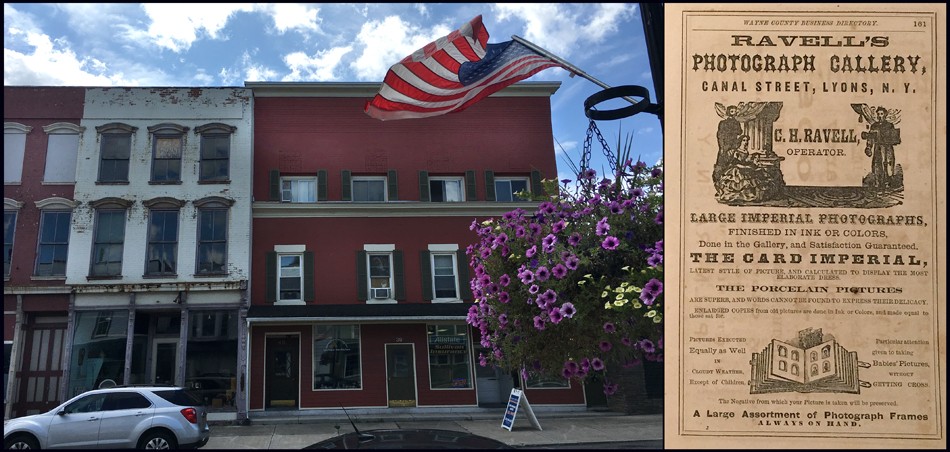 Left: Henry Ravell was only a toddler when his father Charles Henry Ravell (1833-1917) opened a skylight photographic studio on the third floor of this brick building painted red located on Canal Street in Lyons, New York around 1865-66. Shown here in the summer of 2019, the entrance was at the present day 36 Canal street (on the far right of the photo-presently an insurance office) but was numbered #30 Canal before the turn of the 20th Century. It was here that Henry was “brought up in photography from childhood and became an expert in all processes before he was twelve years old”. Right: A full-page advertisement for “Ravell’s Photograph Gallery” operated by C.H. Ravell at the Canal street building appeared in the 1867-68 Wayne County (New York) Business Directory. At the time, Charles Ravell would have been using the wet-plate process, and the ad highlights “Large Imperial Photographs finished in Ink or Colors”… “Pictures Executed Equally as Well in Cloudy Weather Except of Children”… “Particular attention given to taking Babies’ Pictures, without Getting Cross”. Left: David Spencer for PhotoSeed Archive; Right: courtesy Museum of Wayne County History.
Left: Henry Ravell was only a toddler when his father Charles Henry Ravell (1833-1917) opened a skylight photographic studio on the third floor of this brick building painted red located on Canal Street in Lyons, New York around 1865-66. Shown here in the summer of 2019, the entrance was at the present day 36 Canal street (on the far right of the photo-presently an insurance office) but was numbered #30 Canal before the turn of the 20th Century. It was here that Henry was “brought up in photography from childhood and became an expert in all processes before he was twelve years old”. Right: A full-page advertisement for “Ravell’s Photograph Gallery” operated by C.H. Ravell at the Canal street building appeared in the 1867-68 Wayne County (New York) Business Directory. At the time, Charles Ravell would have been using the wet-plate process, and the ad highlights “Large Imperial Photographs finished in Ink or Colors”… “Pictures Executed Equally as Well in Cloudy Weather Except of Children”… “Particular attention given to taking Babies’ Pictures, without Getting Cross”. Left: David Spencer for PhotoSeed Archive; Right: courtesy Museum of Wayne County History.
Undoubtedly, “Magpie” would have been pleased to know Henry Ravell sprung from fine English photographic stock. His father Charles Henry Ravell (1833-1917) emigrated to the U.S. from Boston, England and was known to have been active as a Daguerreotypist as early as 1857, (1.) his trade shingle set up early in the New York state village of Chittenango. By 1860, U.S. Census records show he had moved to Wolcott, New York, where he was a commercial photographer. Surviving cdv photographs from here bearing his C.H. Ravell back-stamp reveal some of his clients were young men heading off to fight in the American Civil War.
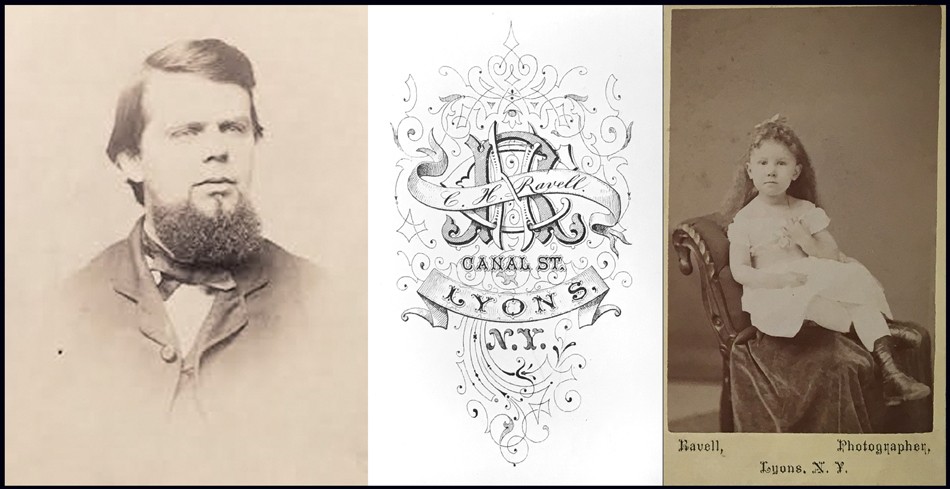 Left: This is the only known portrait of commercial portrait photographer Charles Henry Ravell, father of Henry Ravell. The carte de visite albumen portrait shows him most likely in his early 30’s, after he had settled in Lyons, New York. Born Charles Herring Ravel in Boston, England, he emigrated to the U.S. as a young man, with an early notice of his Daguerreotypist skills from 1857 showing he was living in Chittenango, New York State. By 1860, he had settled in Wolcott, where son Henry was born in early 1864. By 1867 or earlier, he and wife Cornelia Dudley Ravell (1840-1908) and Henry had moved permanently to nearby Lyons. Middle & Right: This elaborate backstamp engraving for C.H. Ravell’s Canal Street skylight studio in Lyons is ca. 1865-80, with the albumen portrait subject (Right) a young girl posing on a commercially available chair. Both: courtesy Museum of Wayne County History
Left: This is the only known portrait of commercial portrait photographer Charles Henry Ravell, father of Henry Ravell. The carte de visite albumen portrait shows him most likely in his early 30’s, after he had settled in Lyons, New York. Born Charles Herring Ravel in Boston, England, he emigrated to the U.S. as a young man, with an early notice of his Daguerreotypist skills from 1857 showing he was living in Chittenango, New York State. By 1860, he had settled in Wolcott, where son Henry was born in early 1864. By 1867 or earlier, he and wife Cornelia Dudley Ravell (1840-1908) and Henry had moved permanently to nearby Lyons. Middle & Right: This elaborate backstamp engraving for C.H. Ravell’s Canal Street skylight studio in Lyons is ca. 1865-80, with the albumen portrait subject (Right) a young girl posing on a commercially available chair. Both: courtesy Museum of Wayne County History
Born in early January of 1864 in Wolcott, Henry Ravell is known to have embraced photography from a very young age. As a boy, he became his father’s apprentice. Lockwood de Forest, (1850-1932) an important influence on Henry for the rest of his life in the 20th Century and important American painter and furniture designer, wrote in 1908 that Henry:
“was born and brought up in photography from childhood and became an expert in all processes before he was twelve years old.” Through a fascinating confluence of sons starting out in their father’s professions, Henry Ravell graduated to having an interest in art, and he studied water-color painting with the noted American artist and Tonalist Henry Ward Ranger, (1858-1916) probably in his late teens or early 20’s. The artist and student had much in common. Like Charles Henry Ravell, who had established his own Canal Street photo studio in Lyons, N.Y. by 1867, (Wayne County Business Directory) Ranger’s father Ward Valencourt Ranger (1835–1905) had opened his own commercial studio in 1868 in Syracuse, N.Y., 55 miles east of Lyons, almost at the same time. Like Henry Ravell working for his father at an early age, Henry Ranger was also known to have worked in his father’s establishment as a young man.
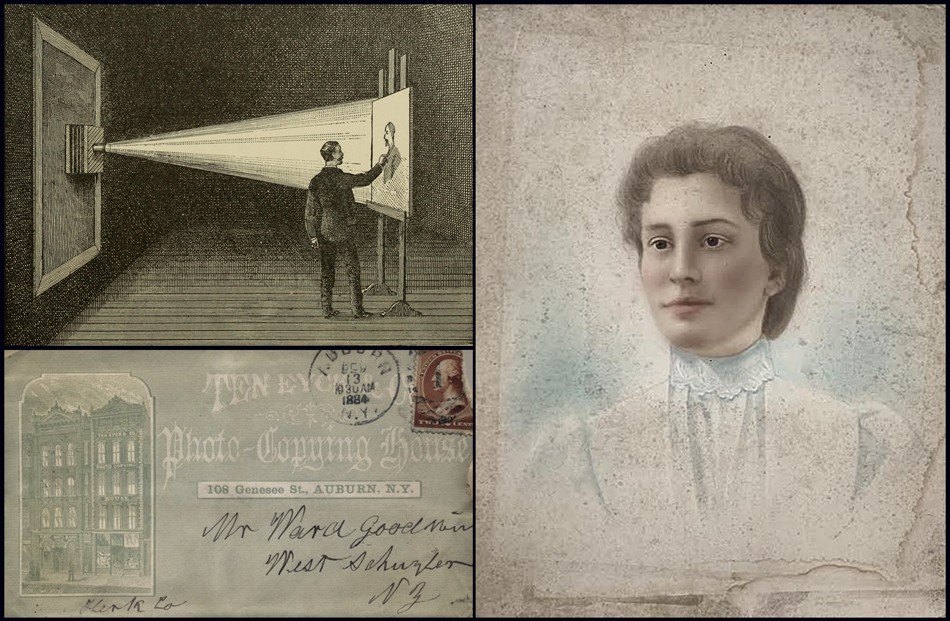 Upper Left: “Negative Outline-Dark Chamber”: woodcut from 1892 volume “Crayon Portraiture: Complete Instructions for making Crayon Portraits on Crayon Paper and on Platinum, Silver, and Bromide Enlargements” by J.A. Barhydt. In the early 1880’s, Henry Ravell worked in a similar capacity as the artist shown here for the Photo-Copying House Ten Eyck & Co. of Auburn, New York. Woodcut shows an enlarged and enhanced crayon portrait being made freehand on the easel at right. A photographic negative from a sitter has been placed inside a large box camera at left while mounted in front of a scrimmed-off window. This provides the light source for the projection within a darkened room while the artist goes over the outline and shadow lines of the projection in a first step. Other variations of crayon portraits began with an artist working in a lighted studio with charcoal and pastels after the initial projected outline on crayon, gelatin, bromide, etc. papers had been chemically fixed. Ten Eyck advertised on cover stationary from 1884: “Fine Portraits in India Ink, Water Colors and Crayon, By the Association of Celebrated Portrait Artists…” (From: Internet Archive) Lower Left: December, 1884 postmarked cover (envelope) from Ten Eyck & Co. Portraits located at 108 Genesee St., Auburn, N.Y. (8.5 x 15.0 cm-right margin perished) Ravell worked at the firm about this time, making a living combining his skill of photography and art. In the late 1880’s to early 1890’s, he became an agent for Ten Eyck after moving to Mexico. From: PhotoSeed Archive. Right: “Crayon-style Portrait” ca. 1890-5: (50.9 x 40.5 cm) enhanced water-color or India inks applied by hand to unknown (bromide?) photographic emulsion fixed onto light grade cardboard matrix. Henry Ravell produced similar crayon-style portraits for Ten Eyck, with this example from an unknown artist featuring Mary Carruthers Tucker (1877-1940) as subject, then living in Provo-City Utah. She was the spouse of C.R. Tucker, whose work is featured at PhotoSeed. From: PhotoSeed Archive
Upper Left: “Negative Outline-Dark Chamber”: woodcut from 1892 volume “Crayon Portraiture: Complete Instructions for making Crayon Portraits on Crayon Paper and on Platinum, Silver, and Bromide Enlargements” by J.A. Barhydt. In the early 1880’s, Henry Ravell worked in a similar capacity as the artist shown here for the Photo-Copying House Ten Eyck & Co. of Auburn, New York. Woodcut shows an enlarged and enhanced crayon portrait being made freehand on the easel at right. A photographic negative from a sitter has been placed inside a large box camera at left while mounted in front of a scrimmed-off window. This provides the light source for the projection within a darkened room while the artist goes over the outline and shadow lines of the projection in a first step. Other variations of crayon portraits began with an artist working in a lighted studio with charcoal and pastels after the initial projected outline on crayon, gelatin, bromide, etc. papers had been chemically fixed. Ten Eyck advertised on cover stationary from 1884: “Fine Portraits in India Ink, Water Colors and Crayon, By the Association of Celebrated Portrait Artists…” (From: Internet Archive) Lower Left: December, 1884 postmarked cover (envelope) from Ten Eyck & Co. Portraits located at 108 Genesee St., Auburn, N.Y. (8.5 x 15.0 cm-right margin perished) Ravell worked at the firm about this time, making a living combining his skill of photography and art. In the late 1880’s to early 1890’s, he became an agent for Ten Eyck after moving to Mexico. From: PhotoSeed Archive. Right: “Crayon-style Portrait” ca. 1890-5: (50.9 x 40.5 cm) enhanced water-color or India inks applied by hand to unknown (bromide?) photographic emulsion fixed onto light grade cardboard matrix. Henry Ravell produced similar crayon-style portraits for Ten Eyck, with this example from an unknown artist featuring Mary Carruthers Tucker (1877-1940) as subject, then living in Provo-City Utah. She was the spouse of C.R. Tucker, whose work is featured at PhotoSeed. From: PhotoSeed Archive
Sometime in the early 1880’s after Henry had finished this “apprenticeship”, he moved to nearby Auburn, New York, about halfway to Syracuse from Lyons, to a job crafting Crayon and Pastel portrait photographic enlargements for Ten Eyck & Co. At the time, this firm is said to have been the largest of its’ type in the world. This gave Henry additional artistic skills, combining his interest in photography and art, an important and influential confluence indeed. He kept at this profession until either 1883, according to Lockwood de Forest, or as late as 1892, in a posthumous biography of Henry by sister Florence.
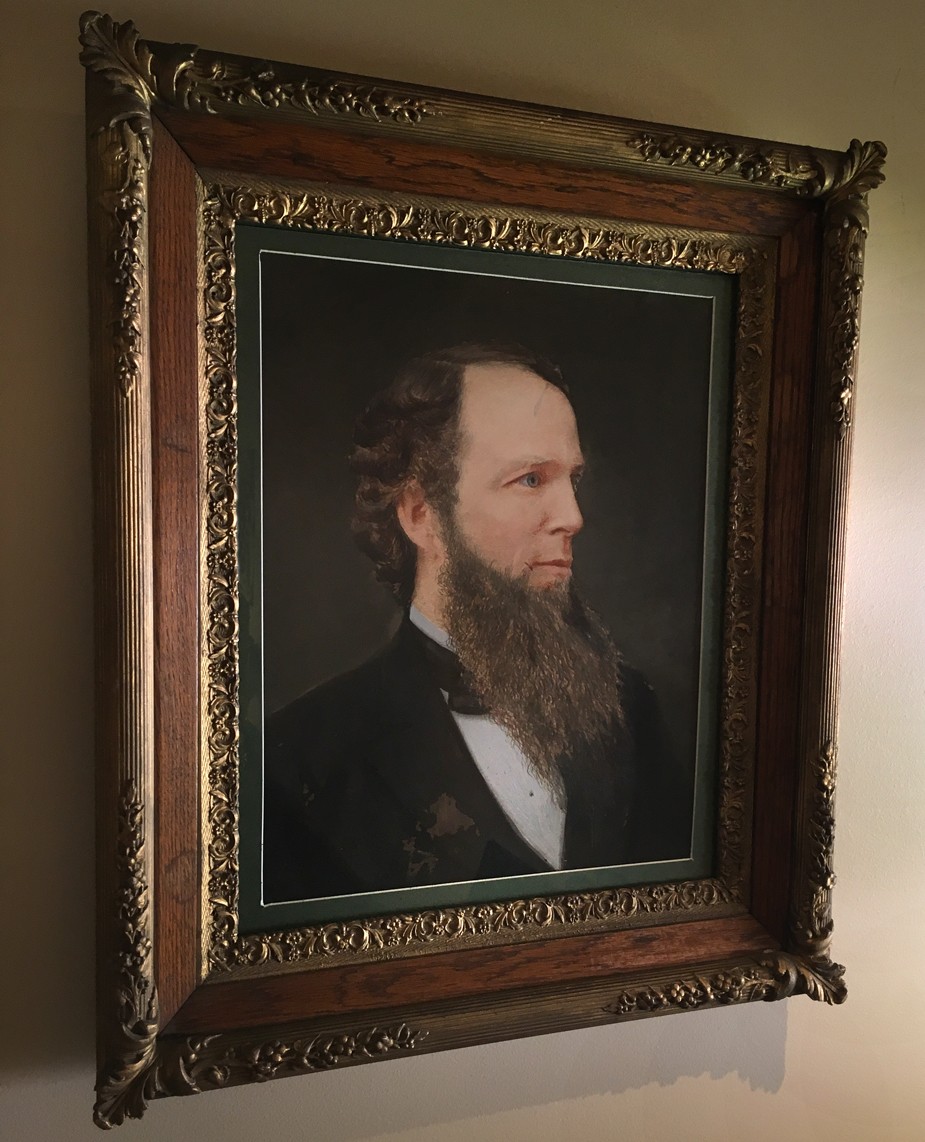 “Portrait of John Lee Cole”: Henry Ravell, American: 1864-1930. Ca. 1885 Gouache and or Oil? on paper, mounted within period wood frame bearing inscription “John L. Cole to Jason Parker, 1918”. This very rare example of a surviving painting by photographer Henry Ravell is now owned by the Museum of Wayne County History in Lyons, New York. Cole was a 1859 graduate of Yale and grandson of the Rev. John Cole, a founder with John Wesley of the Methodist Church in the U.S.. In 1862 he was admitted to the bar and later became a banker in Lyons for Mirick & Cole. An earlier 1882 notice of Henry’s artistic pursuits was published in The Democrat and Chronicle newspaper of Rochester, New York: “Henry Ravell, of Lyons, was in this city last night, on his return from Medina, (New York-editor) where he disposed of two of his latest paintings for $70.” (November 26) Photo by David Spencer for PhotoSeed Archive- artwork courtesy Museum of Wayne County History, Lyons N.Y.
“Portrait of John Lee Cole”: Henry Ravell, American: 1864-1930. Ca. 1885 Gouache and or Oil? on paper, mounted within period wood frame bearing inscription “John L. Cole to Jason Parker, 1918”. This very rare example of a surviving painting by photographer Henry Ravell is now owned by the Museum of Wayne County History in Lyons, New York. Cole was a 1859 graduate of Yale and grandson of the Rev. John Cole, a founder with John Wesley of the Methodist Church in the U.S.. In 1862 he was admitted to the bar and later became a banker in Lyons for Mirick & Cole. An earlier 1882 notice of Henry’s artistic pursuits was published in The Democrat and Chronicle newspaper of Rochester, New York: “Henry Ravell, of Lyons, was in this city last night, on his return from Medina, (New York-editor) where he disposed of two of his latest paintings for $70.” (November 26) Photo by David Spencer for PhotoSeed Archive- artwork courtesy Museum of Wayne County History, Lyons N.Y.
At this time, Henry is said to have moved to Cuernavava Mexico, south of Mexico City, where he became a far-flung agent for the Ten Eyck & Co. firm, although a certain amount of traveling back and forth to the U.S. and the family home was probably the reality. To wit, the Minnesota State Census for 1895 lists his occupation as “artist”, claiming an American residence while living with his father, mother and younger brother, Charles Ravell Jr. in the city of St. Paul. Here his father finished out his career running a photo studio on Western Ave. from 1890-92.
During the mid 1880’s back in Lyons, a fascinating yet presently unsubstantiated account of Henry’s involvement with the development of the first Kodak camera is relevant for background on his future career as a master photographer who became a striver with his own agenda. This event is worthy of historical contemplation in the present from reminisces provided in the aforementioned posthumous biography published in 1940:
“George Eastman of Rochester, New York, was a family friend. During a visit of three or four weeks, Mr. Eastman worked on and developed his famous Kodak, with the help of my father and brother.” “Their workshop was the basement of our former home at 70 Broad Street, Lyons. Mr. Eastman offered my father stock in the Kodak Company, which he often regretted not accepting.” (2.)
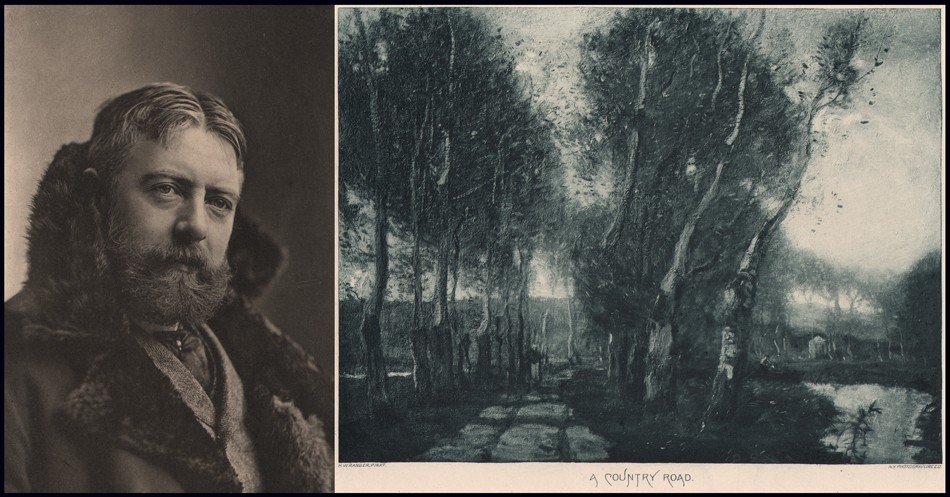 Left: “H.W. Ranger” (Henry Ward Ranger): Napoleon Sarony, American: born Quebec. (1821-1896) Photogravure published in periodical "Sun & Shade": New York: May, 1894: whole #69: N.Y. Photo-Gravure Co.: 22.4 x 15.2 | 34.9 x 27.6 cm. Like Henry Ravell assisting in his father’s studio, American artist and Tonalist Henry Ward Ranger (1858-1916) worked in his own father’s studio as a young man. Later, Ranger taught Henry water-color painting, probably when Ravell was in his late teens or early 20’s. The “Sun & Shade” periodical noting of Ranger: “His work in Lower Canada won him great repute, and as a water-color painter, before taking to oil-painting, he was undeniably excellent.” Right: “A Country Road”: Henry Ward Ranger, American. (1858-1916) Photogravure published in periodical "Sun & Shade": New York: May, 1894: whole #69: N.Y. Photo-Gravure Co.: 17.1 x 22.7 | 27.6 x 34.9 cm. Ranger’s bucolic painting style reveals itself in this simple country scene of a roadway lined with trees, probably done in Holland. Scenes like this would have undoubtedly made an impression on Henry the fledgling art student, assuming he had access to reproductions or the originals of his teacher’s work. On Ranger in the periodical: “He is an admirer and follower of the best Dutch school of art, and has made it his pleasure and his duty to pay many visits to Holland, in order to be perfectly au fait with the excellencies of its best masters.” On “A Country Road”: “It is seldom that so simple a subject becomes so important in form and color-so full of air and freedom, and so admirably harmonious in its proportions.” Both from: PhotoSeed Archive
Left: “H.W. Ranger” (Henry Ward Ranger): Napoleon Sarony, American: born Quebec. (1821-1896) Photogravure published in periodical "Sun & Shade": New York: May, 1894: whole #69: N.Y. Photo-Gravure Co.: 22.4 x 15.2 | 34.9 x 27.6 cm. Like Henry Ravell assisting in his father’s studio, American artist and Tonalist Henry Ward Ranger (1858-1916) worked in his own father’s studio as a young man. Later, Ranger taught Henry water-color painting, probably when Ravell was in his late teens or early 20’s. The “Sun & Shade” periodical noting of Ranger: “His work in Lower Canada won him great repute, and as a water-color painter, before taking to oil-painting, he was undeniably excellent.” Right: “A Country Road”: Henry Ward Ranger, American. (1858-1916) Photogravure published in periodical "Sun & Shade": New York: May, 1894: whole #69: N.Y. Photo-Gravure Co.: 17.1 x 22.7 | 27.6 x 34.9 cm. Ranger’s bucolic painting style reveals itself in this simple country scene of a roadway lined with trees, probably done in Holland. Scenes like this would have undoubtedly made an impression on Henry the fledgling art student, assuming he had access to reproductions or the originals of his teacher’s work. On Ranger in the periodical: “He is an admirer and follower of the best Dutch school of art, and has made it his pleasure and his duty to pay many visits to Holland, in order to be perfectly au fait with the excellencies of its best masters.” On “A Country Road”: “It is seldom that so simple a subject becomes so important in form and color-so full of air and freedom, and so admirably harmonious in its proportions.” Both from: PhotoSeed Archive
Memories can sometimes be suspect, but several details of Florence’s biography are important and worth following up on, with this website happy to accept the challenge. By tracking down old street addresses, the Ravell family home as published in the 1886-87 Lyons residential directory was actually found to be located as 40 Broad Street. (William Smith, whose occupation was Express Transfer Agent, lived at 70 Broad St. as published in the same directory) Coupled with the knowledge that Lyons street addresses had been renumbered, probably in the early 20th Century, and cross-referencing with a 1904 Sanborn Fire Insurance Company map found online at the Library of Congress, the former and still standing Ravell home built in 1850 revealed itself to be the present day 64 Broad Street. All of this effort, if somehow confirming a claim George Eastman had actually spent time in Lyons was true, could result in a potentially fascinating footnote to the development of one of the most important inventions of the 19th Century- The Kodak No. 1 Camera which debuted in 1888: “By far the most significant event in the history of amateur photography”, according to the Met Museum in New York City.
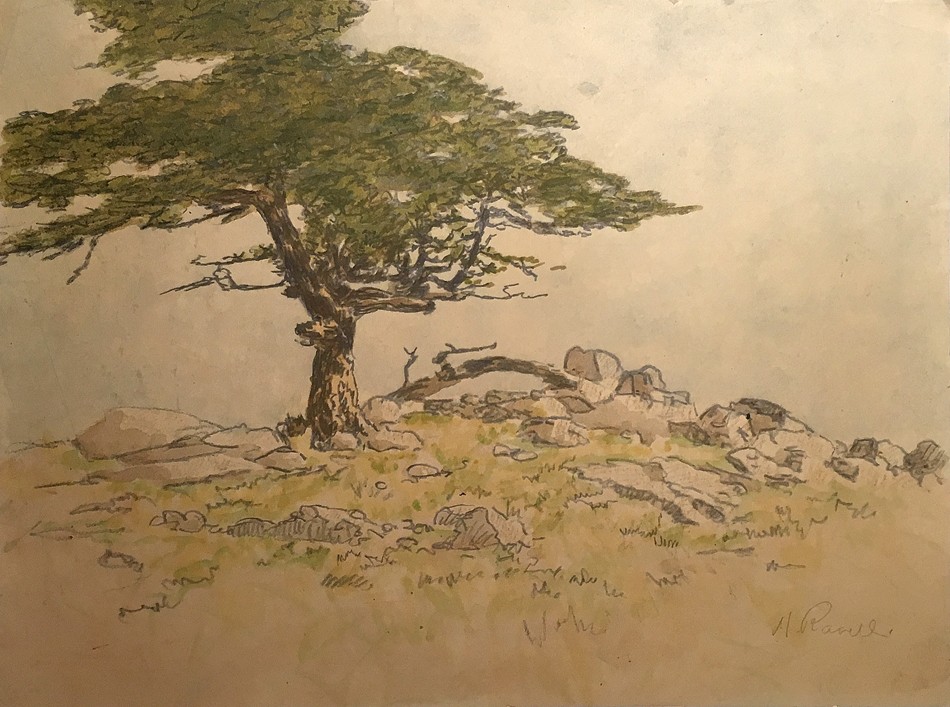 “Cypress Tree -Pebble Beach”: Henry Ravell, American: 1864-1930. Vintage watercolor drawing on paper: ca. 1915-20. (Museum of Wayne County History accession #Pi 176f with verso sticker additionally listing number 148 and $30.00) One of the few known examples of a watercolor drawing by Ravell is this delicate landscape featuring a lone cypress tree springing from a rock outcropping in Pebble Beach on California’s Monterey Peninsula. It may depict the world famous “Lone Cypress”, an approximately 250 year-old Monterey Cypress standing today on a granite hillside off the famed 17-Mile Drive. Courtesy: Museum of Wayne County History, Lyons N.Y.
“Cypress Tree -Pebble Beach”: Henry Ravell, American: 1864-1930. Vintage watercolor drawing on paper: ca. 1915-20. (Museum of Wayne County History accession #Pi 176f with verso sticker additionally listing number 148 and $30.00) One of the few known examples of a watercolor drawing by Ravell is this delicate landscape featuring a lone cypress tree springing from a rock outcropping in Pebble Beach on California’s Monterey Peninsula. It may depict the world famous “Lone Cypress”, an approximately 250 year-old Monterey Cypress standing today on a granite hillside off the famed 17-Mile Drive. Courtesy: Museum of Wayne County History, Lyons N.Y.
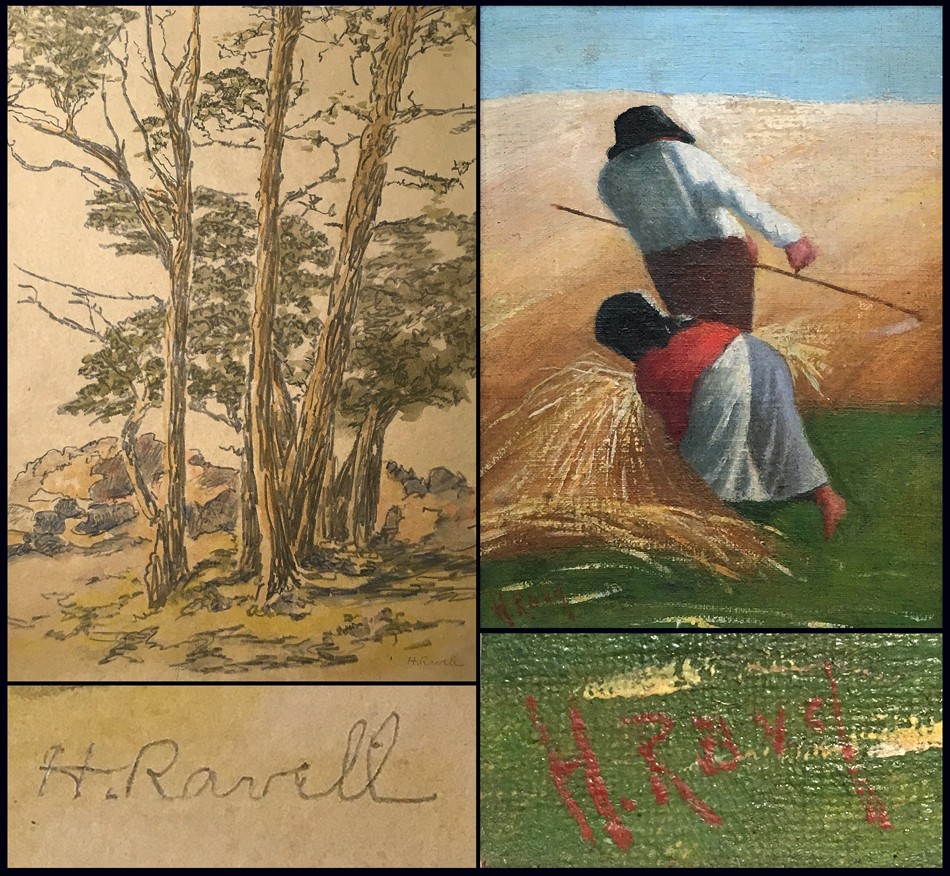 This panel reveals the artistic styles of two distinct artists signing their work nearly identically. It’s presented with the hope a distinction can be made for a larger audience. The reality at present: nearly every painting returned on web searches is misattributed to being by photographer/artist Henry Ravell. Left Diptych: Top: “Cypress Trees at Pebble Beach”: Henry Ravell, American: 1864-1930. Vintage watercolor drawing on paper: ca. 1915-20. (Museum of Wayne County History accession #Pi 176e with verso sticker additionally listing number 147 and $20.00) This is one of three rare watercolor drawings by Ravell. Showing a stand of cypress trees in Pebble Beach on California’s Monterey Peninsula, the signature of “H.Ravell” in graphite has been enlarged in separate bottom panel. Courtesy: Museum of Wayne County History. Right Diptych: Top: “The Ripers” (The Reapers): Henry Etienne Ravel, American, born Naples Italy to French citizens. (1872-1962) Oil on artists board: ca. 1946: 20.5 x 15.4 presented within wood frame (not shown) 24.5 x 19.4 x 2.0 cm. Two field workers harvest wheat, a small landscape most likely depicting the Italian countryside. Henry Ravel immigrated to America in 1906 and became a naturalized US citizen in 1920. A transportation clerk by trade in the early 1920’s, his paintings- many done in Europe- date from ca. 1930’s-1950’s. Enlarged signature at bottom panel: “H. Ravel”. From: PhotoSeed Archive
This panel reveals the artistic styles of two distinct artists signing their work nearly identically. It’s presented with the hope a distinction can be made for a larger audience. The reality at present: nearly every painting returned on web searches is misattributed to being by photographer/artist Henry Ravell. Left Diptych: Top: “Cypress Trees at Pebble Beach”: Henry Ravell, American: 1864-1930. Vintage watercolor drawing on paper: ca. 1915-20. (Museum of Wayne County History accession #Pi 176e with verso sticker additionally listing number 147 and $20.00) This is one of three rare watercolor drawings by Ravell. Showing a stand of cypress trees in Pebble Beach on California’s Monterey Peninsula, the signature of “H.Ravell” in graphite has been enlarged in separate bottom panel. Courtesy: Museum of Wayne County History. Right Diptych: Top: “The Ripers” (The Reapers): Henry Etienne Ravel, American, born Naples Italy to French citizens. (1872-1962) Oil on artists board: ca. 1946: 20.5 x 15.4 presented within wood frame (not shown) 24.5 x 19.4 x 2.0 cm. Two field workers harvest wheat, a small landscape most likely depicting the Italian countryside. Henry Ravel immigrated to America in 1906 and became a naturalized US citizen in 1920. A transportation clerk by trade in the early 1920’s, his paintings- many done in Europe- date from ca. 1930’s-1950’s. Enlarged signature at bottom panel: “H. Ravel”. From: PhotoSeed Archive
The earliest published references to Ravell’s photographic work in the popular press is found around 1905, when Boston’s Photo-Era, writing for their December issue, pronounces him “A new star of the first magnitude”, although noting his two pictures: “Pleasant Valley” and “Viga Canal”, “do not represent him at his best.” This assessment also including listing him on the journal’s noteworthy list of exhibitors whose work had been accepted for the Second American Photographic Salon which ran from 1905-06.
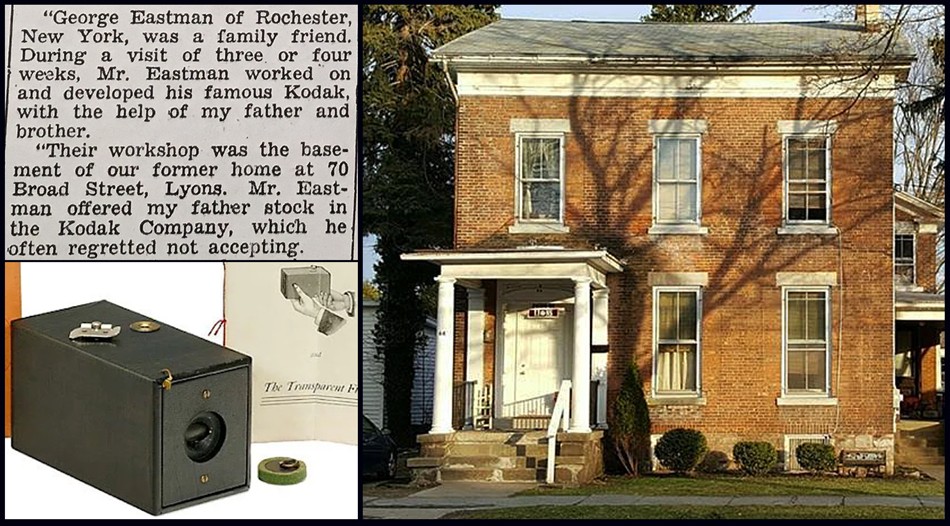 Upper Left: This quote by Henry Ravell’s older sister Florence Ravell Lothrop appeared in The Lyons Republican & Clyde Times on March 21, 1940 stating Henry and their father Charles Henry Ravell had worked with a young George Eastman in developing the world’s first Kodak camera from 1888 in the basement workshop of their Lyons home. Clipping courtesy Museum of Wayne County History. Lower Left: An original Kodak No. 1 camera from 1888 shown with its lens cap and original documents appeared as Lot 0238 and sold by Auction Team Breker of Cologne, Germany on September 30, 2006. The Metropolitan Museum of Art in New York states: “By far the most significant event in the history of amateur photography was the introduction of the Kodak #1 camera in 1888. Invented and marketed by George Eastman (1854–1932), a former bank clerk from Rochester, New York, the Kodak was a simple box camera that came loaded with a 100-exposure roll of film”. Courtesy Auction Team Breker. Far Right: Built in 1850, the former Ravell family home in Lyons, New York was actually located at 64 Broad Street-seen here: not 70 Broad Street as stated in the clipping. The actual address was confirmed by this website using Sanborn fire insurance maps and a Lyons residential street directory from 1886-7. Home exterior courtesy 2018 online real estate sales listing.
Upper Left: This quote by Henry Ravell’s older sister Florence Ravell Lothrop appeared in The Lyons Republican & Clyde Times on March 21, 1940 stating Henry and their father Charles Henry Ravell had worked with a young George Eastman in developing the world’s first Kodak camera from 1888 in the basement workshop of their Lyons home. Clipping courtesy Museum of Wayne County History. Lower Left: An original Kodak No. 1 camera from 1888 shown with its lens cap and original documents appeared as Lot 0238 and sold by Auction Team Breker of Cologne, Germany on September 30, 2006. The Metropolitan Museum of Art in New York states: “By far the most significant event in the history of amateur photography was the introduction of the Kodak #1 camera in 1888. Invented and marketed by George Eastman (1854–1932), a former bank clerk from Rochester, New York, the Kodak was a simple box camera that came loaded with a 100-exposure roll of film”. Courtesy Auction Team Breker. Far Right: Built in 1850, the former Ravell family home in Lyons, New York was actually located at 64 Broad Street-seen here: not 70 Broad Street as stated in the clipping. The actual address was confirmed by this website using Sanborn fire insurance maps and a Lyons residential street directory from 1886-7. Home exterior courtesy 2018 online real estate sales listing.
Florence Ravell, quoting Lockwood de Forest for her 1940 article on Henry, expanded on her brothers new found respect in the profession, particularly in his mastery of the gum print, which would soon establish him as a major talent:
“Henry Ravell was recognized as one of the leading artists in his profession, both in this country and in Europe where he had exhibited, and has been a contributor to many of the photographic magazines, where a description of his technical processes are given. He succeeded in making a gum print in one printing with results far beyond the finest etchings and very similar in character.”
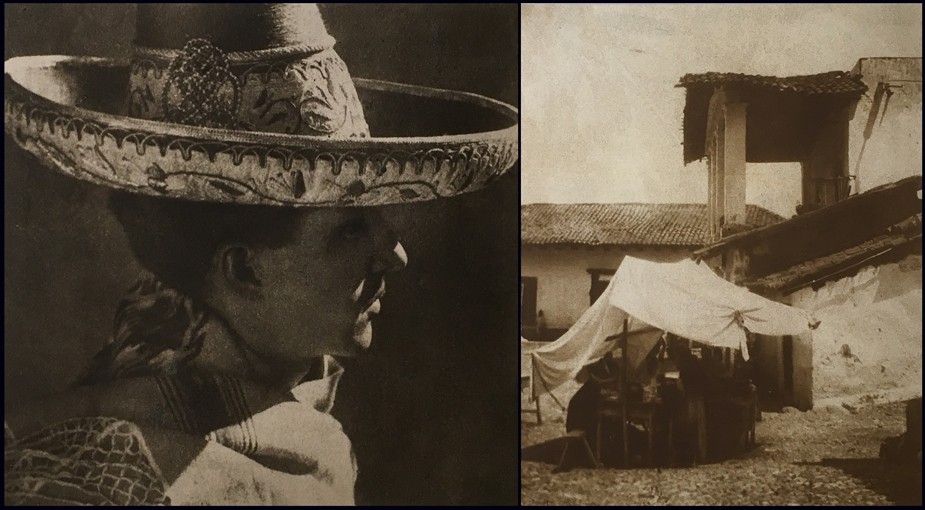 Left: “Mexican Peon”: Henry Ravell, American: 1864-1930. Vintage gum print ca. 1900-15. Alternately titled “A Mexican Peon” as listed in the catalogue of a 1978 retrospective of the artist at the Museum of Wayne County History, although an uncropped variant titled “Mexican Charro” (Mexican Cowboy)- is a more accurate description based on his fancily embroidered sombrero- is held by the California Museum of Photography, Riverside. Right: “Eating Tent-Taxco, Mexico”: Henry Ravell, American: 1864-1930. Vintage gum print ca. 1900-15. These photographs are part of a grouping of 18 singular gum prints featuring Mexican scenes and subjects held in the collection of the Museum of Wayne County History, Lyons N.Y.
Left: “Mexican Peon”: Henry Ravell, American: 1864-1930. Vintage gum print ca. 1900-15. Alternately titled “A Mexican Peon” as listed in the catalogue of a 1978 retrospective of the artist at the Museum of Wayne County History, although an uncropped variant titled “Mexican Charro” (Mexican Cowboy)- is a more accurate description based on his fancily embroidered sombrero- is held by the California Museum of Photography, Riverside. Right: “Eating Tent-Taxco, Mexico”: Henry Ravell, American: 1864-1930. Vintage gum print ca. 1900-15. These photographs are part of a grouping of 18 singular gum prints featuring Mexican scenes and subjects held in the collection of the Museum of Wayne County History, Lyons N.Y.
Henry perfected the gum bichromate process to a very high level. Probably in 1906-07, he began experimenting in multiple color gum. In Germany, around this same time, similar examples were being done by the brothers Theodor (1868-1943) and Oscar Hofmeister, (1871-1937) as well as Heinrich Wilhelm Müller (1859-1933) (3.) The following quote in the December,1908 issue of Boston’s Photo-Era encapsulates the admiration these gum prints received:
“It will be remembered that last summer Henry Ravell, of Mexico, exhibited in New York and Boston his results in multiple gum-bichromate printing in color. They excited considerable interest at the time, especially among our painters, who were very cordial in their praise of Mr. Ravell’s beautiful work, for it showed, in an eminent degree, the artistic possibilities of the gum-process.” (p. 300)
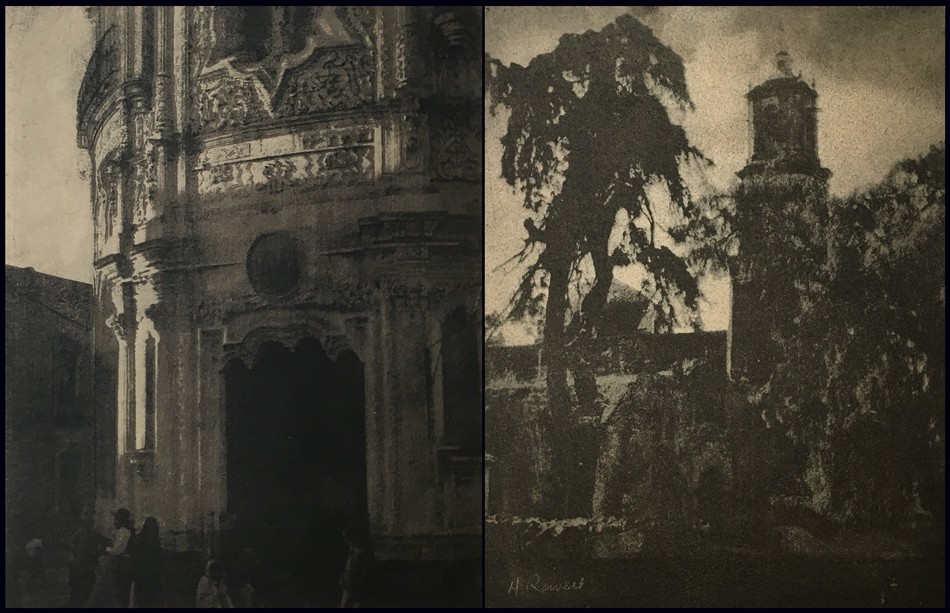 Left: “Chapel of the Holy Well near Mexico City”: Henry Ravell, American: 1864-1930. Vintage gum print ca. 1900-15. Right: “Church, Mexico”: Henry Ravell, American: 1864-1930. Vintage gum print ca. 1900-15. Museum of Wayne County History accession #Pi 176p with verso sticker additionally listing number 2 and $5.00) Featuring church architecture, these are part of a grouping of 18 singular gum prints of Mexican scenes and subjects held in the collection of the Museum of Wayne County History, Lyons N.Y.
Left: “Chapel of the Holy Well near Mexico City”: Henry Ravell, American: 1864-1930. Vintage gum print ca. 1900-15. Right: “Church, Mexico”: Henry Ravell, American: 1864-1930. Vintage gum print ca. 1900-15. Museum of Wayne County History accession #Pi 176p with verso sticker additionally listing number 2 and $5.00) Featuring church architecture, these are part of a grouping of 18 singular gum prints of Mexican scenes and subjects held in the collection of the Museum of Wayne County History, Lyons N.Y.
Again writing in 1940, Florence wrote of her younger brother: “but his favorite work was photography, and the gum print process. This process was original with an Austrian who refused to make it known, but Henry experimented until he developed it, and later gave the formula to the world.” The conjecture of this website is the possibility Henry originally gleaned and modified his own multiple gum color process from the earlier work of Austrian photographer Heinrich Kühn. (1866-1944) An 1897 example of a three-color gum print by him can be found in the collection of the Museum für Kunst und Gewerbe in Hamburg Germany.
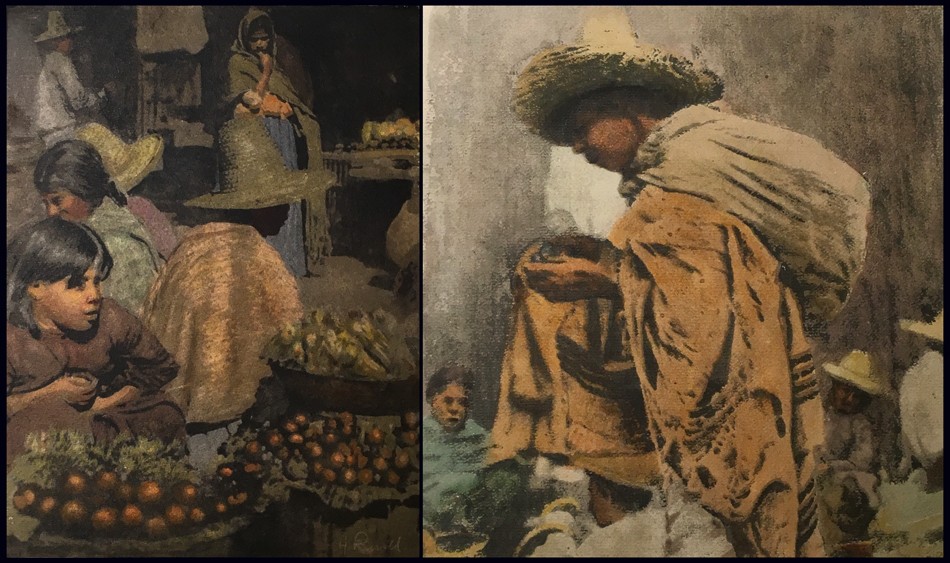 Left: “Mexican Vegetable Seller”: Henry Ravell, American: 1864-1930. Vintage multiple color gum print c. 1907-14. Right: “Mexican Youth”: Henry Ravell, American: 1864-1930. Vintage multiple color gum print c. 1907-14. These are two of the three rare multiple color gum prints by Henry Ravell held in the collection of the Museum of Wayne County History, Lyons N.Y.
Left: “Mexican Vegetable Seller”: Henry Ravell, American: 1864-1930. Vintage multiple color gum print c. 1907-14. Right: “Mexican Youth”: Henry Ravell, American: 1864-1930. Vintage multiple color gum print c. 1907-14. These are two of the three rare multiple color gum prints by Henry Ravell held in the collection of the Museum of Wayne County History, Lyons N.Y.
In 1908, Henry’s champion Lockwood de Forest gave a fuller explanation of the technical details for this color process, as part of copy included with a series of Mexican Church studies published in the May issue of the Century Illustrated Monthly Magazine:
“Last summer he started experiments in color-printing. His process is simple. Instead of introducing colors on the negatives, as in the lumière process, he is using the colors in the sensitizer of the printing paper. The specimens he has sent me are printed in three or four colors. Each print is finished, recoated all over with the sensitizer with the next color, and again printed. This is done for each color separately, the black print coming last, as in the regular color-printing process.”
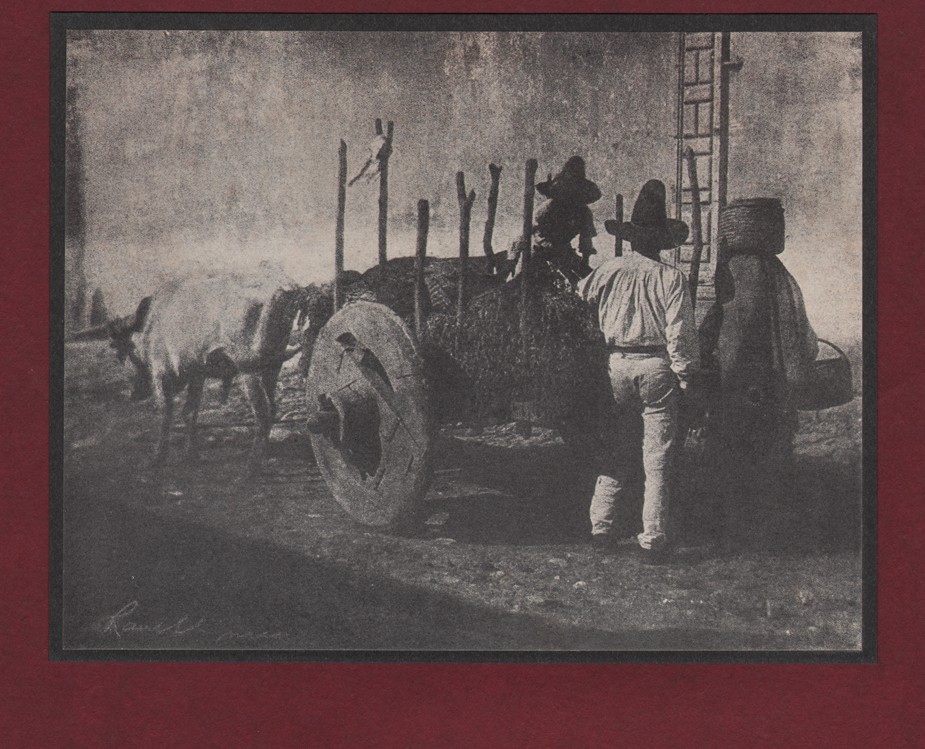 “An Ox Cart” (Mexico): Henry Ravell, American: 1864-1930. 1905: Vintage halftone tipped to mount: 16.6 x 21.4 | 17.4 x 22.2 | 45.0 x 30.5 cm “This mount is Sultan Bokhara and Royal Melton Egyptine Made by the Niagara Paper Mills”. Taken in Mexico ca. 1900-05, this is one of the earliest published examples of a Ravell photograph to appear in the popular press. It was included in the luxury portfolio publication “Art in Photography” issued by the Photo Era Publishing Company of Boston. From: PhotoSeed Archive
“An Ox Cart” (Mexico): Henry Ravell, American: 1864-1930. 1905: Vintage halftone tipped to mount: 16.6 x 21.4 | 17.4 x 22.2 | 45.0 x 30.5 cm “This mount is Sultan Bokhara and Royal Melton Egyptine Made by the Niagara Paper Mills”. Taken in Mexico ca. 1900-05, this is one of the earliest published examples of a Ravell photograph to appear in the popular press. It was included in the luxury portfolio publication “Art in Photography” issued by the Photo Era Publishing Company of Boston. From: PhotoSeed Archive
Ravell continued to work in Mexico until about 1914, when it is believed he moved back to the Los Angeles area of California in order to escape the Civil War (Mexican Revolution) then engulfing the country. A short biography included in the 1978 volume Pictorial Photography in Britain 1900-1920 gives 1916 as a slightly later date, although it was likely he was traveling back and forth from Mexico to the U.S. several times during this tumultuous time:
“In 1916 an article entitled “Cathedrals of Mexico”, illustrated by his work, was published in Harper’s magazine. About this time he left Mexico, almost as a refugee. His studio in Cuernavaca was destroyed by rebels. He moved to California where he began to photograph near Carmel and settled at Santa Barbara.”
Now that this American born “refugee” was back in his home country for good, he immediately set out photographing the beauty of the southern California coastline, with an emphasis on capturing the numerous entanglements of old cypress trees set against the landscape and Pacific Ocean. Conveniently, and perhaps not coincidentally, Lockwood de Forest had moved permanently to Santa Barbara in 1915 after wintering in the area since 1902, with his professional connections to the world of art giving Henry and his work credibility and entrance to a larger audience. These included retrospective exhibitions of nearly 100 framed works of his Mexican and California subjects at major American institutions. These began in October, 1918 at the Pratt Institute Art Gallery in Brooklyn and continued into 1919 at the Albright Art Gallery in Buffalo, New York followed by shows the same year at the newly opened Cleveland Museum of Art and then at the Chicago Art Institute.
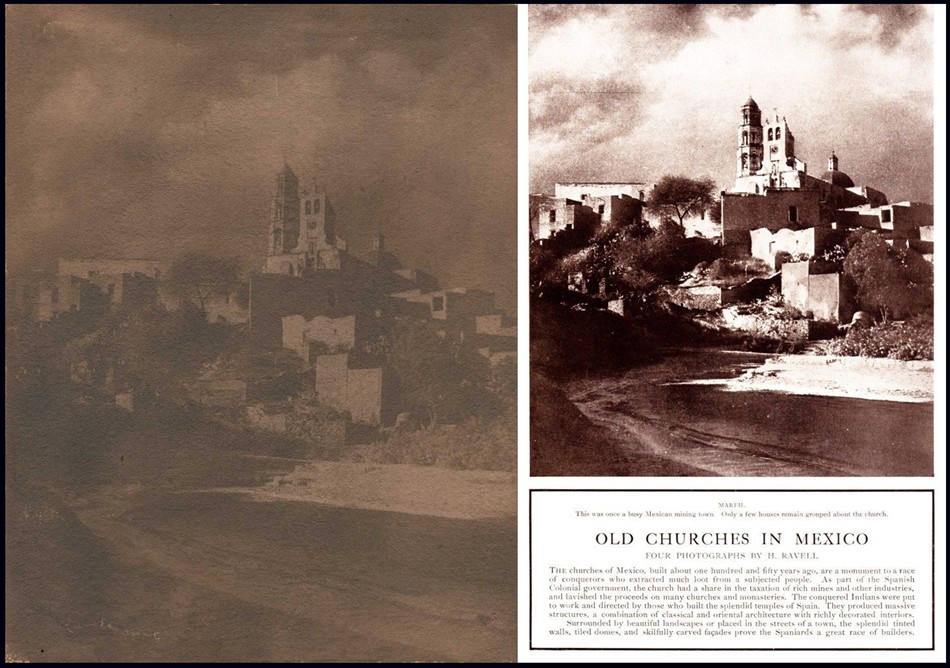 Left: “Marfil: Templo De Marfil De Arriba”: Henry Ravell, American: 1864-1930. Vintage gum print c. 1900-10: 37.4 x 29.0 cm. Still standing today, this church constructed in the Baroque style is located in Marfil, a suburb of the central Mexican city of Guanajuato. The church is colloquially known as “La Iglesia de Arriba”, or the “Church up Top”. From: PhotoSeed Archive Right: Four photographs of Mexican churches by Henry Ravell, including the Templo De Marfil De Arriba photograph, were published in the February, 1914 issue of Century Magazine for a picture spread titled “Old Churches in Mexico”: “The churches of Mexico, built about one hundred and fifty years ago, are a monument to a race of conquerors who extracted much loot from a subjected people. As part of the Spanish Colonial government, the church had a share in the taxation of rich mines and other industries, and lavished the proceeds on many churches and monasteries. The conquered Indians were put to work and directed by those who built the splendid temples of Spain. They produced massive structures, a combination of classical and oriental architecture with richly decorated interiors. Surrounded by beautiful landscapes or placed in the streets of a town, the splendid tinted walls, tiled domes, and skilfully carved facades prove the Spaniards a great race of builders.” From: Internet Archive
Left: “Marfil: Templo De Marfil De Arriba”: Henry Ravell, American: 1864-1930. Vintage gum print c. 1900-10: 37.4 x 29.0 cm. Still standing today, this church constructed in the Baroque style is located in Marfil, a suburb of the central Mexican city of Guanajuato. The church is colloquially known as “La Iglesia de Arriba”, or the “Church up Top”. From: PhotoSeed Archive Right: Four photographs of Mexican churches by Henry Ravell, including the Templo De Marfil De Arriba photograph, were published in the February, 1914 issue of Century Magazine for a picture spread titled “Old Churches in Mexico”: “The churches of Mexico, built about one hundred and fifty years ago, are a monument to a race of conquerors who extracted much loot from a subjected people. As part of the Spanish Colonial government, the church had a share in the taxation of rich mines and other industries, and lavished the proceeds on many churches and monasteries. The conquered Indians were put to work and directed by those who built the splendid temples of Spain. They produced massive structures, a combination of classical and oriental architecture with richly decorated interiors. Surrounded by beautiful landscapes or placed in the streets of a town, the splendid tinted walls, tiled domes, and skilfully carved facades prove the Spaniards a great race of builders.” From: Internet Archive
Henry Ravell would continue to exhibit his work late into the 1920’s at smaller venues, one example being a tri-colored gum print titled “Mexican Peon Boy” shown at the 1927 Los Angeles Salon and remarked on by Camera Craft, his gum prints deemed “for which he has gained a warranted renown”. Gum printing was indeed so important to the artist that he listed “Gum Printer” as his occupation for the 1920 U.S. Census.
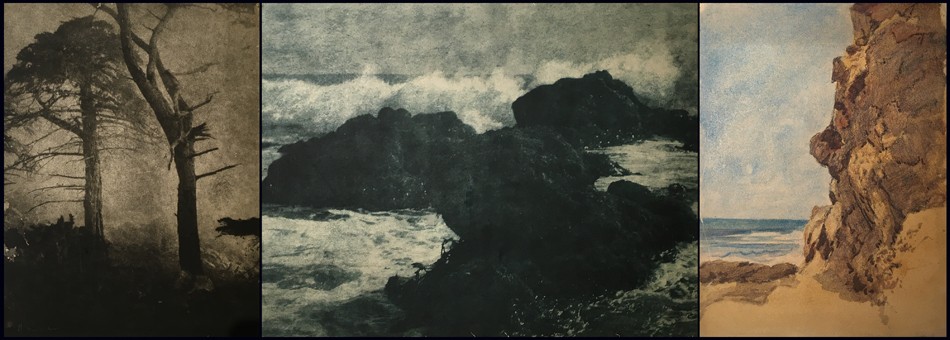 Left: “Pine and Cypress, Pebble Beach”: Henry Ravell, American: 1864-1930. Vintage gum print ca. 1915-20. (Museum of Wayne County History accession #Pi 176a with verso sticker additionally listing number 17 and $3.00) Middle: “Big Splash” (California coastline) Henry Ravell, American: 1864-1930. Vintage gum print ca. 1915-20. (Museum of Wayne County History accession #Pi 176m with verso sticker additionally listing number 122 and $12.00) Right: “Untitled Marine Landscape” (Mexico or California): Henry Ravell, American: 1864-1930. Vintage multiple colored gum print ca. 1907-1920. (Museum of Wayne County History accession #Pi 176n with verso sticker additionally listing number 156 ) All: Courtesy Museum of Wayne County History, Lyons N.Y.
Left: “Pine and Cypress, Pebble Beach”: Henry Ravell, American: 1864-1930. Vintage gum print ca. 1915-20. (Museum of Wayne County History accession #Pi 176a with verso sticker additionally listing number 17 and $3.00) Middle: “Big Splash” (California coastline) Henry Ravell, American: 1864-1930. Vintage gum print ca. 1915-20. (Museum of Wayne County History accession #Pi 176m with verso sticker additionally listing number 122 and $12.00) Right: “Untitled Marine Landscape” (Mexico or California): Henry Ravell, American: 1864-1930. Vintage multiple colored gum print ca. 1907-1920. (Museum of Wayne County History accession #Pi 176n with verso sticker additionally listing number 156 ) All: Courtesy Museum of Wayne County History, Lyons N.Y.
The Albright Art Gallery was an important venue for Ravell’s work, considering the groundbreaking exhibition it previously hosted in November, 1910: the International Exhibition of Pictorial Photography. Organized by the Photo-Secession under the direction of Alfred Stieglitz, it was “the first exhibition held at an American museum that aimed to elevate photography’s stature from a purely scientific pursuit to a visual form of artistic expression.” Even nine years later, in 1919, at a time when museum shows devoted to the work of a singular photographer anywhere in the world were still few and far between and remained so decades later, it’s refreshing in the present to read observations by one curator remarking on Ravell’s 93 framed photographs displayed at the Albright gallery for Academy Notes, the mouthpiece for The Buffalo Fine Arts Academy:
“THE collection of photographs by H. Ravell—which was on view in the gallery during the last week in February and all of March—is very unique and valuable. These photographs are technically known as gum-prints and have all the painter’s quality in their execution. They do not impress one as photographs but rather as work directly from the artist’s brush. The photographs were made by H. Ravell who is now in Santa Barbara. Many of the pictures were taken near Carmel, California, a seashore of much variety where the fantastic cypress trees with their twisted dramatic forms produce wonderful compositions against sea and sky.” …This is but a short description of the remarkable exhibition of photographs shown at the Albright Art Gallery. It was seen by many art lovers and appreciated especially by all of those interested in artistic photography.” (4.)
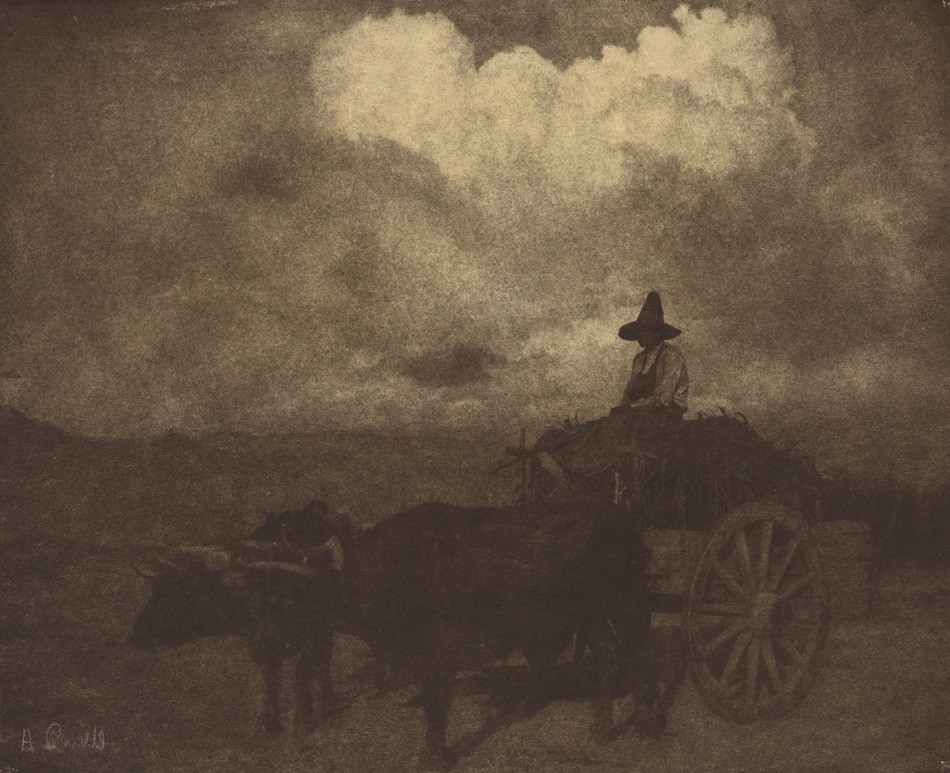 “Ox Cart- Sunset”: Henry Ravell, American: 1864-1930. Vintage gum print ca. 1900-10. Image: 27.0 x 32.6 cm presented loose within dark brown paper folder with overall support dimensions of 58.8 x 36.7 cm. Wearing a traditional sombrero hat, (Sombrero de charro) the driver of this ox or bullock cart pauses atop a full load of what looks like hay or silage. This Mexican scene may date to around 1905-consistent with a different view by the artist of an ox cart published that year in “Art in Photography” by the the Photo Era Publishing Company of Boston. From: PhotoSeed Archive
“Ox Cart- Sunset”: Henry Ravell, American: 1864-1930. Vintage gum print ca. 1900-10. Image: 27.0 x 32.6 cm presented loose within dark brown paper folder with overall support dimensions of 58.8 x 36.7 cm. Wearing a traditional sombrero hat, (Sombrero de charro) the driver of this ox or bullock cart pauses atop a full load of what looks like hay or silage. This Mexican scene may date to around 1905-consistent with a different view by the artist of an ox cart published that year in “Art in Photography” by the the Photo Era Publishing Company of Boston. From: PhotoSeed Archive
A reevaluation of Henry Ravell’s body of work is important to consider in the present given the broad acknowledgement of his talent by major institutions and the popular press for the benefit of many large audiences over 100 years ago. An important pictorialist photographer who was also a painter, Henry Ravell was a striver and apprentice graduate inspired by his father’s steady trade in the New York state village of Lyons who embraced a love for craft and mastery of art. Together, these skills gave him the passion to embrace adventure in capturing the beauty in far-off Mexico and southern California for the ages.
Four original gum prints in the PhotoSeed Archive can be seen here, each listing an expanded biography, timeline and major institutional holdings for the artist.
Afterword | Notes
A conundrum on internet research into Henry Ravell’s artistic output reveals itself quickly. The bottom line is that most every painting on the web attributed to Henry Ravell the photographer is not by him. Instead, through PhotoSeed’s research and purchase of the small painting: “The Ripers”, (The Reapers) the true identity of this artist can now be revealed as Henry Etienne Ravel. (1872-1962) Born in Naples Italy to French citizens, Henry Ravel immigrated to America in 1906 and became a naturalized US citizen in 1920. A transportation clerk by trade in the early 1920’s, his paintings- many done in Europe- date from ca. 1930’s-1950’s. What causes the confusion is that like Henry Ravell the photographer, who signed his photographs “H. Ravell”, Henry Ravel the painter also signed his work similarly, but as “H. Ravel” Numerous examples of his paintings show up on Google searches-unlike the real and quite rare examples of watercolors done by Ravell the photographer. I’ve included links to some of these paintings on the page showing “The Ripers”. As always- buyer beware and do your homework!
1. C. Ravel won a $3.00 premium for “Best Daguerreotypes” during the Annual Fair of the Madison County Agricultural Society held at Morrisville, (N.Y.) on the 15th, 16th and 17th days of September,1857 according to a newspaper account in the Cazenovia Republican. Shout out to the Pioneer American Photographers 1839-1860 website. Langdon’s List of 19th & Early 20th Century Photographers additionally list Ravel working in Manlius, New York in the 1859 N.Y. State Business Directory.
2. See: The Lyons Republican & Clyde Times: Lyons, N.Y. Thursday, March 21, 1940. Article excerpts: HENRY RAVELL: “Resided in Lyons for twenty-eight years, died in Los Angeles California, January 20, 1930. This account was written by his sister, Mrs. Florence Ravell Lothrop, of 721 Fifth Street North, St. Petersburg, Florida.: “Henry had no special training in any school or under any masters except my father, Charles Herring Ravel, who was born in Boston, England, and became one of the first photographers in the United States. His forbears came over with William the Conqueror to England, which accounts for the one “L” in the name. My mother was annoyed because most people called her Mrs. Rav’-el and persuaded my father to add “L”, so the family adopted that spelling of our name.…Henry studied and experimented all his life. His photographic subjects were portraits, landscapes, street scenes, trees, cloud and moonlight effects. His Mexican Cathedrals were especially noteworthy. He used both oils and water colors, but his favorite work was photography, and the gum print process. This process was original with an Austrian who refused to make it known, but Henry experimented until he developed it, and later gave the formula to the world. I remember seeing around his studio, pans of water about three inches deep. The photo-print was put into the water and pigments of paint dropped on it, this gave the effect when completed of a soft beautiful painting. My description to an artist will seem crude but that is as I recall it.…Henry never taught, that is, acted as a teacher in any school, and I do not know what societies he belonged. He exhibited in the Pittsburgh, Pennsylvania, Salon about 1907. From the thousands of photographs submitted, three of his were among the 237 accepted. His work was exhibited at the Salmagundi Club, New York City; Thurber’s and Anderson’s Galleries in Chicago, Los Angeles, California, and many, many other places. Fifteen of his photographs are at the Metropolitan Museum, New York City. Seven are Mexican subjects and eight are California trees. These were selected by Forest Lockwood.(sic) After Henry’s death at Los Angeles, California, in 1930, a request came for him to send an exhibit to the Fifth International Photographic Salon of Japan held at Tokyo and Osaka in May, 1931.”
3. In the December, 1908 issue of Boston’s Photo-Era, a short article titled “Gum-Prints In Colors” appeared, linking Ravell’s gum prints as being similar to “a collection of prints by the same process, probably with modifications” to work done by the Hofmeister brothers and Müller. These German works were shown at the offices of The British Journal of Photography in London’s Strand from September 28- October 24, 1907.
4. See: Academy Notes: The Buffalo Fine Arts Academy: Albright Art Gallery: Buffalo, New York: vol. XIV: Jan.-Oct. 1919, p. 67
Earth Bowl
Posted April 2020 in Color Photography, New Additions
If for a moment we could look down and imagine our Earth fitting within a fish bowl, could we then realize the importance our fragile world depends on us all in feeding and caring for its’ survival? Please try. Today, join us in celebrating 50 years of Earth Day.
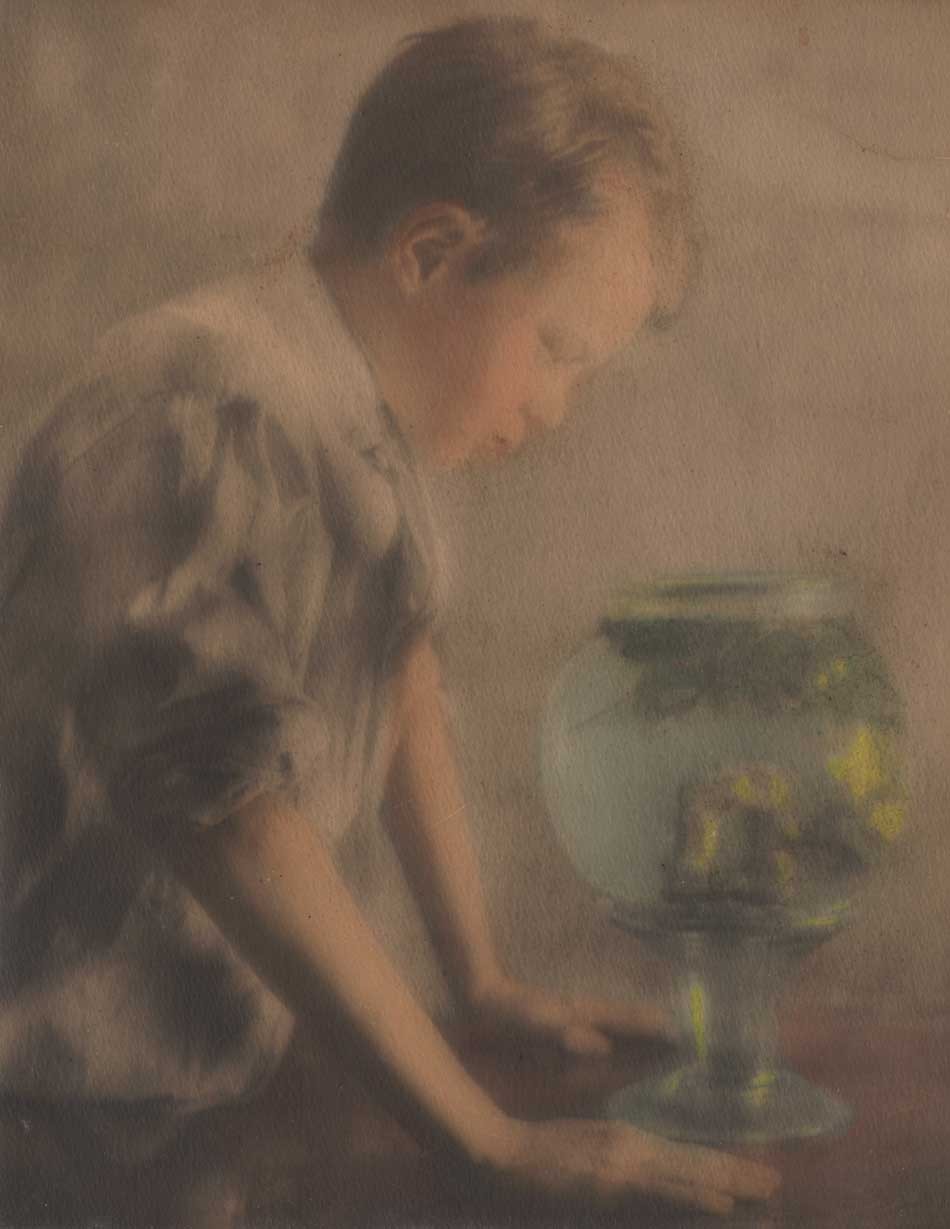 “Child Gazing in Fish Bowl”: attributed to Arthur Hammond, American: born England: 1880-1962: hand-colored gelatin silver print mounted to album leaf, ca. 1910-1920: 23.8 x 18.5 | 25.0 x 32.7 cm. From a personal album of nearly 100 photographs attributed to Hammond dating from around 1910-1940. Born in London, Hammond arrived in America at Ellis Island on July 31, 1909 and quickly established his own studio in Natick Massachusetts by 1912-joining and exhibiting with the nearby Boston Camera Club. By 1920, he had authored the foundational book "Pictorial Composition in Photography" and became a leading voice for pictorialism in America through his position as associate editor of American Photography magazine that lasted 30 years from 1918-1949. From: PhotoSeed Archive
“Child Gazing in Fish Bowl”: attributed to Arthur Hammond, American: born England: 1880-1962: hand-colored gelatin silver print mounted to album leaf, ca. 1910-1920: 23.8 x 18.5 | 25.0 x 32.7 cm. From a personal album of nearly 100 photographs attributed to Hammond dating from around 1910-1940. Born in London, Hammond arrived in America at Ellis Island on July 31, 1909 and quickly established his own studio in Natick Massachusetts by 1912-joining and exhibiting with the nearby Boston Camera Club. By 1920, he had authored the foundational book "Pictorial Composition in Photography" and became a leading voice for pictorialism in America through his position as associate editor of American Photography magazine that lasted 30 years from 1918-1949. From: PhotoSeed ArchiveBlue Christmas
Posted December 2019 in Alternate Processes, Color Photography, New Additions
⎯ And when the blue snowflakes start falling
That’s when those blue memories start calling
You’ll be doing alright with your Christmas of white,
But I’ll have a blue blue Christmas ✻
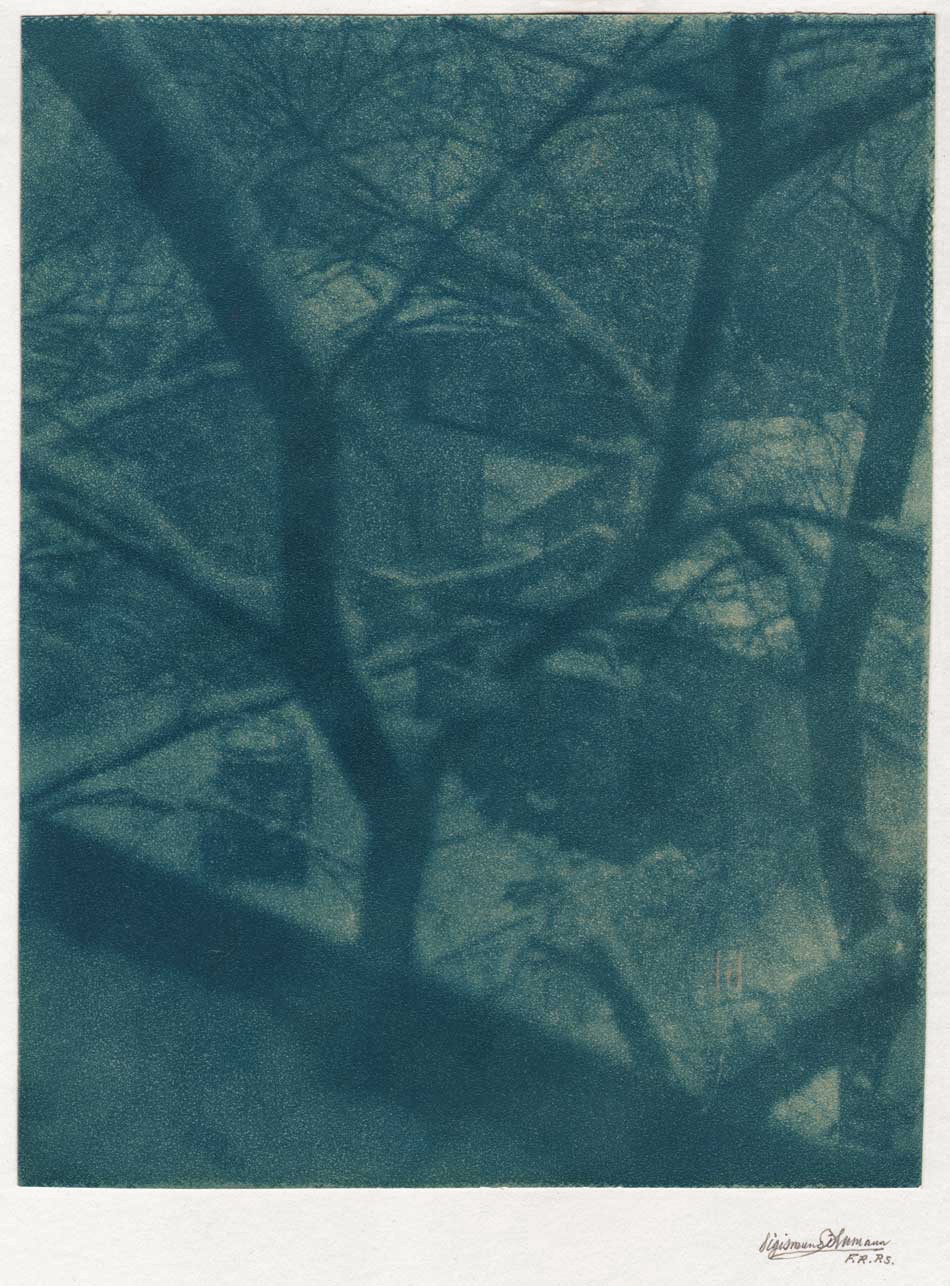 “Christmas Night from an Attic Window”: Sigismund Blumann, American: (1872–1956). Vintage “Lithobrome” (Bromoil transfer) print ca. 1932 or later; 23.6 x 18.3 | 43.3 x 33.0 cm. Photographed from above through tree limbs supporting several inches of snow, this rare wintertime view by noted California pictorialist photographer Sigismund Blumann (1872–1956) shows a home courtyard with parked automobile seen through limbs at lower left. Most likely dating to the late 1920’s, this example printed 1932 or later due to Blumann’s inclusion of his F.R.P.S. affiliation (the year he earned Fellowship in the Royal Photographic Society) within the lower right corner of the primary matt’s impressed window. From: PhotoSeed Archive
“Christmas Night from an Attic Window”: Sigismund Blumann, American: (1872–1956). Vintage “Lithobrome” (Bromoil transfer) print ca. 1932 or later; 23.6 x 18.3 | 43.3 x 33.0 cm. Photographed from above through tree limbs supporting several inches of snow, this rare wintertime view by noted California pictorialist photographer Sigismund Blumann (1872–1956) shows a home courtyard with parked automobile seen through limbs at lower left. Most likely dating to the late 1920’s, this example printed 1932 or later due to Blumann’s inclusion of his F.R.P.S. affiliation (the year he earned Fellowship in the Royal Photographic Society) within the lower right corner of the primary matt’s impressed window. From: PhotoSeed Archive
✻ (lyrics by Billy Hayes & Jay W. Johnson made famous by Elvis Presley on his first Christmas album released in October, 1957)
Summer Streams Wide & Small
Posted June 2019 in Alternate Processes, Childhood Photography, Color Photography, Documentary Photography, Journals, New Additions, Painters|Photographers, Scientific Photography, Significant Photographers, Significant Photographs, Unknown Photographers
Herein a summer interlude, if you will, of still, trickling and gushing streams from years past. And if they inspire and beckon for the present, find your own peace or wonderment in the mountains, valleys or pastures of summer wherever your own stream flows.
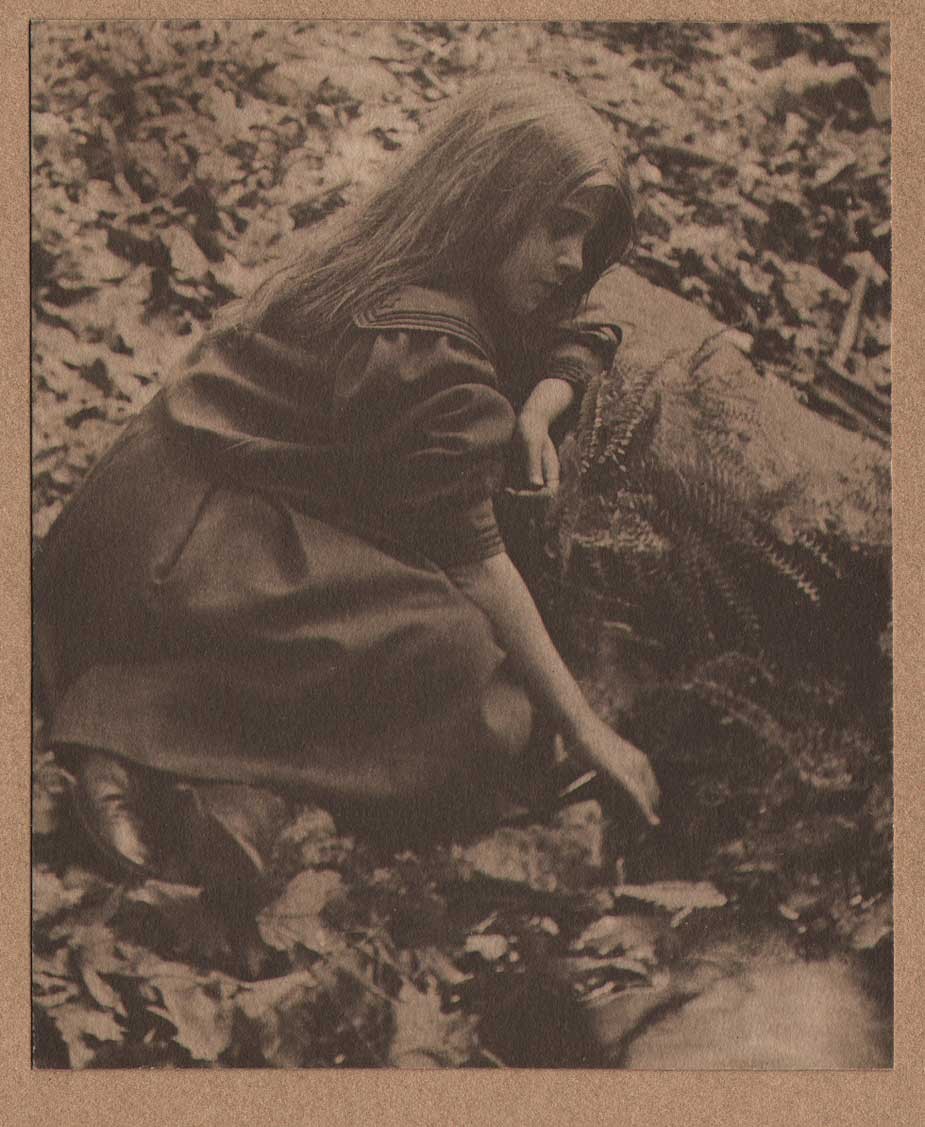 “Dorothy Tucker Gathering Ferns”: Charles Rollins Tucker, American (b. 1868): ca. 1910: mounted brown-toned platinum print: 9.4 x 7.7 cm | 31.2 x 16.0 cm. Born in August, 1899, Dorothy Tucker, a constant photographic subject for her father, then a high school physics teacher at Curtis High School on Staten Island, New York state, holds a spray of freshly-picked ferns while investigating the edge of a stream in the woods. From: PhotoSeed Archive
“Dorothy Tucker Gathering Ferns”: Charles Rollins Tucker, American (b. 1868): ca. 1910: mounted brown-toned platinum print: 9.4 x 7.7 cm | 31.2 x 16.0 cm. Born in August, 1899, Dorothy Tucker, a constant photographic subject for her father, then a high school physics teacher at Curtis High School on Staten Island, New York state, holds a spray of freshly-picked ferns while investigating the edge of a stream in the woods. From: PhotoSeed Archive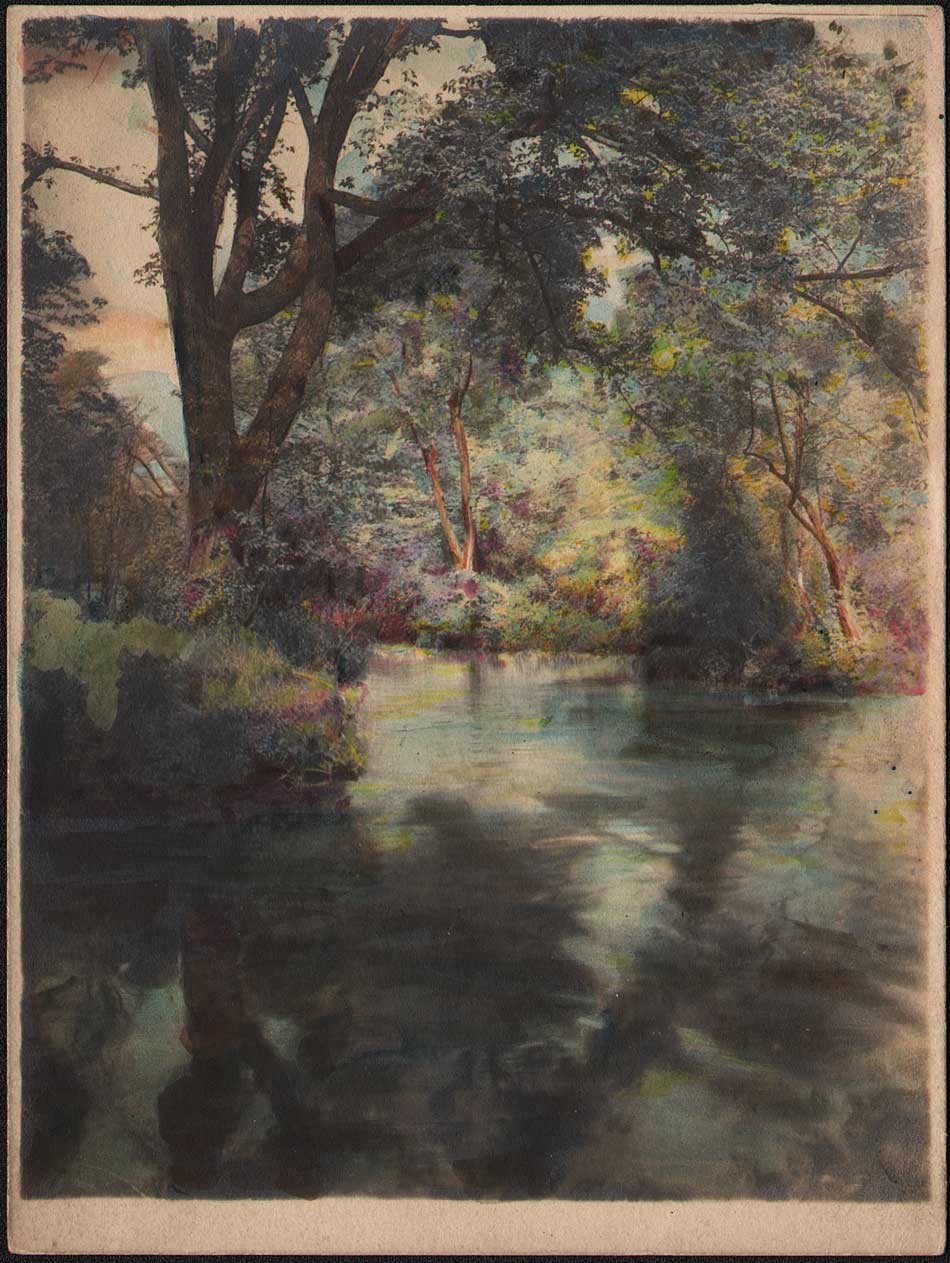 “Stream or Pond at Prospect Park"(Brooklyn, New York): ca. 1910-20: Unknown Brooklyn photographer: hand-colored gelatin silver print: 11.7 x 8.9 cm | 12.4 x 9.3 cm: From: PhotoSeed Archive
“Stream or Pond at Prospect Park"(Brooklyn, New York): ca. 1910-20: Unknown Brooklyn photographer: hand-colored gelatin silver print: 11.7 x 8.9 cm | 12.4 x 9.3 cm: From: PhotoSeed Archive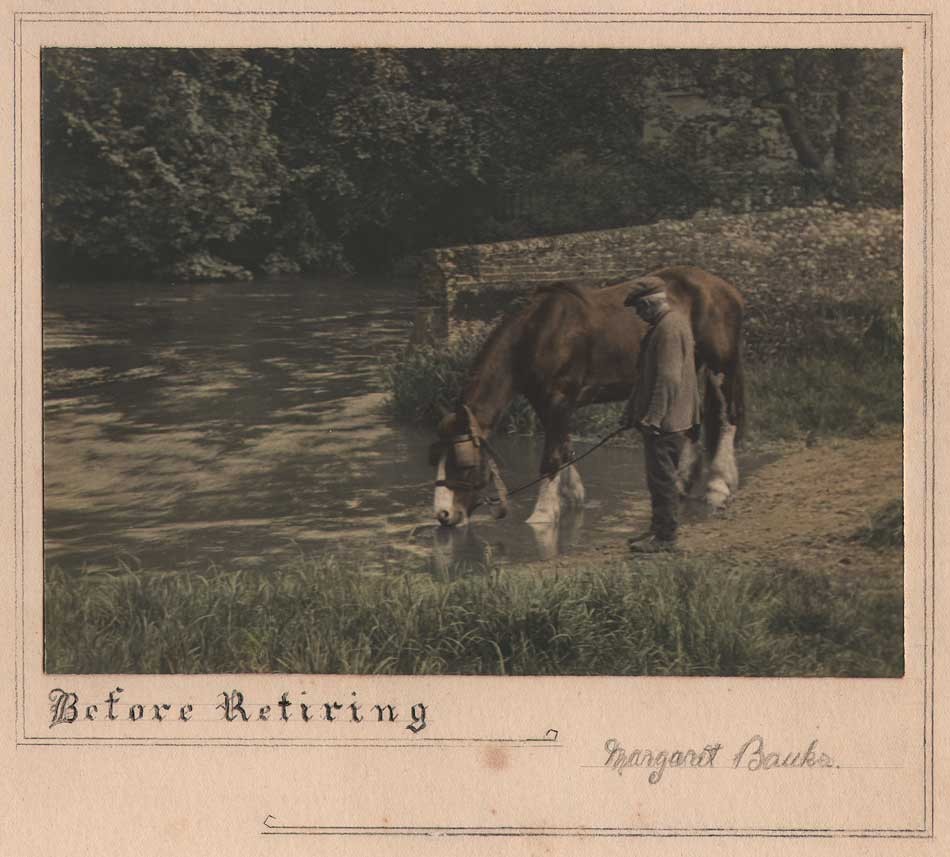 “Before Retiring”: ca. 1910-20: Margaret Bauks, British- (possibly Margaret Florence Bauks: b. 1872?) : hand-colored gelatin silver print: 11.6 x 15.9 cm | 27.8 x 22.8 cm: From: PhotoSeed Archive
“Before Retiring”: ca. 1910-20: Margaret Bauks, British- (possibly Margaret Florence Bauks: b. 1872?) : hand-colored gelatin silver print: 11.6 x 15.9 cm | 27.8 x 22.8 cm: From: PhotoSeed Archive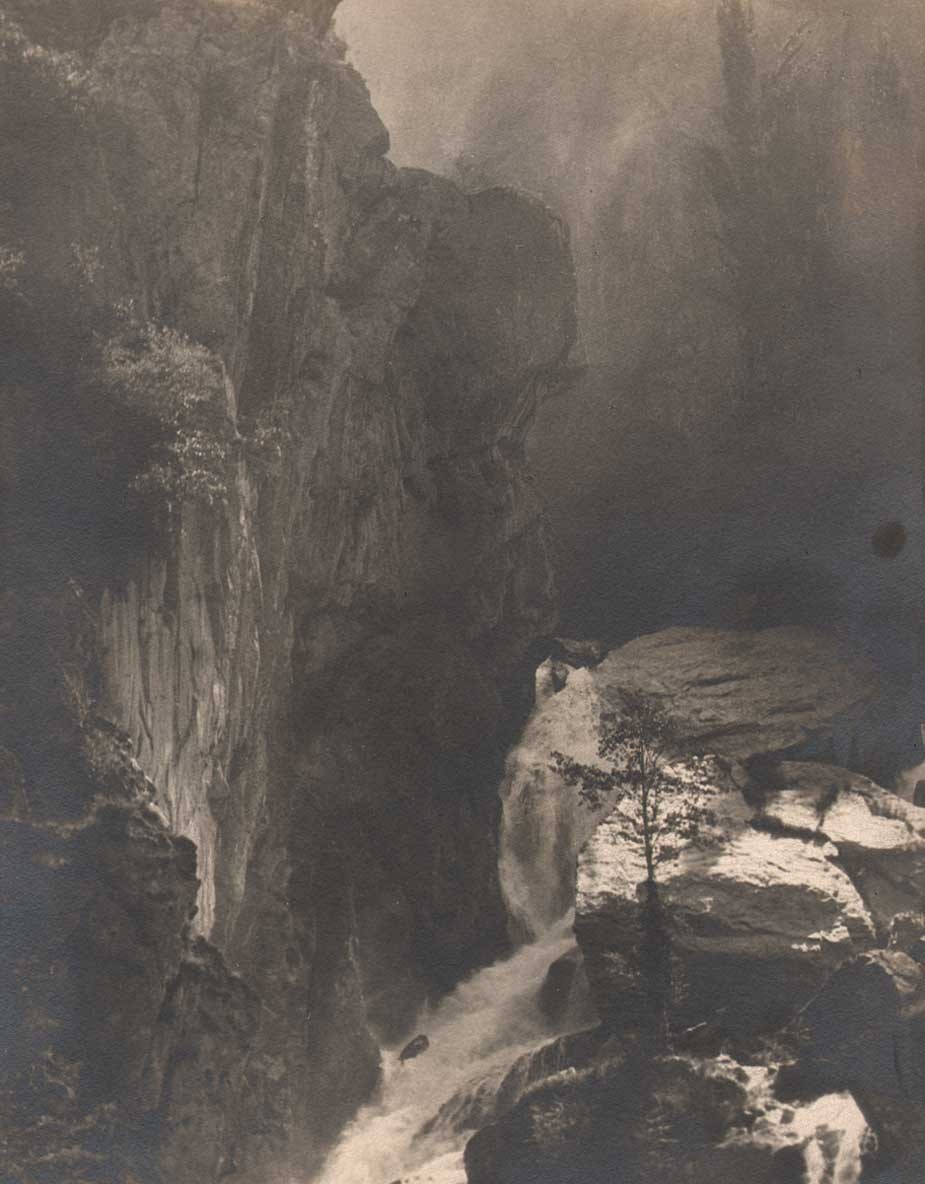 “A Stream of Savoy”: ca. 1927: this print exhibited 1935: Frank Roy Fraprie, American (1874-1951): vintage Bromide print: 24.0 x 18.6 cm | 30.5 x 25.4 cm: As noted in the 1946 American Annual of Photography, (p. 170) Fraprie had been taking photographs in June of 1926 in Eastern France. The area, located in the Haute-Savoie, or Upper Savoy, is a mountainous region of spectacular beauty which includes Lake Annecy, one of France’s largest freshwater lakes. Photographic historian Christian Peterson’s biography of Fraprie gives some background on this important photographer and editor: “Fraprie was the most influential author/publisher of American pictorial photography during the period following the Photo-Secession. From the 1910s to the 1940s, he wrote books and countless articles on all aspects of pictorialism. He edited photographic monthlies and annuals for nearly the entire first half of the twentieth century. In addition, he created his own highly successful pictorial photographs and exhibited them extensively.” From: PhotoSeed Archive
“A Stream of Savoy”: ca. 1927: this print exhibited 1935: Frank Roy Fraprie, American (1874-1951): vintage Bromide print: 24.0 x 18.6 cm | 30.5 x 25.4 cm: As noted in the 1946 American Annual of Photography, (p. 170) Fraprie had been taking photographs in June of 1926 in Eastern France. The area, located in the Haute-Savoie, or Upper Savoy, is a mountainous region of spectacular beauty which includes Lake Annecy, one of France’s largest freshwater lakes. Photographic historian Christian Peterson’s biography of Fraprie gives some background on this important photographer and editor: “Fraprie was the most influential author/publisher of American pictorial photography during the period following the Photo-Secession. From the 1910s to the 1940s, he wrote books and countless articles on all aspects of pictorialism. He edited photographic monthlies and annuals for nearly the entire first half of the twentieth century. In addition, he created his own highly successful pictorial photographs and exhibited them extensively.” From: PhotoSeed Archive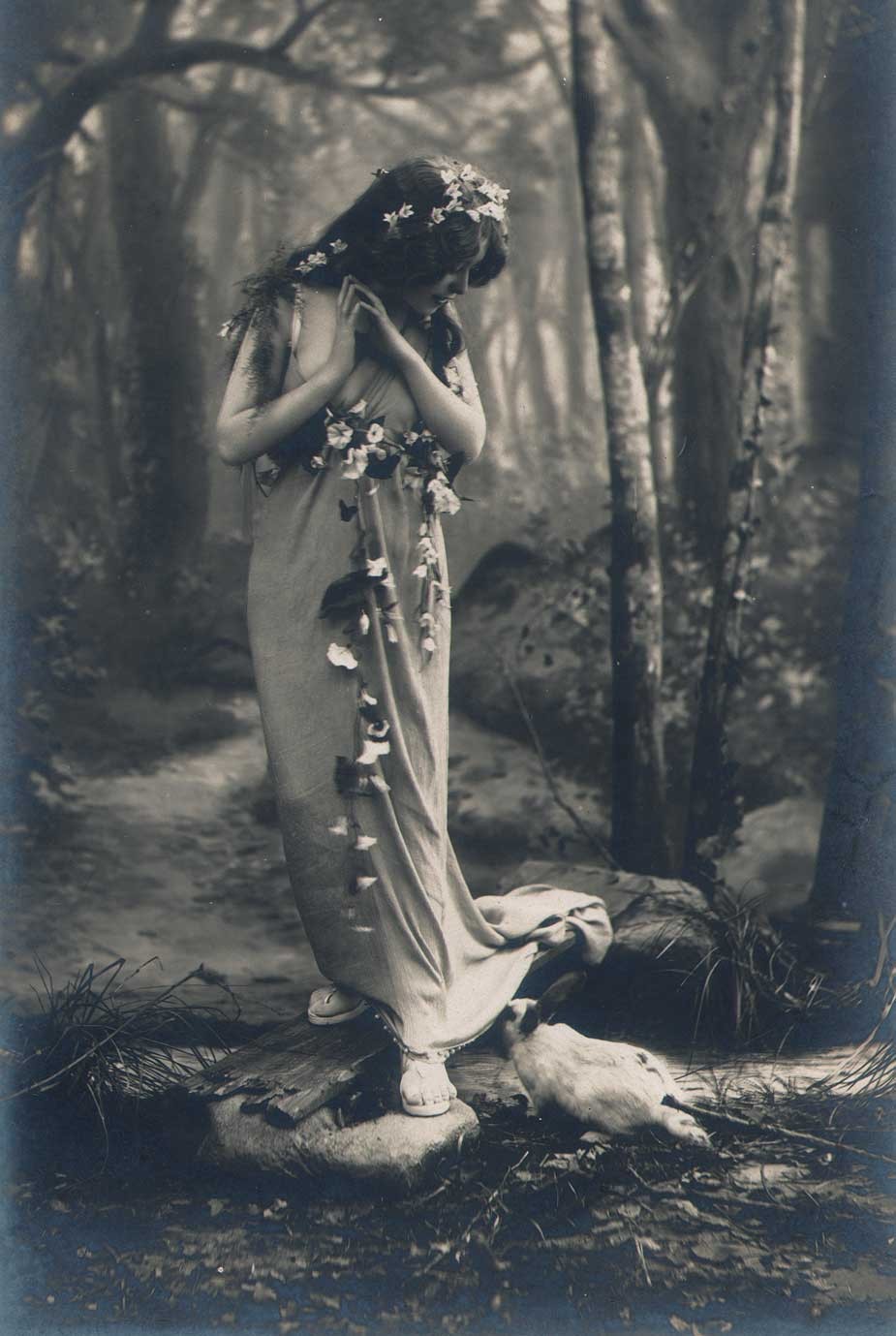 Detail: “Les Fleurs Dans Le Bois” : Léopold-Émile Reutlinger: French (1863-1937): vintage Bromide photograph, ca. 1905. 22.3 x 14.1 | 34.0 x 24.2 cm. Featuring a painted backdrop and wood board placed over a “stream”, this studio photograph features a white rabbit investigating the Belle Epoque era model identified from other variants as “Miss Doll”.(proper identification of this model would be of interest as she has remained a popular subject seen in countless vintage postcards, many hand-tinted) This example was printed by the Milan atelier Maison Tensi and included as a full-page plate in the February, 1905 issue of “La Fotographia Artistica”, a French/Italian photographic journal. From: PhotoSeed Archive
Detail: “Les Fleurs Dans Le Bois” : Léopold-Émile Reutlinger: French (1863-1937): vintage Bromide photograph, ca. 1905. 22.3 x 14.1 | 34.0 x 24.2 cm. Featuring a painted backdrop and wood board placed over a “stream”, this studio photograph features a white rabbit investigating the Belle Epoque era model identified from other variants as “Miss Doll”.(proper identification of this model would be of interest as she has remained a popular subject seen in countless vintage postcards, many hand-tinted) This example was printed by the Milan atelier Maison Tensi and included as a full-page plate in the February, 1905 issue of “La Fotographia Artistica”, a French/Italian photographic journal. From: PhotoSeed Archive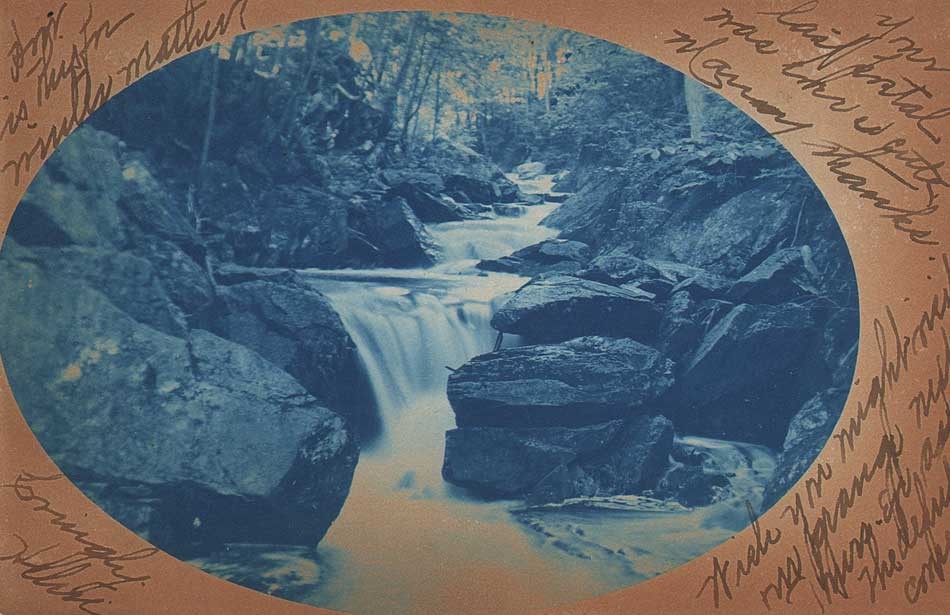 “A Rocky Brook” (New England?) : ca. 1906: Unknown American photographer: vintage cyanotype rppc: 8.9 x 13.8 cm. This idyllic cascading waterfall may depict the Minnewawa Glen in Marlborough, New Hampshire. Signed on the recto: “Lovingly Helen” in the lower left corner, it’s postmarked November 15, 1906 from Marlboro, N.H. addressed to Miss Nettie A. Hastings of East Sullivan, N.H. From: PhotoSeed Archive
“A Rocky Brook” (New England?) : ca. 1906: Unknown American photographer: vintage cyanotype rppc: 8.9 x 13.8 cm. This idyllic cascading waterfall may depict the Minnewawa Glen in Marlborough, New Hampshire. Signed on the recto: “Lovingly Helen” in the lower left corner, it’s postmarked November 15, 1906 from Marlboro, N.H. addressed to Miss Nettie A. Hastings of East Sullivan, N.H. From: PhotoSeed Archive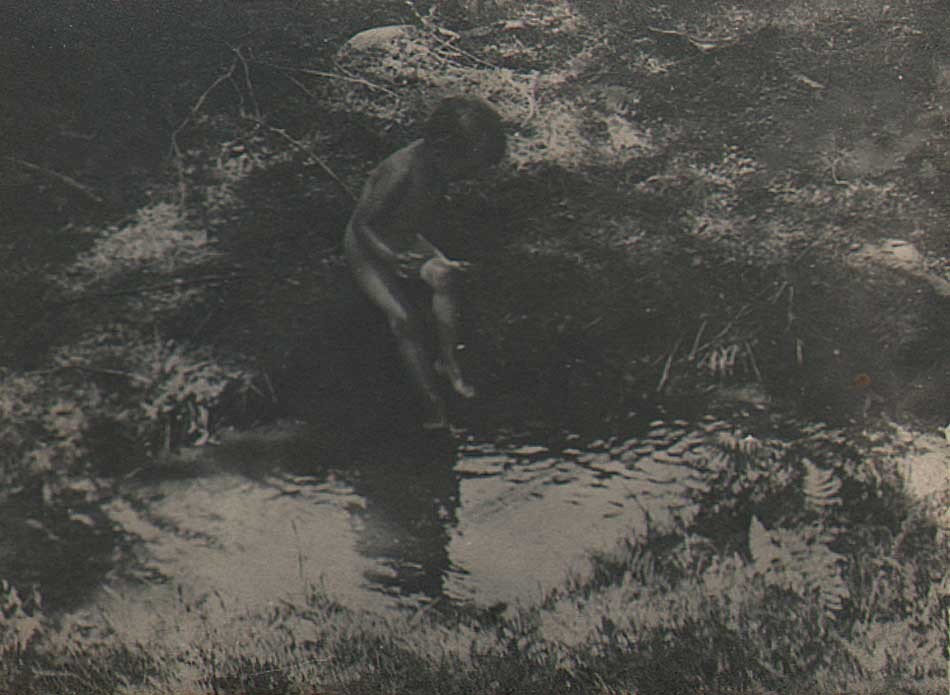 “John Robert Tucker Skinny Dipping”: Charles Rollins Tucker, American (b. 1868): ca. 1915: unmounted platinum print: 3.8 x 5.2 cm. Born in March, 1914, John Robert Tucker, was the second of three children born to the former Mary Carruthers and photographer Charles R. Tucker. Here, the young boy plays in a woodland stream, with the photograph most likely taken in New England. John, according to his 1941 marriage certificate, was an electrical engineer by training. He died in 1991 in La Habra, Orange County, CA. From: PhotoSeed Archive
“John Robert Tucker Skinny Dipping”: Charles Rollins Tucker, American (b. 1868): ca. 1915: unmounted platinum print: 3.8 x 5.2 cm. Born in March, 1914, John Robert Tucker, was the second of three children born to the former Mary Carruthers and photographer Charles R. Tucker. Here, the young boy plays in a woodland stream, with the photograph most likely taken in New England. John, according to his 1941 marriage certificate, was an electrical engineer by training. He died in 1991 in La Habra, Orange County, CA. From: PhotoSeed Archive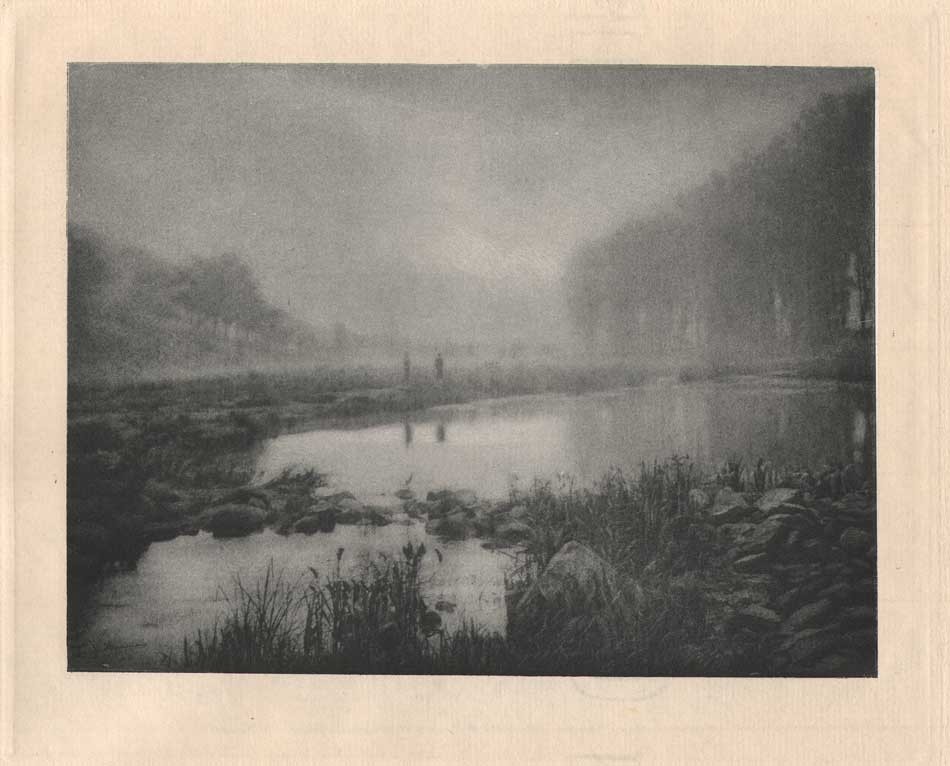 “Brume après la Pluie”: (1906) 1908: Gustave Marissiaux, Belgian (1872-1929) Photogravure on Van Gelder Zonen laid paper: 13.4 x 17.6 | 28.4 x 39.9 cm. Plate XXVI from Marissiaux’s tour-de-force gravure folio “Visions D’Artiste” comprised of 30 plates dating 1899-1908. Translating to “Mist after the Rain”, two figures in the distance stand looking out over an enlarged pond or stream located in "La Terre Wallonne” as identified in the portfolio index: more commonly known today as Wallonia- the southern region of Belgium. From: PhotoSeed Archive
“Brume après la Pluie”: (1906) 1908: Gustave Marissiaux, Belgian (1872-1929) Photogravure on Van Gelder Zonen laid paper: 13.4 x 17.6 | 28.4 x 39.9 cm. Plate XXVI from Marissiaux’s tour-de-force gravure folio “Visions D’Artiste” comprised of 30 plates dating 1899-1908. Translating to “Mist after the Rain”, two figures in the distance stand looking out over an enlarged pond or stream located in "La Terre Wallonne” as identified in the portfolio index: more commonly known today as Wallonia- the southern region of Belgium. From: PhotoSeed Archive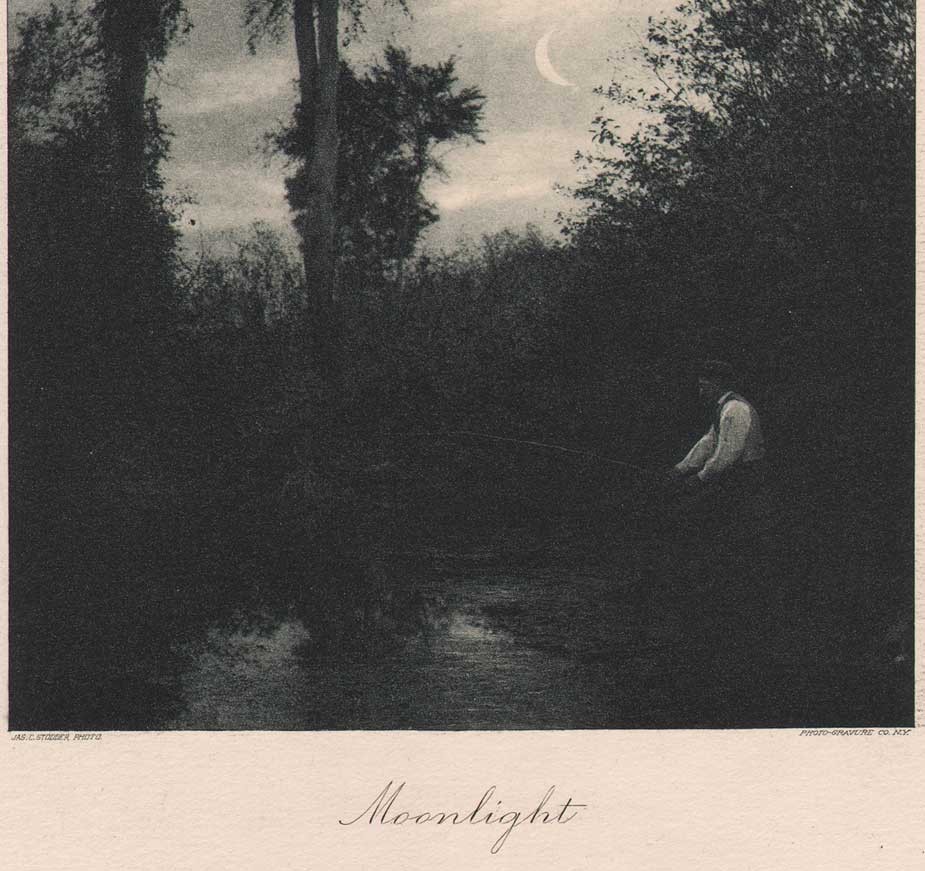 Detail: “Moonlight”: James C. Stodder, American: (1838-1917). 1890. Hand-pulled photogravure published in periodical "Sun & Shade”, New York: November, 1890: whole #27: N.Y. Photogravure Co.: 18.3 x 11.9 | 35.0 x 27.4 cm. A crescent moon rises above a wooded landscape at dusk while a gentleman fishes from the banks of a pond or stream. Stodder graduated from Rensselaer Polytechnic Institute in 1859 and moved to Bangor, Maine, where he first learned the wet-plate process of photography. A lawyer, he was son of a Boston jeweler, (obit) and financially well off. In 1876, he accompanied famed Hudson River School painter Frederic E. Church to the Mount Katahdin region of Maine. From: PhotoSeed Archive
Detail: “Moonlight”: James C. Stodder, American: (1838-1917). 1890. Hand-pulled photogravure published in periodical "Sun & Shade”, New York: November, 1890: whole #27: N.Y. Photogravure Co.: 18.3 x 11.9 | 35.0 x 27.4 cm. A crescent moon rises above a wooded landscape at dusk while a gentleman fishes from the banks of a pond or stream. Stodder graduated from Rensselaer Polytechnic Institute in 1859 and moved to Bangor, Maine, where he first learned the wet-plate process of photography. A lawyer, he was son of a Boston jeweler, (obit) and financially well off. In 1876, he accompanied famed Hudson River School painter Frederic E. Church to the Mount Katahdin region of Maine. From: PhotoSeed Archive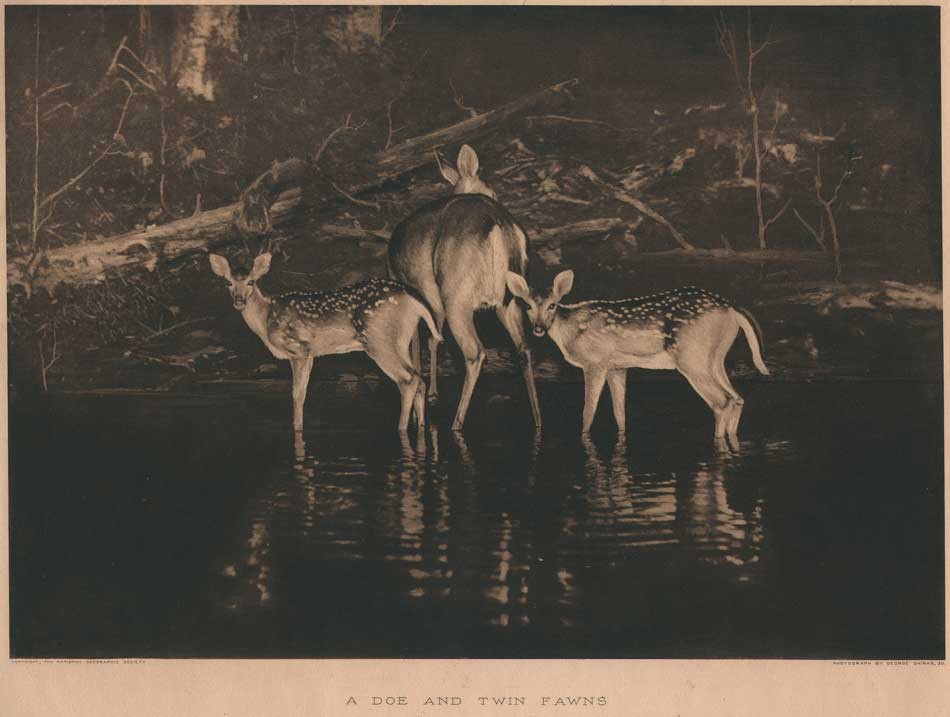 “A Doe and Twin Fawns” (taken 1896) 1916: George Shiras 3rd, American (1859-1942) Vintage photogravure published by the National Geographic Society, Washington, D.C. : 21.2 x 30.3 | 40.5 x 50.8 cm. A pioneer of using flashlight photography to record wildlife in their natural environments at night, Shiras used the method of “Jacklighting”, a form of hunting using a fixed continuous light source mounted in the bow of a canoe to draw the attention of wildlife: in this case three deer, while then utilizing magnesium flash-powder to freeze the scene in-camera. His series of twelve midnight views, including “A Doe and Twin Fawns”-also known as “Innocents Abroad” would earn Shiras international acclaim and many important awards. A one-term Congressman for the state of Michigan, (his father George Shiras Sr. was a former Justice of the U.S. Supreme Court) he was also an important naturalist who helped placed migratory birds and fish under Federal control. (The eventual 1918 Migratory Bird Treaty Act had groundings in legislation Shiras introduced to Congress in 1903 as the first comprehensive migratory bird law not voted on.) For additional background, see article by Matthew Brower in the journal History of Photography, Summer,2008: “George Shiras and the Circulation of Wildlife Photography”. From: PhotoSeed Archive
“A Doe and Twin Fawns” (taken 1896) 1916: George Shiras 3rd, American (1859-1942) Vintage photogravure published by the National Geographic Society, Washington, D.C. : 21.2 x 30.3 | 40.5 x 50.8 cm. A pioneer of using flashlight photography to record wildlife in their natural environments at night, Shiras used the method of “Jacklighting”, a form of hunting using a fixed continuous light source mounted in the bow of a canoe to draw the attention of wildlife: in this case three deer, while then utilizing magnesium flash-powder to freeze the scene in-camera. His series of twelve midnight views, including “A Doe and Twin Fawns”-also known as “Innocents Abroad” would earn Shiras international acclaim and many important awards. A one-term Congressman for the state of Michigan, (his father George Shiras Sr. was a former Justice of the U.S. Supreme Court) he was also an important naturalist who helped placed migratory birds and fish under Federal control. (The eventual 1918 Migratory Bird Treaty Act had groundings in legislation Shiras introduced to Congress in 1903 as the first comprehensive migratory bird law not voted on.) For additional background, see article by Matthew Brower in the journal History of Photography, Summer,2008: “George Shiras and the Circulation of Wildlife Photography”. From: PhotoSeed Archive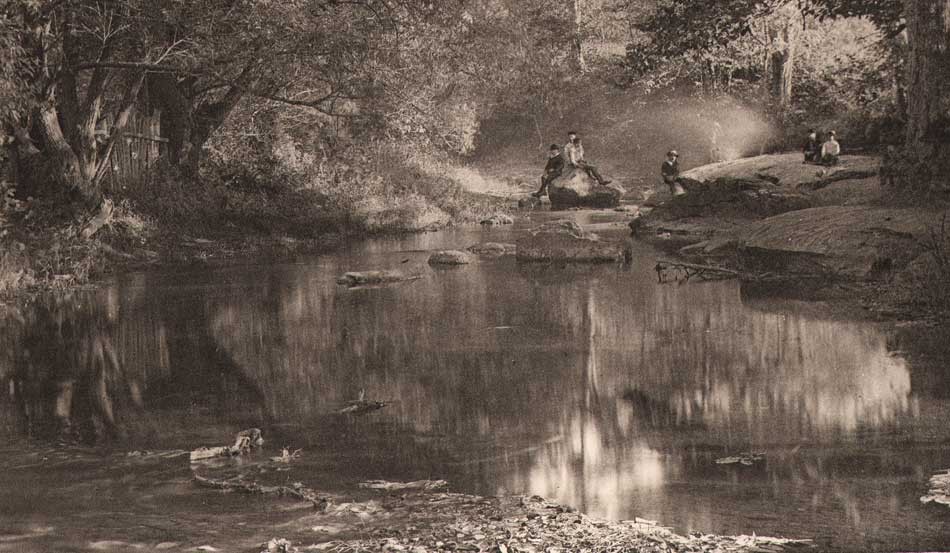 Detail: “A Corn Roast” Oliver Patterson Watts, American: (1865-1953). 1892. Hand-pulled photogravure published in periodical "Sun & Shade”, New York: June, 1892: whole #46: N.Y. Photogravure Co.: 14.7 x 23.2 | 34.6 x 27.4 cm. The index for the issue of Sun & Shade in which this photograph appears states: “Mr. Watts writes us that while wandering with his camera along “The Green,” a favorite picnic ground near Thomastown,(sic) Maine, he came upon this group of boys roasting corn and potatoes. At the sight of the camera they immediately grouped themselves, anxious to be “took.” The negative was made with a Scovill Favorite Camera, Waterbury lens, with an exposure of five seconds on a seed plate. It was developed with Pyro and Sodium Carbonate.” Dr. Oliver Patterson Watts was born in Thomaston, Maine, and graduated from Bowdoin College in 1889. Interestingly, in 1890, Potts and Dr. Julius Stieglitz, the brother of Alfred Stieglitz, were fellow scholars in chemistry at the newly opened Clark University in Worcester, MA. He later entered the University of Wisconsin in 1905 and took charge of the Carnegie Research on Electrolytic Iron under Dr. Charles F. Burgess. According to an Oct. 2009 article on Potts for the online resource Plating & Surface Finishing, the most important of his fifty-nine papers on plating and corrosion is probably “Rapid Nickel Plating,” presented before the Electrochemical Society in 1915. From: PhotoSeed Archive
Detail: “A Corn Roast” Oliver Patterson Watts, American: (1865-1953). 1892. Hand-pulled photogravure published in periodical "Sun & Shade”, New York: June, 1892: whole #46: N.Y. Photogravure Co.: 14.7 x 23.2 | 34.6 x 27.4 cm. The index for the issue of Sun & Shade in which this photograph appears states: “Mr. Watts writes us that while wandering with his camera along “The Green,” a favorite picnic ground near Thomastown,(sic) Maine, he came upon this group of boys roasting corn and potatoes. At the sight of the camera they immediately grouped themselves, anxious to be “took.” The negative was made with a Scovill Favorite Camera, Waterbury lens, with an exposure of five seconds on a seed plate. It was developed with Pyro and Sodium Carbonate.” Dr. Oliver Patterson Watts was born in Thomaston, Maine, and graduated from Bowdoin College in 1889. Interestingly, in 1890, Potts and Dr. Julius Stieglitz, the brother of Alfred Stieglitz, were fellow scholars in chemistry at the newly opened Clark University in Worcester, MA. He later entered the University of Wisconsin in 1905 and took charge of the Carnegie Research on Electrolytic Iron under Dr. Charles F. Burgess. According to an Oct. 2009 article on Potts for the online resource Plating & Surface Finishing, the most important of his fifty-nine papers on plating and corrosion is probably “Rapid Nickel Plating,” presented before the Electrochemical Society in 1915. From: PhotoSeed Archive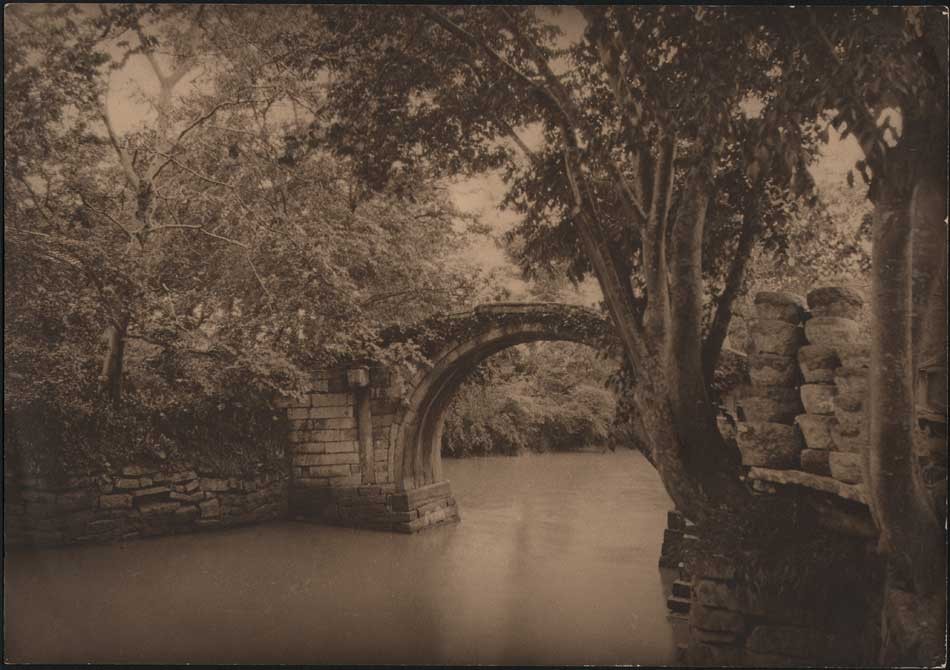 “Mutu Bridge”: Donald Mennie, Scottish (1875-1944) 1922: Vintage unmounted bromide print: 24.2 x 34.6 cm. This picturesque Chinese river scene first appeared as a full-page plate variant in the 1914 volume “My Lady of the Chinese Courtyard” (between pp. 254-5) by author Elizabeth Cooper and then as Plate #7 “Mutu Bridge” in the photographer’s ca. 1914 work “Picturesque China: A Series of Vandyck Photogravures illustrating Chinese Life and Surroundings”. From: PhotoSeed Archive
“Mutu Bridge”: Donald Mennie, Scottish (1875-1944) 1922: Vintage unmounted bromide print: 24.2 x 34.6 cm. This picturesque Chinese river scene first appeared as a full-page plate variant in the 1914 volume “My Lady of the Chinese Courtyard” (between pp. 254-5) by author Elizabeth Cooper and then as Plate #7 “Mutu Bridge” in the photographer’s ca. 1914 work “Picturesque China: A Series of Vandyck Photogravures illustrating Chinese Life and Surroundings”. From: PhotoSeed Archive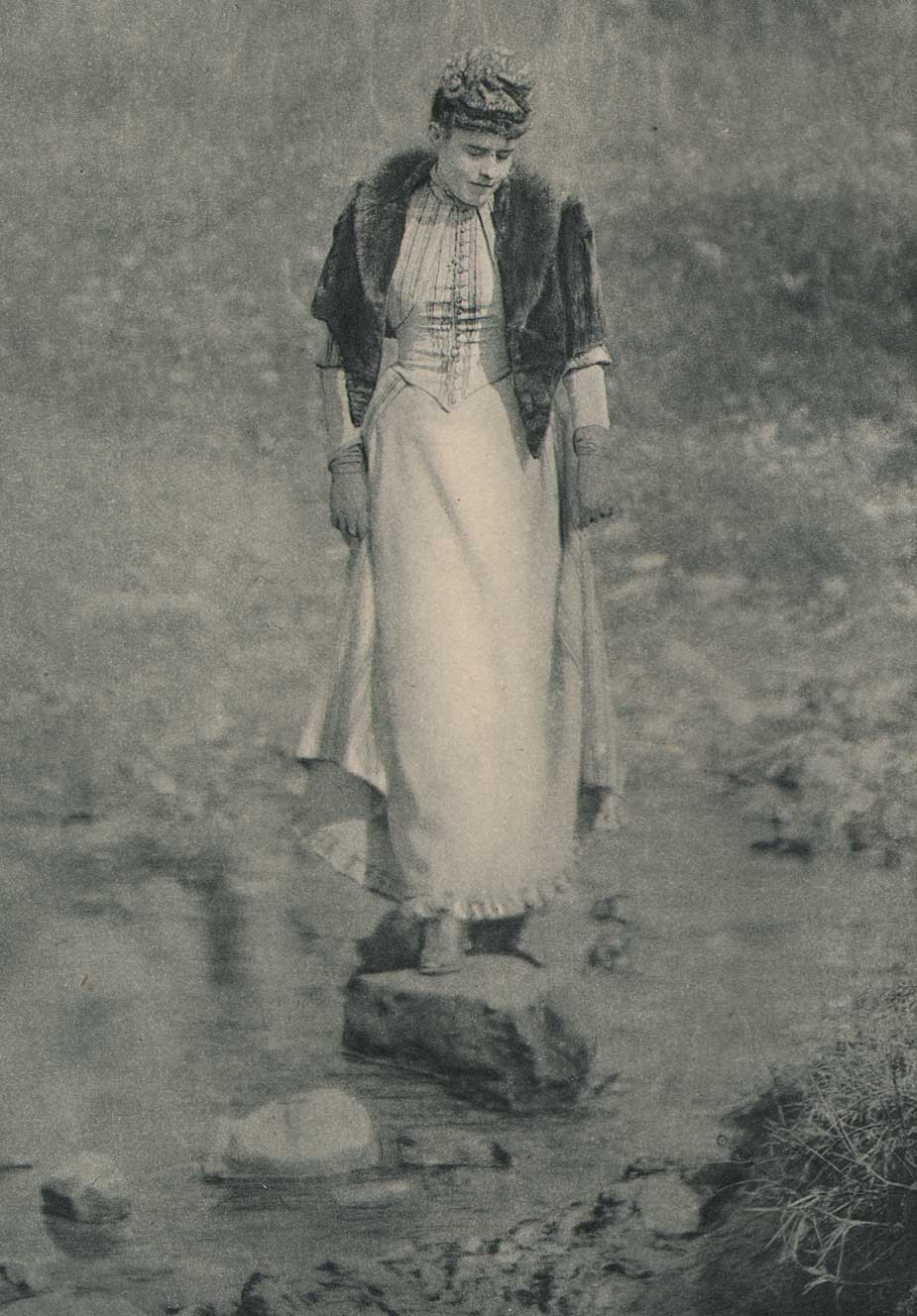 Detail: “Stepping Stones” George Bacon Wood Jr., American: (1832-1909). 1894. Hand-pulled photogravure published in periodical "Sun & Shade”, New York: January, 1894: whole #65: N.Y. Photogravure Co.: 20.5 x 11.7 | 34.9 x 27.5 cm. The index for the issue of Sun & Shade in which this photograph appears states: “To the meditative woman crossing the brook with careful steps upon the projecting stones, Oliver Wendell Holmes’ words, in his “Professor at the Breakfast Table,” can be appropriately applied: “The wisest woman you talk with is ignorant of something that you know, but an elegant woman never forgets her elegance.” With no eye to see her, as she crosses the woodland stream, the figure in the picture appears reposeful, full of thought, and unconsciously elegant in pose. This is a charming photograph from nature, simple, truthful and artistic.” From: PhotoSeed Archive
Detail: “Stepping Stones” George Bacon Wood Jr., American: (1832-1909). 1894. Hand-pulled photogravure published in periodical "Sun & Shade”, New York: January, 1894: whole #65: N.Y. Photogravure Co.: 20.5 x 11.7 | 34.9 x 27.5 cm. The index for the issue of Sun & Shade in which this photograph appears states: “To the meditative woman crossing the brook with careful steps upon the projecting stones, Oliver Wendell Holmes’ words, in his “Professor at the Breakfast Table,” can be appropriately applied: “The wisest woman you talk with is ignorant of something that you know, but an elegant woman never forgets her elegance.” With no eye to see her, as she crosses the woodland stream, the figure in the picture appears reposeful, full of thought, and unconsciously elegant in pose. This is a charming photograph from nature, simple, truthful and artistic.” From: PhotoSeed Archive “Derniers Rayons Dans la Forêt”: Guglielmo Oliaro, Italian: (1874 -1936) vintage Bromide photograph, ca. 1900? 1907: 16.6 x 22.5 | 23.5 x 32.7 cm. Translating to “Last Rays In The Forest”, this bucolic scene at dusk features a rushing stream and footbridge bisecting a a silhouetted line of Pollarded Willow trees. From Turin, amateur photographer Dr. Guglielmo Oliaro was very interested in the arts, founding a medical publishing house that survives to this day: From the InterFairs online resource: “Minerva Medica was the brainchild of a Turin GP (General Practitioner -ed.) Dr. Guglielmo Oliaro, a scientist with a passion for literature, art and music. It was on December 8 1925 that Dr. Oliaro got together with a small group of partners to set up the original company, Tipografia Editrice Minerva based in Turin. The creation of that company was a response to the growing success both in Italy and abroad, of Minerva Medica, a weekly journal for the general practitioner that first came out in 1909. Edizioni Minerva Medica S.p.A. was set up as a limited company by Dr. Guglielmo Oliaro on June 9 1934, for the purpose of supplying the Italian medical profession with text-books and scientific journals.” This example of Oliaro’s work was printed by the Milan atelier Maison Tensi and included as a full-page plate in the April, 1907 issue of “La Fotographia Artistica”, a French/Italian photographic journal. From: PhotoSeed Archive
“Derniers Rayons Dans la Forêt”: Guglielmo Oliaro, Italian: (1874 -1936) vintage Bromide photograph, ca. 1900? 1907: 16.6 x 22.5 | 23.5 x 32.7 cm. Translating to “Last Rays In The Forest”, this bucolic scene at dusk features a rushing stream and footbridge bisecting a a silhouetted line of Pollarded Willow trees. From Turin, amateur photographer Dr. Guglielmo Oliaro was very interested in the arts, founding a medical publishing house that survives to this day: From the InterFairs online resource: “Minerva Medica was the brainchild of a Turin GP (General Practitioner -ed.) Dr. Guglielmo Oliaro, a scientist with a passion for literature, art and music. It was on December 8 1925 that Dr. Oliaro got together with a small group of partners to set up the original company, Tipografia Editrice Minerva based in Turin. The creation of that company was a response to the growing success both in Italy and abroad, of Minerva Medica, a weekly journal for the general practitioner that first came out in 1909. Edizioni Minerva Medica S.p.A. was set up as a limited company by Dr. Guglielmo Oliaro on June 9 1934, for the purpose of supplying the Italian medical profession with text-books and scientific journals.” This example of Oliaro’s work was printed by the Milan atelier Maison Tensi and included as a full-page plate in the April, 1907 issue of “La Fotographia Artistica”, a French/Italian photographic journal. From: PhotoSeed Archive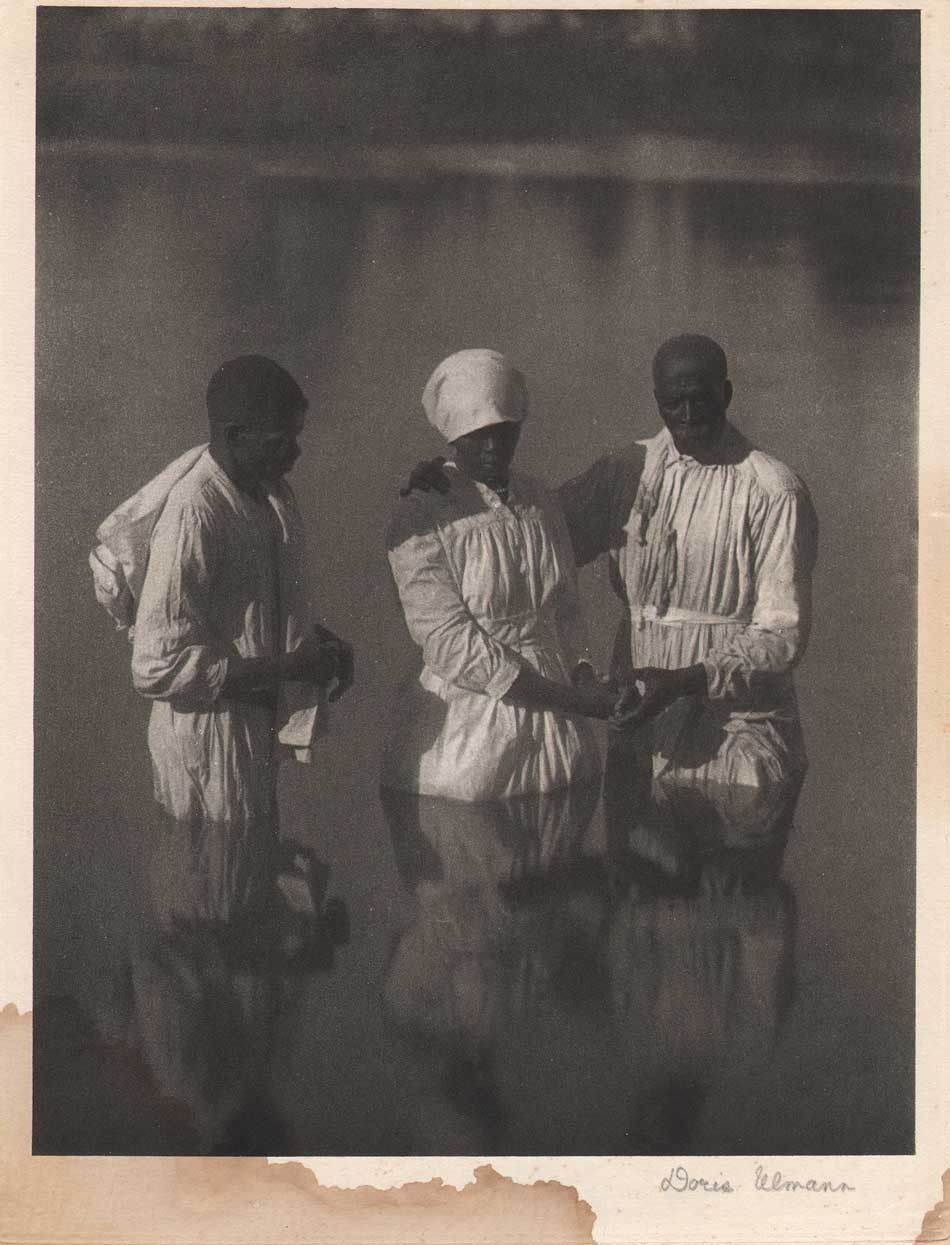 “Baptismal Scene” : Doris Ulmann, American: (1882 –1934) 1933: Signed, hand-pulled photogravure included as additional loose plate from deluxe edition of “Roll, Jordan, Roll”: 21.3 x 16.4 | 28.3 x 20.7 cm. In a rather interesting coincidence, this particular example of a summer stream showing a well-known river baptism by Ulmann has been partially immersed by moisture along the lower margin. From p. 116 of the volume: “A candidate for admission into the church must first be baptized. The Methodists have water sprinkled on their heads, but Baptists must be publicly immersed. These “baptisms” attract large crowds of onlookers. The candidates all arrive at the “pool” dressed in long white robes, which are carefully put away after the ceremony to serve as their shrouds some day. When they are assembled, the preacher and the leader, also dressed in white robes, lead the first candidate down into the water, where he is dipped three times, once in the name of the Father, once in the name of the Son, and once in the name of the Holy Ghost. As he is lead up out of the water, all his sins are left behind, drowned and buried in a watery grave. His soul is cleansed white as snow and he is ready to be received into full church membership. Unless he “falls” into sin and gets “turned out” of the church, he will some day be received into fellowship with God’s holy angels up in heaven.” The following review of Roll, Jordon, Roll comes from Steve Watson and was included on the Amon Carter Museum of American Art website, first published in 2016: Photographer Doris Ulmann came from an affluent white New York City family. She took teacher training with photographer Lewis Hine at the Ethical Culture School and subsequently studied psychology and law at Columbia University. She also studied photography with Clarence H. White, a founding member of the Photo-Secession movement known for teaching the Pictorialist style. Ulmann collaborated with novelist Julia Peterkin on a book project titled Roll, Jordan, Roll(New York: R.O. Ballou, 1933). The book focuses on the lives of former slaves and their descendants on a plantation in the Gullah coastal region of South Carolina. Peterkin, who won the Pulitzer Prize for her novel Scarlet Sister Mary (Indianapolis: Bobbs-Merrill, 1928), was born in South Carolina and raised by a black nursemaid who taught her the Gullah dialect. She married the heir to Lang Syne, a 2,000-acre cotton plantation, which became the setting for Roll, Jordan, Roll. Ulmann began photographing there in 1929. Roll, Jordan, Roll is titled after the spiritual written by English Methodist leader Charles Wesley in the 18th century which became well-known among slaves in the United States during the 19th century. Appropriated as a coded message for escape, by the end of the American Civil War it had become known through much of the eastern United States. In the 20th century it helped inspire the blues, and it remains a staple in gospel music. Roll, Jordan, Roll was illustrated with 90 photogravure plates made from Ulmann’s large-format negatives. Although they comprise an amazing ethnographic study, today Ulmann’s Pictorialist aesthetic seems a strange choice for making documentary images. The hazy, soft-focus photographs lend a sentimental, nostalgic impression that belies the underlying exploitative history of her subjects. From: PhotoSeed Archive
“Baptismal Scene” : Doris Ulmann, American: (1882 –1934) 1933: Signed, hand-pulled photogravure included as additional loose plate from deluxe edition of “Roll, Jordan, Roll”: 21.3 x 16.4 | 28.3 x 20.7 cm. In a rather interesting coincidence, this particular example of a summer stream showing a well-known river baptism by Ulmann has been partially immersed by moisture along the lower margin. From p. 116 of the volume: “A candidate for admission into the church must first be baptized. The Methodists have water sprinkled on their heads, but Baptists must be publicly immersed. These “baptisms” attract large crowds of onlookers. The candidates all arrive at the “pool” dressed in long white robes, which are carefully put away after the ceremony to serve as their shrouds some day. When they are assembled, the preacher and the leader, also dressed in white robes, lead the first candidate down into the water, where he is dipped three times, once in the name of the Father, once in the name of the Son, and once in the name of the Holy Ghost. As he is lead up out of the water, all his sins are left behind, drowned and buried in a watery grave. His soul is cleansed white as snow and he is ready to be received into full church membership. Unless he “falls” into sin and gets “turned out” of the church, he will some day be received into fellowship with God’s holy angels up in heaven.” The following review of Roll, Jordon, Roll comes from Steve Watson and was included on the Amon Carter Museum of American Art website, first published in 2016: Photographer Doris Ulmann came from an affluent white New York City family. She took teacher training with photographer Lewis Hine at the Ethical Culture School and subsequently studied psychology and law at Columbia University. She also studied photography with Clarence H. White, a founding member of the Photo-Secession movement known for teaching the Pictorialist style. Ulmann collaborated with novelist Julia Peterkin on a book project titled Roll, Jordan, Roll(New York: R.O. Ballou, 1933). The book focuses on the lives of former slaves and their descendants on a plantation in the Gullah coastal region of South Carolina. Peterkin, who won the Pulitzer Prize for her novel Scarlet Sister Mary (Indianapolis: Bobbs-Merrill, 1928), was born in South Carolina and raised by a black nursemaid who taught her the Gullah dialect. She married the heir to Lang Syne, a 2,000-acre cotton plantation, which became the setting for Roll, Jordan, Roll. Ulmann began photographing there in 1929. Roll, Jordan, Roll is titled after the spiritual written by English Methodist leader Charles Wesley in the 18th century which became well-known among slaves in the United States during the 19th century. Appropriated as a coded message for escape, by the end of the American Civil War it had become known through much of the eastern United States. In the 20th century it helped inspire the blues, and it remains a staple in gospel music. Roll, Jordan, Roll was illustrated with 90 photogravure plates made from Ulmann’s large-format negatives. Although they comprise an amazing ethnographic study, today Ulmann’s Pictorialist aesthetic seems a strange choice for making documentary images. The hazy, soft-focus photographs lend a sentimental, nostalgic impression that belies the underlying exploitative history of her subjects. From: PhotoSeed Archive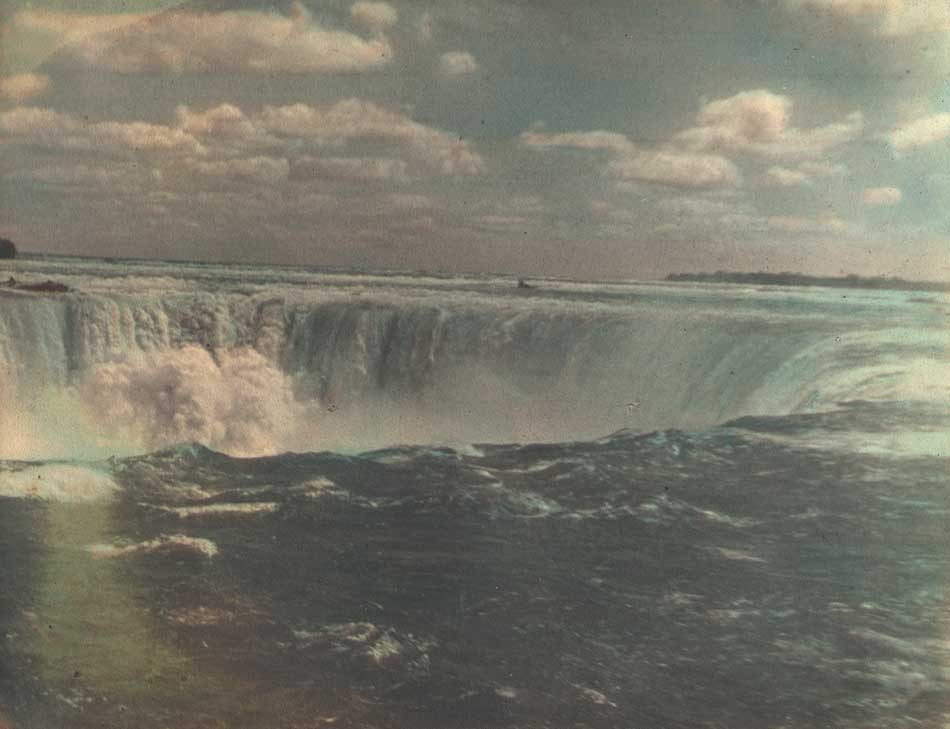 “Niagara Falls”: attributed to Arthur Hammond, American: born England: 1880-1962: hand-colored gelatin silver print mounted to album leaf, ca. 1930-1940: 19.2 x 24.2 | 25.0 x 32.7 cm. To conclude our post is a view of the ultimate Summer Stream: a view showing the Niagara River’s Horseshoe Falls from the Canadian side. From a personal album of nearly 100 photographs attributed to Hammond dating from around 1910-1940. Born in London, photographer Arthur Hammond arrived in America at Ellis Island in New York Harbor on July 31, 1909 and established himself with his own studio in Natick, MA outside Boston by 1912. In 1920, he authored the foundational book "Pictorial Composition in Photography" and became a leading voice for pictorialism in America through his position as associate editor of American Photography magazine that lasted 30 years from 1918-1949. From: PhotoSeed Archive
“Niagara Falls”: attributed to Arthur Hammond, American: born England: 1880-1962: hand-colored gelatin silver print mounted to album leaf, ca. 1930-1940: 19.2 x 24.2 | 25.0 x 32.7 cm. To conclude our post is a view of the ultimate Summer Stream: a view showing the Niagara River’s Horseshoe Falls from the Canadian side. From a personal album of nearly 100 photographs attributed to Hammond dating from around 1910-1940. Born in London, photographer Arthur Hammond arrived in America at Ellis Island in New York Harbor on July 31, 1909 and established himself with his own studio in Natick, MA outside Boston by 1912. In 1920, he authored the foundational book "Pictorial Composition in Photography" and became a leading voice for pictorialism in America through his position as associate editor of American Photography magazine that lasted 30 years from 1918-1949. From: PhotoSeed Archive
By the Stream
Paul Laurence Dunbar (1872-1906)
By the stream I dream in calm delight, and watch as in a glass,
How the clouds like crowds of snowy-hued and white-robed
maidens pass,
And the water into ripples breaks and sparkles as it spreads,
Like a host of armored knights with silver helmets on their heads.
And I deem the stream an emblem fit of human life may go,
For I find a mind may sparkle much and yet but shallows show,
And a soul may glow with myriad lights and wondrous mysteries,
When it only lies a dormant thing and mirrors what it sees.
Summer Sailing
Posted June 2018 in Alternate Processes, Color Photography, Documentary Photography
Sail into Summer…
 Detail: "Summer Sailing": attributed to Arthur Hammond, American: born England:1880-1962: hand-colored gelatin silver print mounted to album leaf, ca. 1930-1940: 24.1 x 10.1 | 25.0 x 32.7 cm. From a personal album of nearly 100 photographs attributed to Hammond dating from around 1910-1940. Born in London, photographer Arthur Hammond arrived in America at Ellis Island in New York Harbor on July 31, 1909 and established himself with his own studio in Natick, MA outside Boston by 1912. In 1920, he authored the foundational book "Pictorial Composition in Photography" and became a leading voice for pictorialism in America through his position as associate editor of American Photography magazine that lasted 30 years from 1918-1949. This photo possibly taken along Boston's North Shore, with other maritime album images identified as the old Deer Island lighthouse in Boston Harbor and the original building for the Jubilee Yacht Club in Beverly Mass. From: PhotoSeed Archive
Detail: "Summer Sailing": attributed to Arthur Hammond, American: born England:1880-1962: hand-colored gelatin silver print mounted to album leaf, ca. 1930-1940: 24.1 x 10.1 | 25.0 x 32.7 cm. From a personal album of nearly 100 photographs attributed to Hammond dating from around 1910-1940. Born in London, photographer Arthur Hammond arrived in America at Ellis Island in New York Harbor on July 31, 1909 and established himself with his own studio in Natick, MA outside Boston by 1912. In 1920, he authored the foundational book "Pictorial Composition in Photography" and became a leading voice for pictorialism in America through his position as associate editor of American Photography magazine that lasted 30 years from 1918-1949. This photo possibly taken along Boston's North Shore, with other maritime album images identified as the old Deer Island lighthouse in Boston Harbor and the original building for the Jubilee Yacht Club in Beverly Mass. From: PhotoSeed ArchiveSummer Love & Remembrance
Posted July 2017 in Color Photography, Fashion Photography, Unknown Photographers
From days gone by, an early summer scene for your viewing fancy.
 "Woman with Poppies": vintage Autochrome glass plate: Anonymous, perhaps British photographer: ca. 1910-20: 8.2 x 8.2 cm. Autochrome, the first practical color photographic process, was invented and first patented by Auguste and Louis Lumière of France in 1903. Commercially available beginning in 1907 and championed by pictorialist photographers the world over, Wikipedia states Autochrome was an additive color mosaic screen plate process. "The medium consists of a glass plate coated on one side with a random mosaic of microscopic grains of potato starch dyed red-orange, green, and blue-violet which act as color filters. Lampblack fills the spaces between grains, and a black-and-white panchromatic silver halide emulsion is coated on top of the filter layer." From: PhotoSeed Archive
"Woman with Poppies": vintage Autochrome glass plate: Anonymous, perhaps British photographer: ca. 1910-20: 8.2 x 8.2 cm. Autochrome, the first practical color photographic process, was invented and first patented by Auguste and Louis Lumière of France in 1903. Commercially available beginning in 1907 and championed by pictorialist photographers the world over, Wikipedia states Autochrome was an additive color mosaic screen plate process. "The medium consists of a glass plate coated on one side with a random mosaic of microscopic grains of potato starch dyed red-orange, green, and blue-violet which act as color filters. Lampblack fills the spaces between grains, and a black-and-white panchromatic silver halide emulsion is coated on top of the filter layer." From: PhotoSeed Archive
See other examples of early color views in various processes from PhotoSeed here.
SpringSprung
Posted April 2016 in Alternate Processes, Color Photography, Fashion Photography, New Additions, Unknown Photographers
The Northern Hemisphere has once again thankfully undergone rebirth, becoming the season of spring and with it, all the hope it represents for the continuation of our natural and human worlds.
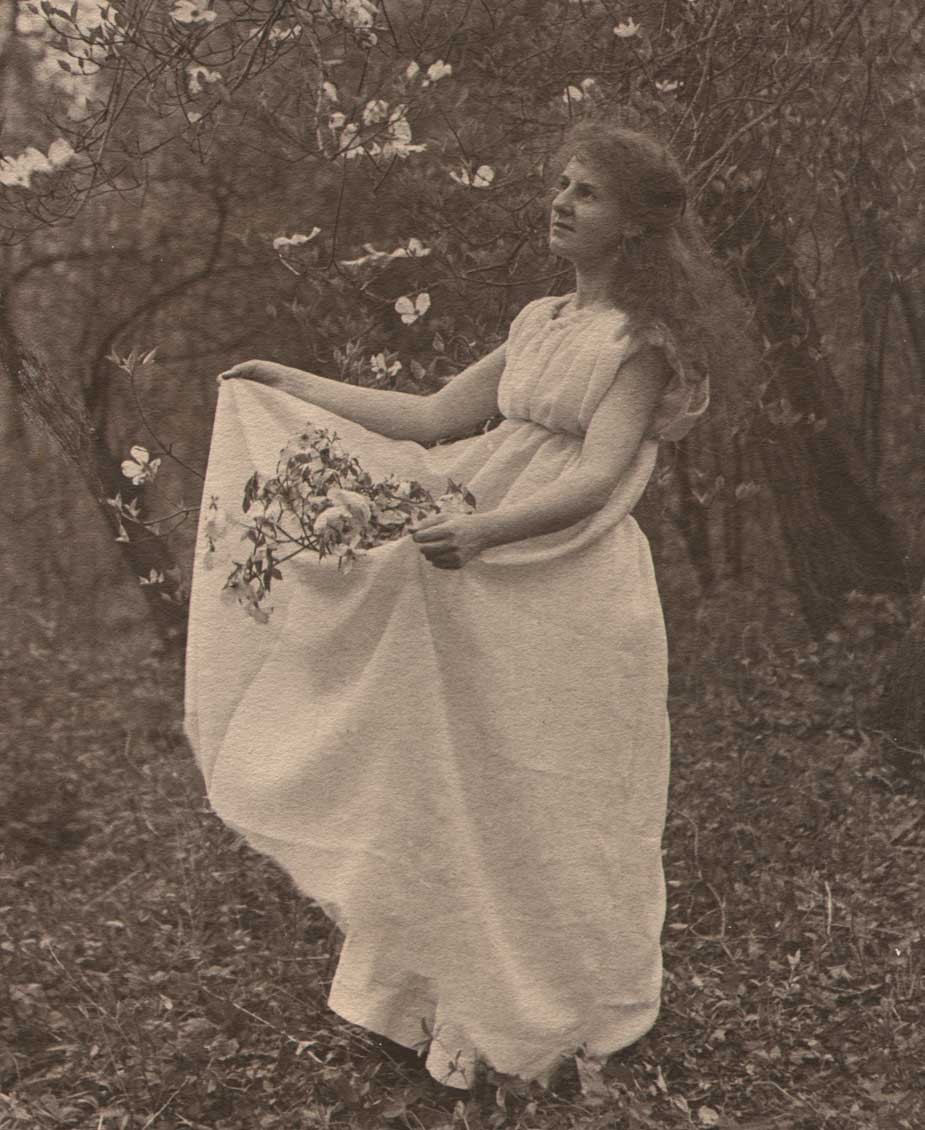 Detail: "Curtis High School Girl Gathering Dogwood Boughs": Charles Rollins Tucker: American: platinum: ca. 1910-15: 19.7 x 13.1 | 30.5 x 23.3 cm: A genre landscape study celebrating both spring and womanhood, the model is perhaps a thespian known to have attended Curtis High School on Staten Island in New York City, where photographer C.R. Tucker taught Physics at the time. From: PhotoSeed Archive
Detail: "Curtis High School Girl Gathering Dogwood Boughs": Charles Rollins Tucker: American: platinum: ca. 1910-15: 19.7 x 13.1 | 30.5 x 23.3 cm: A genre landscape study celebrating both spring and womanhood, the model is perhaps a thespian known to have attended Curtis High School on Staten Island in New York City, where photographer C.R. Tucker taught Physics at the time. From: PhotoSeed Archive
Photographically, with the exceptions of those open-minded enough to embrace the obvious-something Alfred Stieglitz seized upon in 1893 when winter proved more than suitable for subject matter- the majority of amateurs a bit later at the turn of the 20th century seemed interested in dusting off their cameras only when those first buds and flowers of the season awoke once more.
This abbreviated compilation of images spanning the 1890’s through about 1940 from the PhotoSeed Archive-no matter how dated they may appear from the mores of days long gone by- is a reaffirmation dedicated to you that spring’s beauty and potential might give us all a bit of hope towards the future betterment of our often fragmented, present-day world. David Spencer- April, 2016
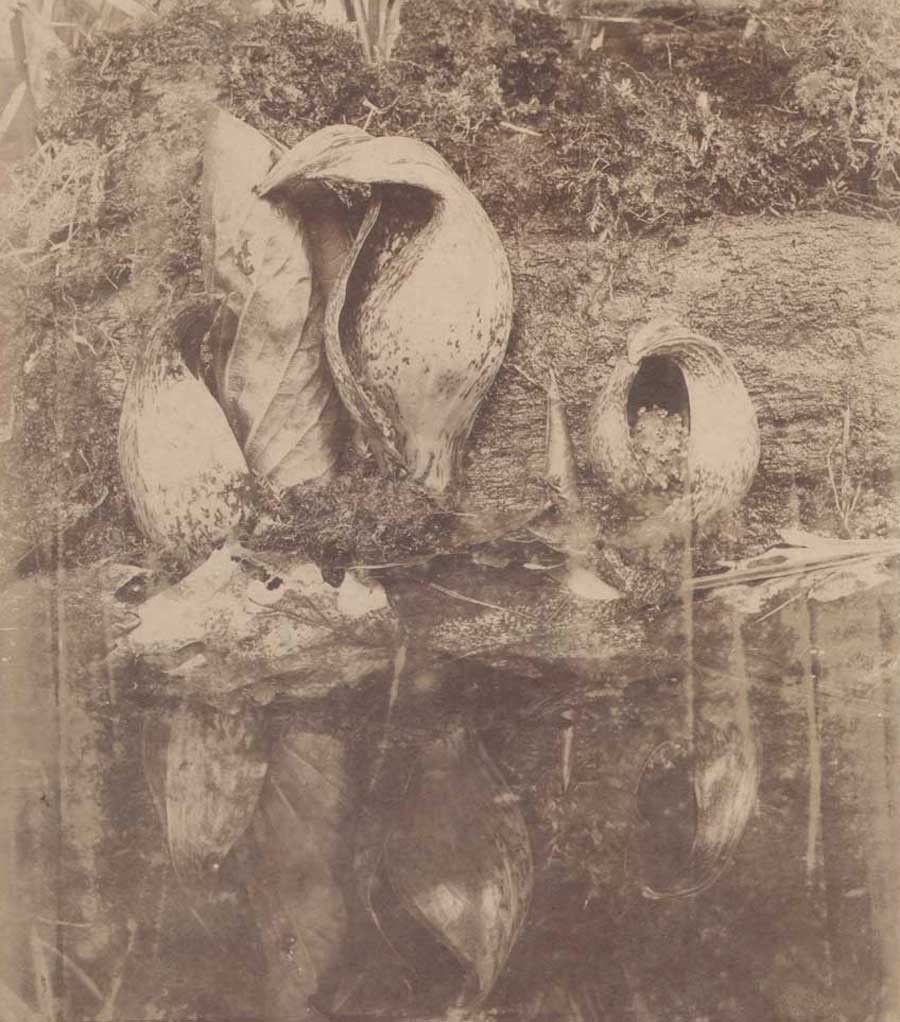 Detail: "Harbingers of Spring": Louise Birt Baynes: American: gelatin silver: 1904: 20.8 x 15.5 | 35.6 x 27.9 cm: This study of skunk cabbage growing in the spring time may have been taken using an artificial light source. Author Frank Roy Fraprie mentioned the work in his article on photographing wild flowers for the March, 1904 issue of Boston’s Photo-Era magazine: "The plant must be photographed in its surroundings, for it has no stem or leaves at this season, to make possible a graceful arrangement at home, even if one were inclined to extend it hospitality. Mrs. Baynes has conquered all these difficulties, and her picture, “Harbingers of Spring,” is interesting to both the naturalist and the artistic photographer, - to one for its fidelity and to the other for its good composition." From: PhotoSeed Archive
Detail: "Harbingers of Spring": Louise Birt Baynes: American: gelatin silver: 1904: 20.8 x 15.5 | 35.6 x 27.9 cm: This study of skunk cabbage growing in the spring time may have been taken using an artificial light source. Author Frank Roy Fraprie mentioned the work in his article on photographing wild flowers for the March, 1904 issue of Boston’s Photo-Era magazine: "The plant must be photographed in its surroundings, for it has no stem or leaves at this season, to make possible a graceful arrangement at home, even if one were inclined to extend it hospitality. Mrs. Baynes has conquered all these difficulties, and her picture, “Harbingers of Spring,” is interesting to both the naturalist and the artistic photographer, - to one for its fidelity and to the other for its good composition." From: PhotoSeed Archive
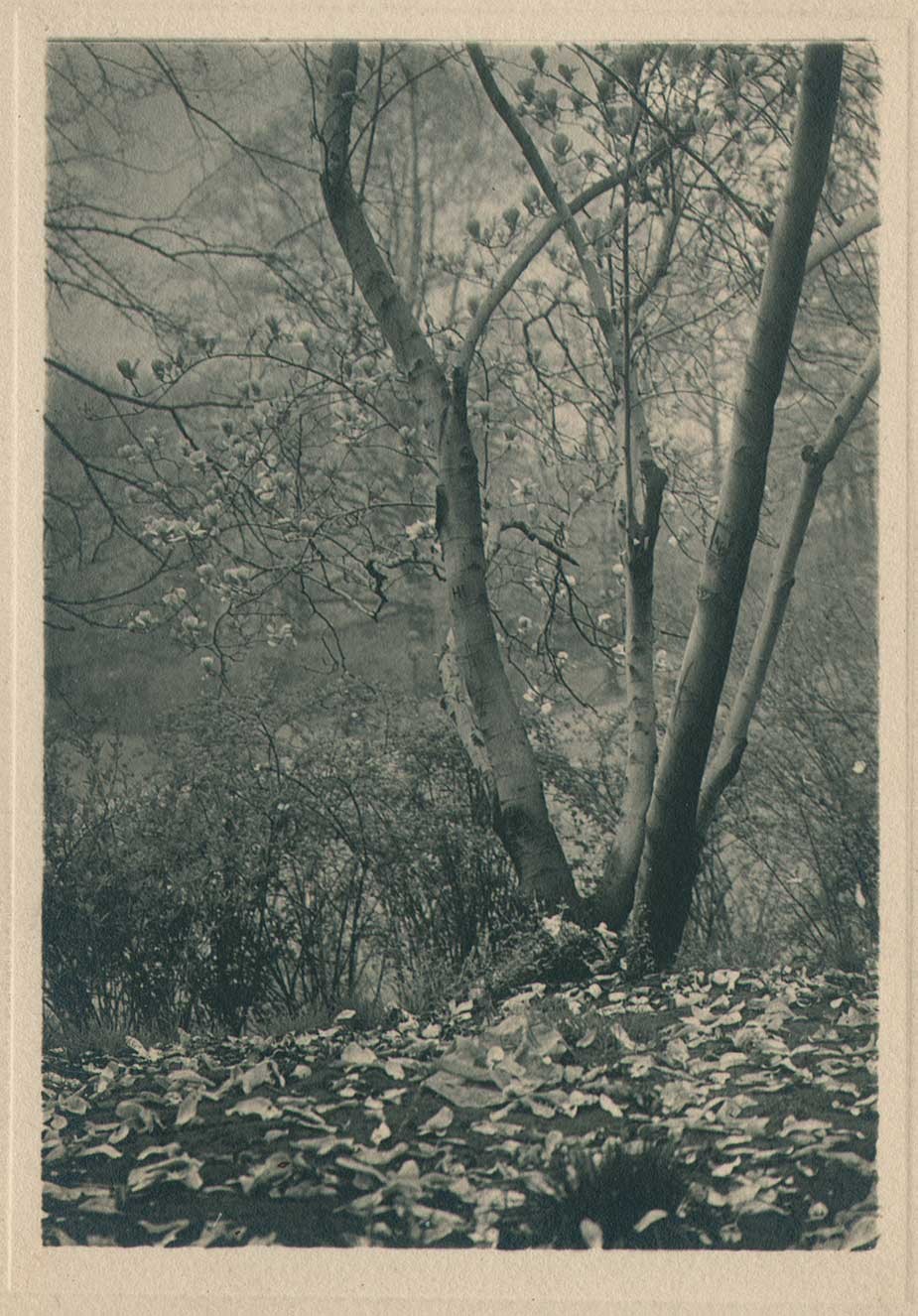 "Spring Vista with Fallen Leaves": by Unknown Brooklyn (photographer) : American: carbon?: ca. 1905-10: 11.9 x 8.2 | 17.8 x 12.1 cm: What are believed to be Magnolia tree blossoms litter the ground in the foreground of this spring landscape study featuring a blooming Magnolia in the background, with the setting believed to be Brooklyn's Prospect Park as many known examples of this location were taken by this photographer. This photograph, with title supplied by this archive, is by an Unknown Brooklyn amateur photographer whose surviving work was discovered in a trunk in the American South. Background can be found by searching for this site's 2015 blog post: "No Junk in Trunk". From: PhotoSeed Archive
"Spring Vista with Fallen Leaves": by Unknown Brooklyn (photographer) : American: carbon?: ca. 1905-10: 11.9 x 8.2 | 17.8 x 12.1 cm: What are believed to be Magnolia tree blossoms litter the ground in the foreground of this spring landscape study featuring a blooming Magnolia in the background, with the setting believed to be Brooklyn's Prospect Park as many known examples of this location were taken by this photographer. This photograph, with title supplied by this archive, is by an Unknown Brooklyn amateur photographer whose surviving work was discovered in a trunk in the American South. Background can be found by searching for this site's 2015 blog post: "No Junk in Trunk". From: PhotoSeed Archive
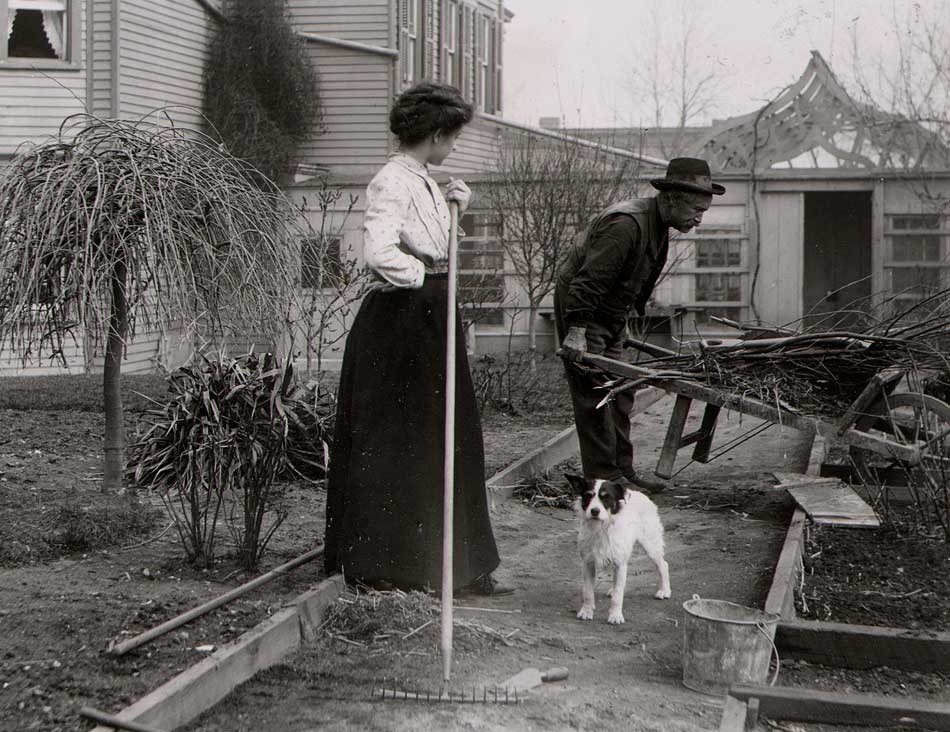 Detail: "Cleaning up the Yard in Spring": c. 1900-05 by Jeanette Bernard: American, born Germany: (1855-1941) gelatin silver print c. 1935-40 from original glass plate negative acquired by Culver Service : 15.4 x 13.9 cm: alternate title: "Woman and Man Gardening"-George Eastman House NEG: 40724: 83:2640:0025: A spring cleaning study in a garden shows the photographer's daughter with pet terrier dog at her feet watching as a gentleman (perhaps a hired man) prepares to move a collection of dead branches using a wheelbarrow. From: PhotoSeed Archive
Detail: "Cleaning up the Yard in Spring": c. 1900-05 by Jeanette Bernard: American, born Germany: (1855-1941) gelatin silver print c. 1935-40 from original glass plate negative acquired by Culver Service : 15.4 x 13.9 cm: alternate title: "Woman and Man Gardening"-George Eastman House NEG: 40724: 83:2640:0025: A spring cleaning study in a garden shows the photographer's daughter with pet terrier dog at her feet watching as a gentleman (perhaps a hired man) prepares to move a collection of dead branches using a wheelbarrow. From: PhotoSeed Archive
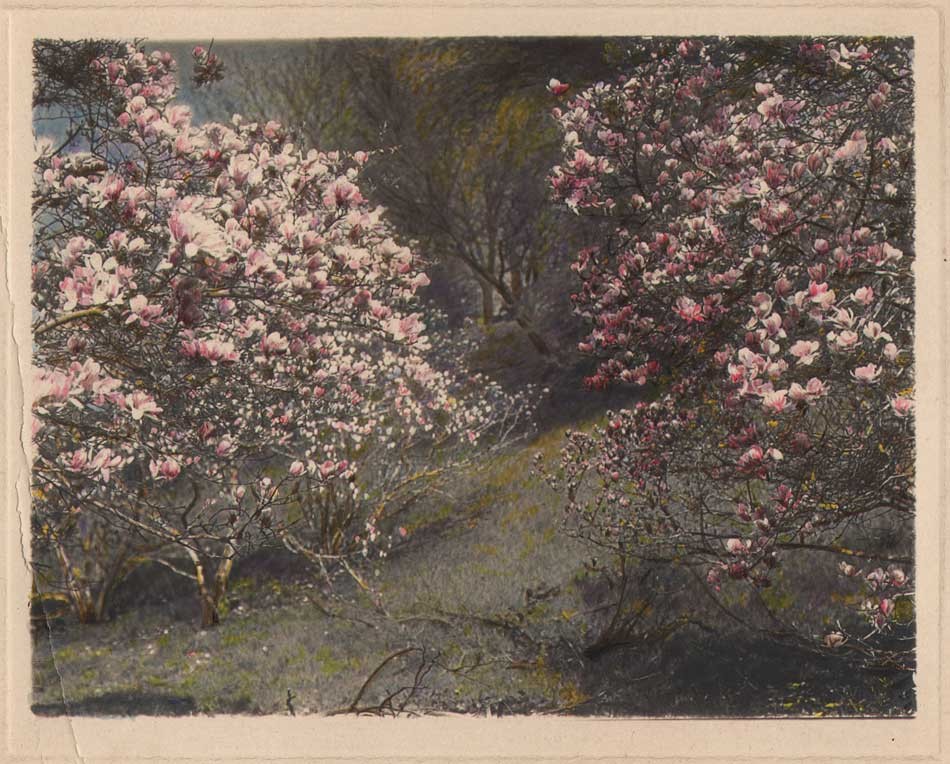 "Magnolia Trees Blooming in Spring": by Unknown Brooklyn (photographer) : American: gelatin silver (hand-colored) from copy print: ca. 1910-15: 9.0 x 11.6 | 12.4 x 16.4 cm: This hand-colored landscape study showing several blooming Magnolia trees is believed to have been taken at Brooklyn's Prospect Park as many known examples of this location were taken by this photographer. This photograph, with title supplied by this archive, is by an Unknown Brooklyn amateur photographer whose surviving work was discovered in a trunk in the American South. Background can be found by searching for this site's 2015 blog post: "No Junk in Trunk". From: PhotoSeed Archive
"Magnolia Trees Blooming in Spring": by Unknown Brooklyn (photographer) : American: gelatin silver (hand-colored) from copy print: ca. 1910-15: 9.0 x 11.6 | 12.4 x 16.4 cm: This hand-colored landscape study showing several blooming Magnolia trees is believed to have been taken at Brooklyn's Prospect Park as many known examples of this location were taken by this photographer. This photograph, with title supplied by this archive, is by an Unknown Brooklyn amateur photographer whose surviving work was discovered in a trunk in the American South. Background can be found by searching for this site's 2015 blog post: "No Junk in Trunk". From: PhotoSeed Archive
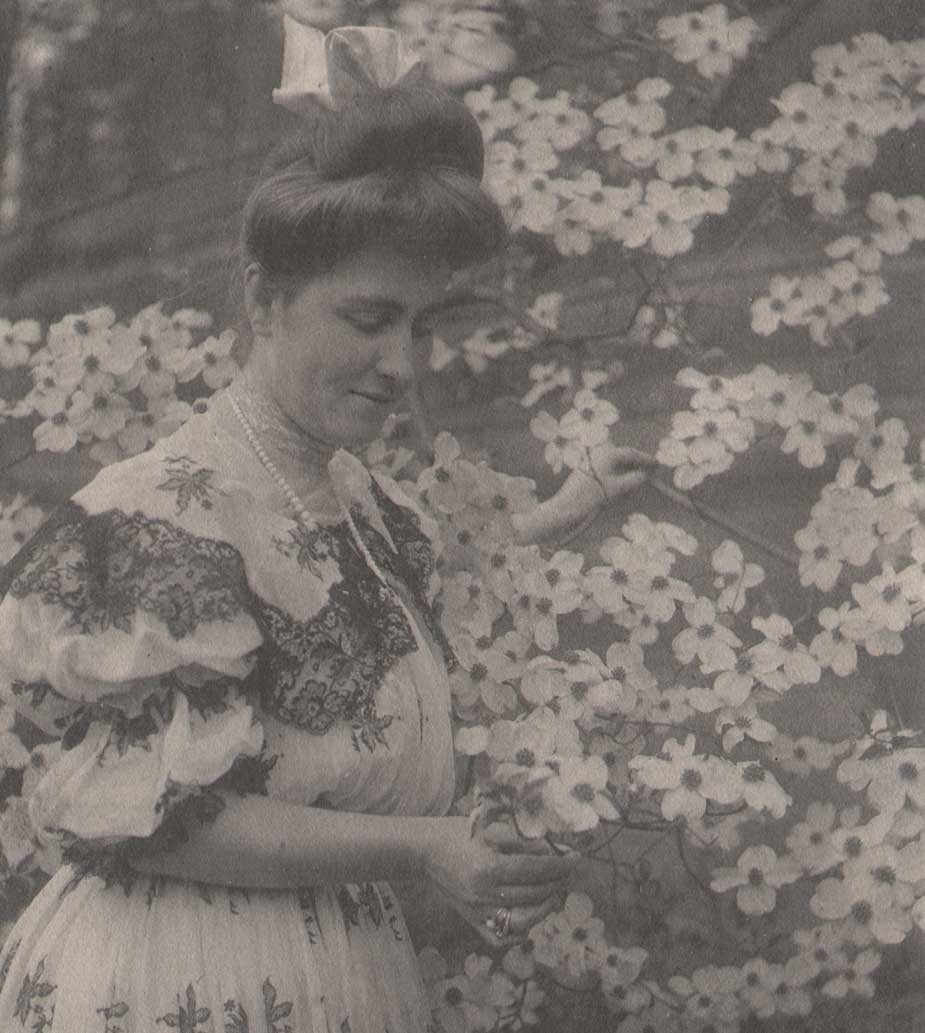 Detail: "Clare Shipman with Dogwood Blossoms": C.M. Shipman: American: platinum: 1904 or before: 17.5 x 11.8 cm | 27.9 x 36.0 cm tipped to black art-paper leaf from album: Born ca. 1880, Clare Cressey Shipman, spouse of amateur photographer Charles Melville Shipman, (1874-1947) examines a cluster of dogwood blossoms, most likely taken in the borough of Richmond on Staten Island, New York City, where the couple lived at the time. The photograph was included with other mostly naturalistic studies compiled in an album by the photographer with the final photograph signed and dated 1904. From: PhotoSeed Archive
Detail: "Clare Shipman with Dogwood Blossoms": C.M. Shipman: American: platinum: 1904 or before: 17.5 x 11.8 cm | 27.9 x 36.0 cm tipped to black art-paper leaf from album: Born ca. 1880, Clare Cressey Shipman, spouse of amateur photographer Charles Melville Shipman, (1874-1947) examines a cluster of dogwood blossoms, most likely taken in the borough of Richmond on Staten Island, New York City, where the couple lived at the time. The photograph was included with other mostly naturalistic studies compiled in an album by the photographer with the final photograph signed and dated 1904. From: PhotoSeed Archive
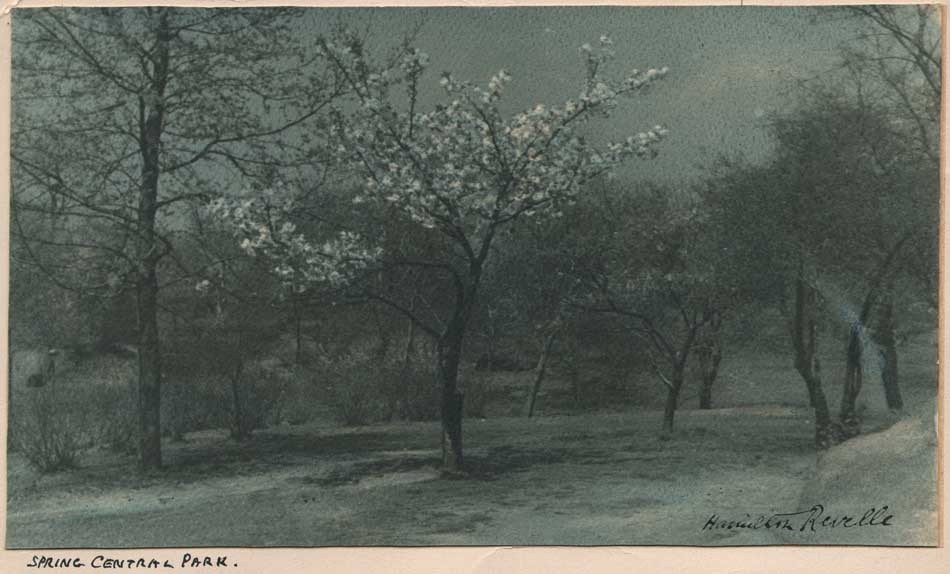 "Spring Central Park": Hamilton Revelle, (1872-1958) English, born Gibraltar: bromoil (hand-colored) ca. 1930-40: 10.2 x 18.5 | 14.3 x 22.4 cm: This delicate hand-colored, blue hued study of a blooming tree in springtime in New York City's Central Park was probably done in the early 1930's along with another landscape study shown with this post. A British born stage and screen actor and consummate amateur photography on the side, he later specialized in the bromoil-transfer process after mastering other processes. The Broadway Photographs website includes a short bio: "Revelle's intense interest in photography perhaps derived from the art's capacity to arrest beauty in timeless perfection. He began carrying his camera equipment with him everywhere and spent his days, before going to the theater in early evening, perfecting his technical mastery of the medium, in platinum, silver, and autochrome. He was an avid experimenter with various printing papers and popularized the print of works on parchment. His portraits were displayed in international salons regularly during the first decade of the 20th century. The Royal Photographic Society of London awarded him its gold medal for excellence in portraiture." From: PhotoSeed Archive
"Spring Central Park": Hamilton Revelle, (1872-1958) English, born Gibraltar: bromoil (hand-colored) ca. 1930-40: 10.2 x 18.5 | 14.3 x 22.4 cm: This delicate hand-colored, blue hued study of a blooming tree in springtime in New York City's Central Park was probably done in the early 1930's along with another landscape study shown with this post. A British born stage and screen actor and consummate amateur photography on the side, he later specialized in the bromoil-transfer process after mastering other processes. The Broadway Photographs website includes a short bio: "Revelle's intense interest in photography perhaps derived from the art's capacity to arrest beauty in timeless perfection. He began carrying his camera equipment with him everywhere and spent his days, before going to the theater in early evening, perfecting his technical mastery of the medium, in platinum, silver, and autochrome. He was an avid experimenter with various printing papers and popularized the print of works on parchment. His portraits were displayed in international salons regularly during the first decade of the 20th century. The Royal Photographic Society of London awarded him its gold medal for excellence in portraiture." From: PhotoSeed Archive
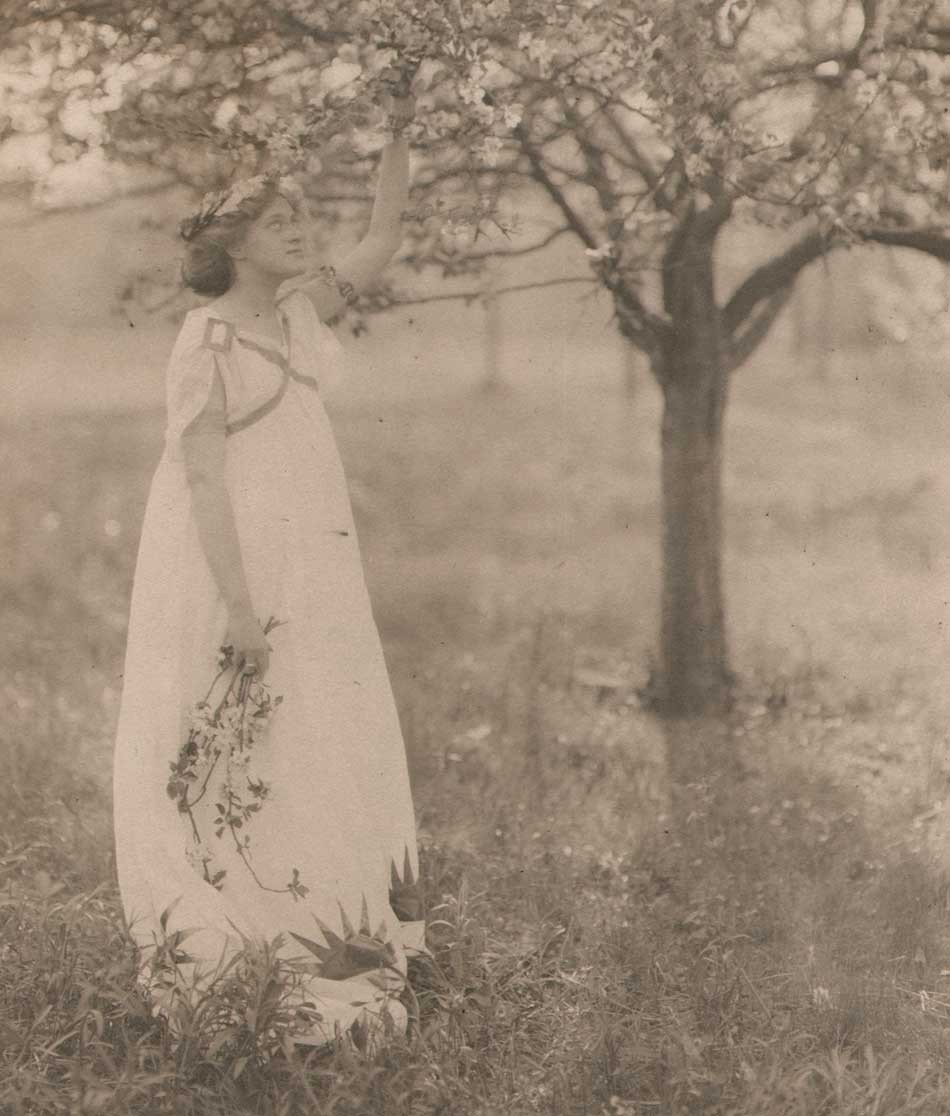 Detail: "Apple Blossoms": Charles Rollins Tucker: American: platinum: ca. 1905-10: 20.3 x 14.7 | 32.7 x 25.5 cm: A genre landscape study celebrating both spring and womanhood, (notice the sunbursts at the bottom of her dress) the model is perhaps a thespian who most likely attended Curtis High School on Staten Island in New York City, where photographer C.R. Tucker taught Physics at the time. From: PhotoSeed Archive
Detail: "Apple Blossoms": Charles Rollins Tucker: American: platinum: ca. 1905-10: 20.3 x 14.7 | 32.7 x 25.5 cm: A genre landscape study celebrating both spring and womanhood, (notice the sunbursts at the bottom of her dress) the model is perhaps a thespian who most likely attended Curtis High School on Staten Island in New York City, where photographer C.R. Tucker taught Physics at the time. From: PhotoSeed Archive
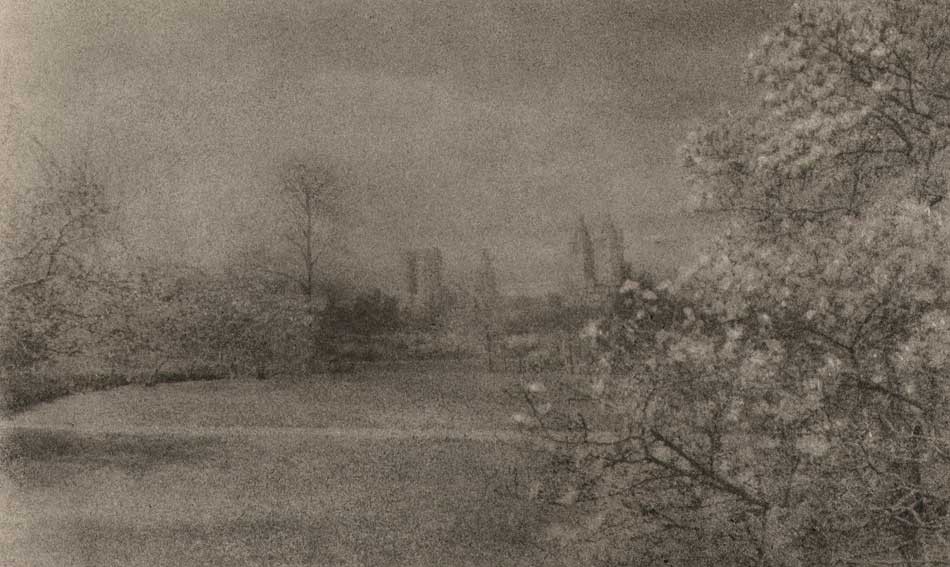 "Central Park Spring with Eldorado": Hamilton Revelle, (1872-1958) English, born Gibraltar: bromoil: ca. 1935-40: 11.5 x 18.5 | 17.6 x 27.8 cm: This bromoil landscape study taken in New York City's Central Park includes a few hints of the Manhattan skyline, including the luxury twin-spired Eldorado apartment building opened in 1931, seen just to the left of the blooming tree on the right side of frame. A British born stage and screen actor and consummate amateur photographer, Revelle later specialized in the bromoil-transfer process after mastering other photographic processes. From: PhotoSeed Archive
"Central Park Spring with Eldorado": Hamilton Revelle, (1872-1958) English, born Gibraltar: bromoil: ca. 1935-40: 11.5 x 18.5 | 17.6 x 27.8 cm: This bromoil landscape study taken in New York City's Central Park includes a few hints of the Manhattan skyline, including the luxury twin-spired Eldorado apartment building opened in 1931, seen just to the left of the blooming tree on the right side of frame. A British born stage and screen actor and consummate amateur photographer, Revelle later specialized in the bromoil-transfer process after mastering other photographic processes. From: PhotoSeed Archive
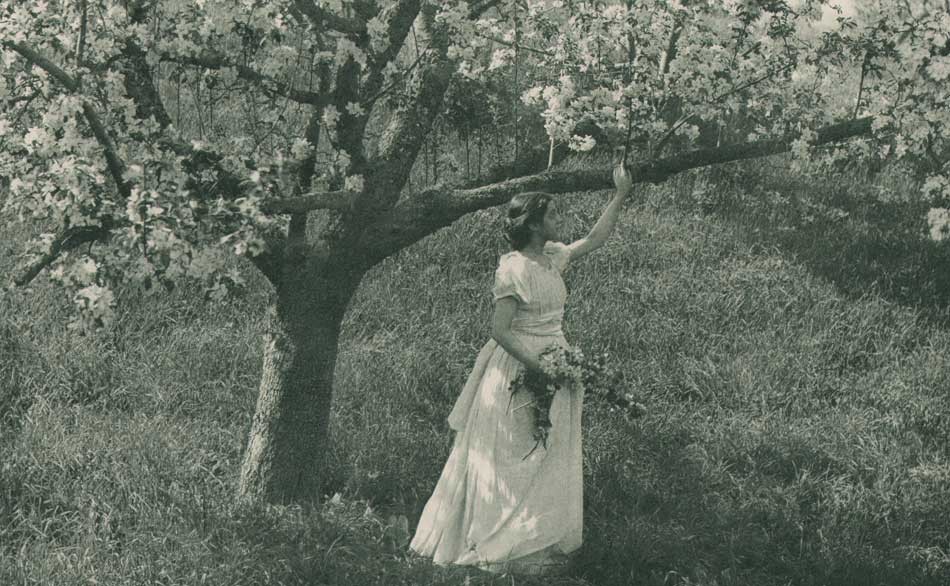 Detail: "Apple Blossoms": Emma Justine Farsworth, American: hand-pulled photogravure published in periodical "Sun & Shade" New York: June, 1893: whole #58: N.Y. Photogravure Co.: 17.0 x 21.7 cm | 27.5 x 34.7 cm: From: PhotoSeed Archive
Detail: "Apple Blossoms": Emma Justine Farsworth, American: hand-pulled photogravure published in periodical "Sun & Shade" New York: June, 1893: whole #58: N.Y. Photogravure Co.: 17.0 x 21.7 cm | 27.5 x 34.7 cm: From: PhotoSeed Archive
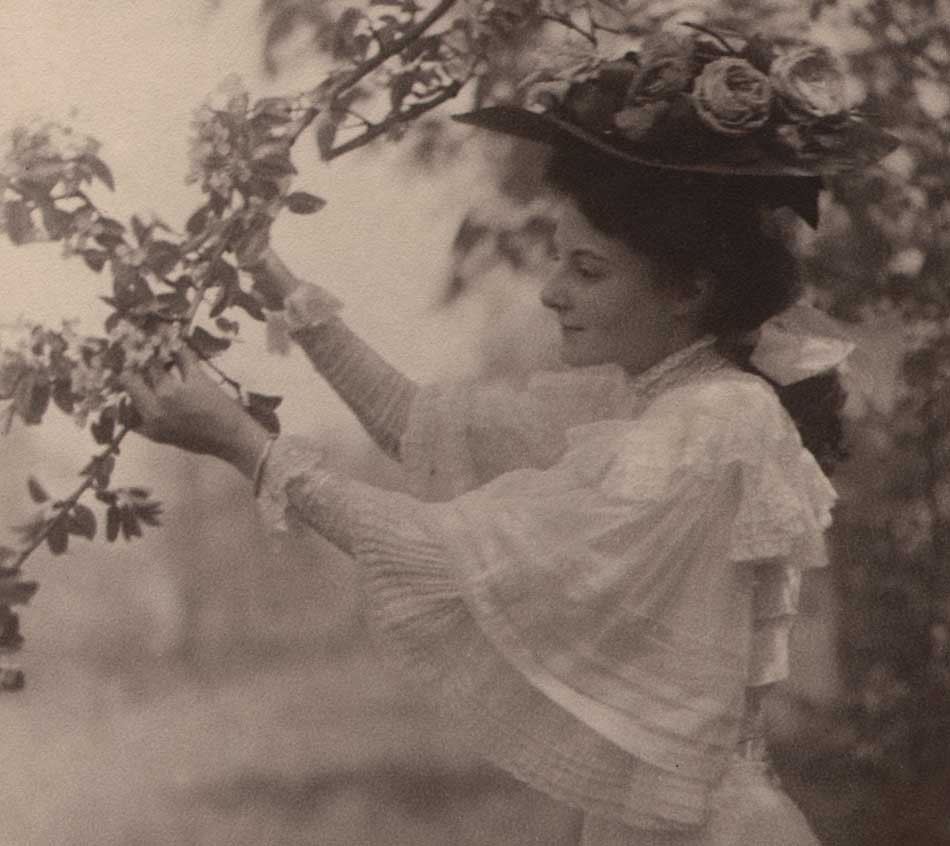 Detail: "Mary Tucker with Apple Blossoms": Charles Rollins Tucker: American: platinum: ca. 1905-10: 26.1 x 19.2 | 30.0 x 22.0 cm: Mary (Carruthers) Tucker, (1870-1940) spouse of amateur photographer C.R. Tucker, holds a bough of blossoms from an apple tree while wearing a hat adorned with flowers in this classic genre study celebrating womanhood in early spring. From: PhotoSeed Archive
Detail: "Mary Tucker with Apple Blossoms": Charles Rollins Tucker: American: platinum: ca. 1905-10: 26.1 x 19.2 | 30.0 x 22.0 cm: Mary (Carruthers) Tucker, (1870-1940) spouse of amateur photographer C.R. Tucker, holds a bough of blossoms from an apple tree while wearing a hat adorned with flowers in this classic genre study celebrating womanhood in early spring. From: PhotoSeed Archive
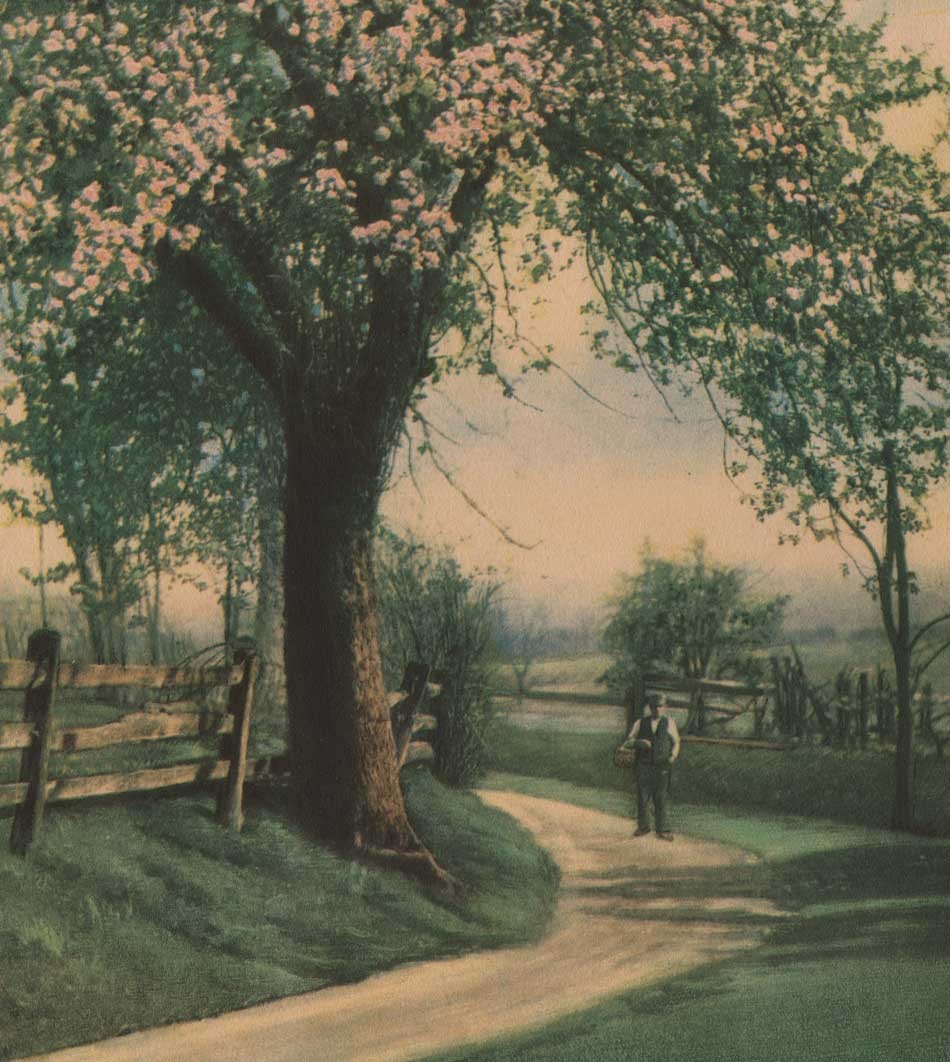 Detail: "In Apple Blossom Time": Henry Troth: American: lithograph, four-color: ca. 1915: 24.7 x 20.3: paperboard mount remnants with following additional details: Negative by Henry Troth; Artist Proof Fac-Simile; Published by the Henry Heininger Co NY.: This landscape study of a gentleman holding a basket in a roadway by Henry Troth shows a large flowering apple tree in the foreground. The Heininger firm, founded in 1885, marketed art reproductions and published postcards in addition to larger works like this. Metropostcard.com states this firm's "Fac-Simile Hand painted Nature Views were of course not hand colored but reproduced hand colored work in four color lithography through the use of paper grains. These cards also have a false plate mark." Another reference included in the publishing trade journal Geyer's Stationer from 1915 when this work is believed to have been produced stated: "The Heininger Co. are famed as well for their extensive line of artist proof facsimile nature pictures so perfectly executed that they readily pass for the high-priced hand-colored photoprints that command such generous prices on the market. The popular prices at which these art subjects are offered should command the instant attention of buyers, who already know the good value of their Abelart line, a complete display of which will be on view." Another Troth spring landscape, "The Hill Road" also appeared in 1915 produced by this firm. From: PhotoSeed Archive
Detail: "In Apple Blossom Time": Henry Troth: American: lithograph, four-color: ca. 1915: 24.7 x 20.3: paperboard mount remnants with following additional details: Negative by Henry Troth; Artist Proof Fac-Simile; Published by the Henry Heininger Co NY.: This landscape study of a gentleman holding a basket in a roadway by Henry Troth shows a large flowering apple tree in the foreground. The Heininger firm, founded in 1885, marketed art reproductions and published postcards in addition to larger works like this. Metropostcard.com states this firm's "Fac-Simile Hand painted Nature Views were of course not hand colored but reproduced hand colored work in four color lithography through the use of paper grains. These cards also have a false plate mark." Another reference included in the publishing trade journal Geyer's Stationer from 1915 when this work is believed to have been produced stated: "The Heininger Co. are famed as well for their extensive line of artist proof facsimile nature pictures so perfectly executed that they readily pass for the high-priced hand-colored photoprints that command such generous prices on the market. The popular prices at which these art subjects are offered should command the instant attention of buyers, who already know the good value of their Abelart line, a complete display of which will be on view." Another Troth spring landscape, "The Hill Road" also appeared in 1915 produced by this firm. From: PhotoSeed Archive
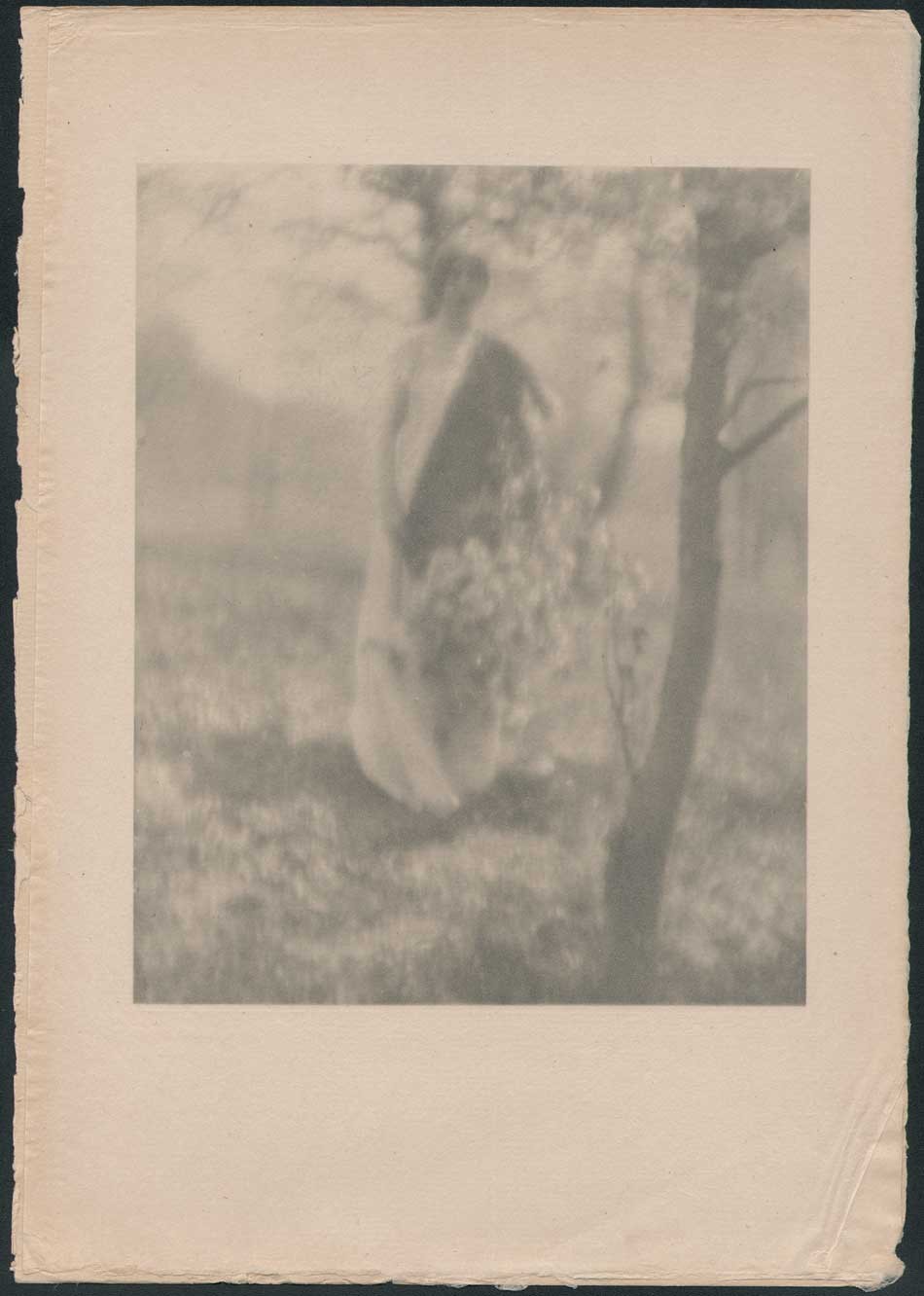 "Spring": George H. Seeley, American: hand-pulled Japan-paper tissue photogravure by the Manhattan Photogravure Co. included with Camera Work issue XXIX, January 1910: 19.7 x 15.8 | 29.7 x 20.6 cm | 30.0 x 21.0 cm- Enfield 1887 watermarked laid paper mount: A review in the February 25, 1910 issue of The British Journal of Photography discusses the ten photogravure plates by Seeley included with CW 29, and singles out this spring study with female model at the critique's conclusion: "Of the plates, the ten photogravures after photographs, by George H. Seeley, are remarkably rich examples of that idle sort of decorative toying with photography which “Camera Work" has always fostered. Mr. Seeley’s technical powers are very considerable. He is master enough to take great liberties with focussing, and does so with impunity; but the greatest enthusiast in art for art’s sake must admit that the subject-matter of Mr. Seeley's work is trivial and tiresome. "Girl with Bowl” is well designed and of exquisite quality. “Autumn" introduces a tambourine and bulrushes, with an inexplicable pose of the model. “The White Screen" shows the lady out of doors, dappled with the shadow from a tree. This is a charming study in tones. Next follow two subjects introducing an artist's palette—the first ridiculous and the next mystifying. Then comes a male nude of no attractions. “White Trees" and “Spring,” by their lightness and delicacy of tones, and the beauty of their suggestion, are, in our opinion, the best pictures of all. In the last two, the photographer’s title resources give out, and he contents himself with calling them No. 347 and No. 356. They do not suffer thereby. No. 356 is truly decorative, and shows us that Mr. Seeley has imbibed good ideas from the classics in painting."(p. 147: there is confusion as to the above numbers: a flysheet includes the pagination as plates VII (White Trees.) & VIII (Spring.): From: PhotoSeed Archive
"Spring": George H. Seeley, American: hand-pulled Japan-paper tissue photogravure by the Manhattan Photogravure Co. included with Camera Work issue XXIX, January 1910: 19.7 x 15.8 | 29.7 x 20.6 cm | 30.0 x 21.0 cm- Enfield 1887 watermarked laid paper mount: A review in the February 25, 1910 issue of The British Journal of Photography discusses the ten photogravure plates by Seeley included with CW 29, and singles out this spring study with female model at the critique's conclusion: "Of the plates, the ten photogravures after photographs, by George H. Seeley, are remarkably rich examples of that idle sort of decorative toying with photography which “Camera Work" has always fostered. Mr. Seeley’s technical powers are very considerable. He is master enough to take great liberties with focussing, and does so with impunity; but the greatest enthusiast in art for art’s sake must admit that the subject-matter of Mr. Seeley's work is trivial and tiresome. "Girl with Bowl” is well designed and of exquisite quality. “Autumn" introduces a tambourine and bulrushes, with an inexplicable pose of the model. “The White Screen" shows the lady out of doors, dappled with the shadow from a tree. This is a charming study in tones. Next follow two subjects introducing an artist's palette—the first ridiculous and the next mystifying. Then comes a male nude of no attractions. “White Trees" and “Spring,” by their lightness and delicacy of tones, and the beauty of their suggestion, are, in our opinion, the best pictures of all. In the last two, the photographer’s title resources give out, and he contents himself with calling them No. 347 and No. 356. They do not suffer thereby. No. 356 is truly decorative, and shows us that Mr. Seeley has imbibed good ideas from the classics in painting."(p. 147: there is confusion as to the above numbers: a flysheet includes the pagination as plates VII (White Trees.) & VIII (Spring.): From: PhotoSeed Archive
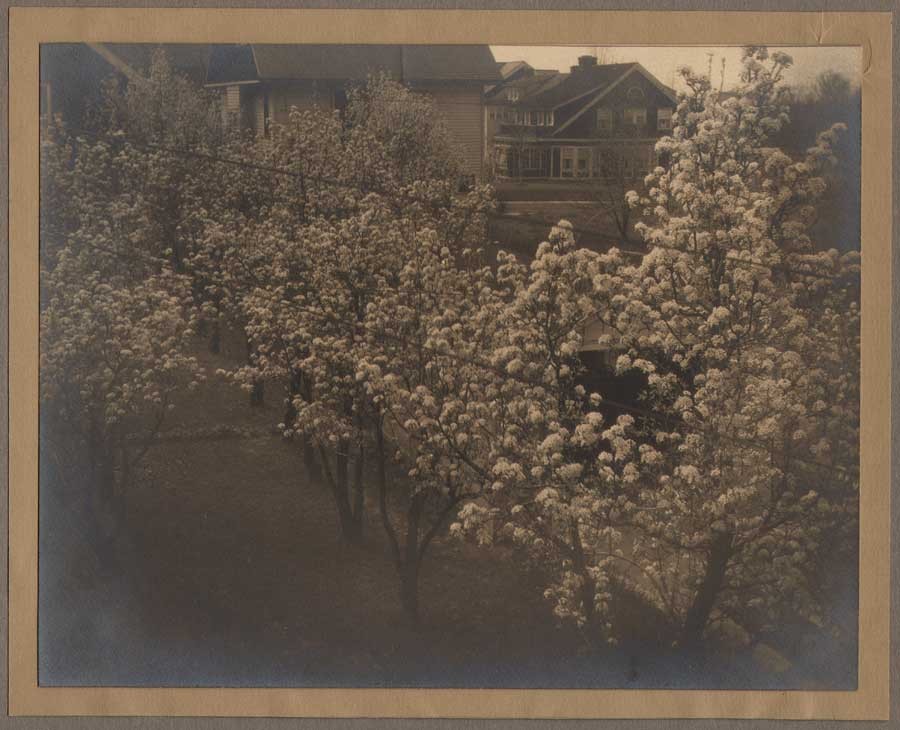 "Backyard Apple Trees Blossoming": Leo Kraft, (1885-1927) American: gelatin silver print, ca. 1915-20: 19.0 24.3 | 21.0 26.1 | 33.0 x 39.3 cm. This photograph most likely picture's the backyard area of the photographer's Lakewood, Ohio home outside Cleveland showing a double-line of flowering apple or crabapple trees. The print is believed to be printed on Kodak's P. M. C. Bromide (double weight) paper like other known examples by Kraft in this archive.: From: PhotoSeed Archive
"Backyard Apple Trees Blossoming": Leo Kraft, (1885-1927) American: gelatin silver print, ca. 1915-20: 19.0 24.3 | 21.0 26.1 | 33.0 x 39.3 cm. This photograph most likely picture's the backyard area of the photographer's Lakewood, Ohio home outside Cleveland showing a double-line of flowering apple or crabapple trees. The print is believed to be printed on Kodak's P. M. C. Bromide (double weight) paper like other known examples by Kraft in this archive.: From: PhotoSeed Archive
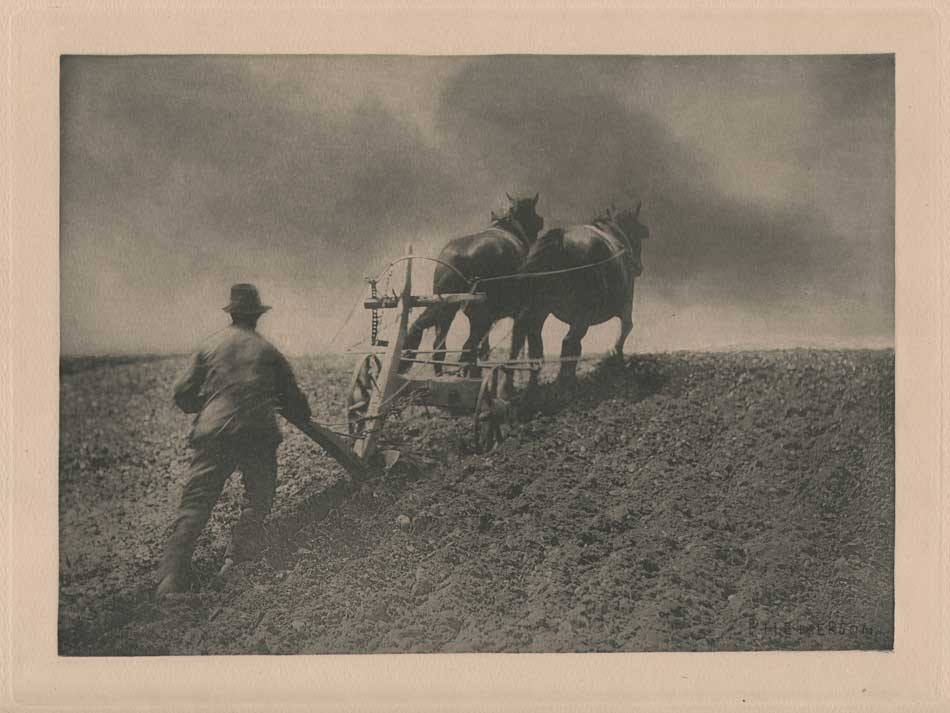 "A Stiff Pull": Peter Henry Emerson: British, born Cuba: hand-pulled photogravure by the photographer included in his limited, second-edition portfolio "Pictures of East Anglian Life": 1890: 20.7 x 28.8 | 34.1 x 42.6 cm: A farmer guides a plow behind a team of two horses as he tills the earth in the English spring countryside. England's Victoria & Albert Museum notes of this work included with this portfolio: "In 1889 Emerson published his controversial book 'Naturalistic Photography for Students of the Art' without images. 'Naturalistic Photography' examined his purist approach to photography, derived from his fascination with Naturalism in art, and attacked the prevailing artificial aesthetic in art photography. After its publication Emerson felt that his opponents had misunderstood his ideas. So, in 1890 he selected 10 plates from his book 'Pictures of East Anglian Life' (1888) that best illustrated his theories, and presented them loose in a portfolio dedicated to the ‘photographic student’, with the same title and cover of the book. He then donated copies of this portfolio to every photographic society in the country." Included in the work as plate III, "A Stiff Pull" is also reproduced as a line engraving on the oversized canvas board folio, but with the odd inclusion of the ocean with sailboats and gulls flying overhead on the horizon. From: PhotoSeed Archive
"A Stiff Pull": Peter Henry Emerson: British, born Cuba: hand-pulled photogravure by the photographer included in his limited, second-edition portfolio "Pictures of East Anglian Life": 1890: 20.7 x 28.8 | 34.1 x 42.6 cm: A farmer guides a plow behind a team of two horses as he tills the earth in the English spring countryside. England's Victoria & Albert Museum notes of this work included with this portfolio: "In 1889 Emerson published his controversial book 'Naturalistic Photography for Students of the Art' without images. 'Naturalistic Photography' examined his purist approach to photography, derived from his fascination with Naturalism in art, and attacked the prevailing artificial aesthetic in art photography. After its publication Emerson felt that his opponents had misunderstood his ideas. So, in 1890 he selected 10 plates from his book 'Pictures of East Anglian Life' (1888) that best illustrated his theories, and presented them loose in a portfolio dedicated to the ‘photographic student’, with the same title and cover of the book. He then donated copies of this portfolio to every photographic society in the country." Included in the work as plate III, "A Stiff Pull" is also reproduced as a line engraving on the oversized canvas board folio, but with the odd inclusion of the ocean with sailboats and gulls flying overhead on the horizon. From: PhotoSeed Archive
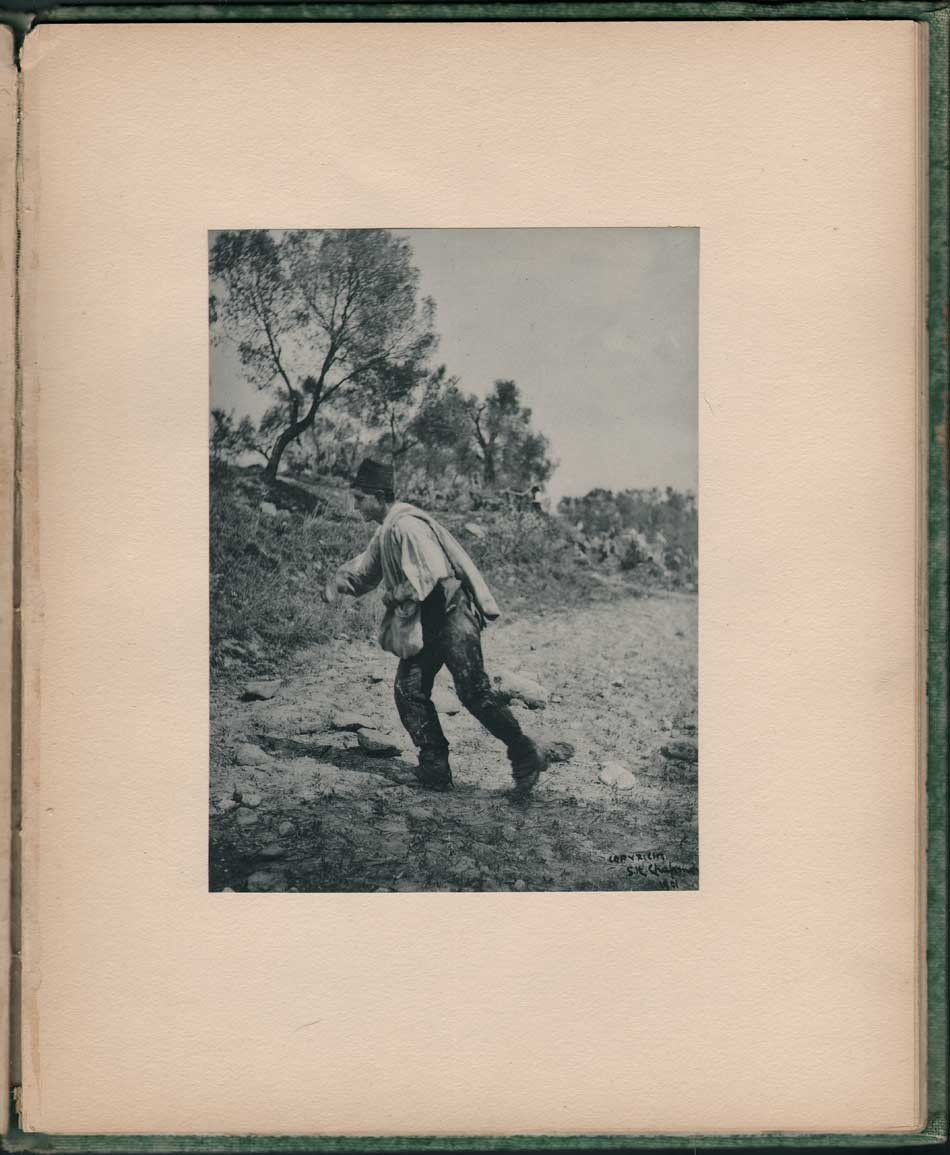 "Some fell upon Stony Places,…": Samuel Hudson Chapman, American (1857-1931): platinum print included in his self-published volume: "The Parable of the Sower, Illustrated From Life, With The Series of Pictures Awarded The Allison Silver Cup of the Photographic Society of Philadelphia For the Year 1900: S.H. & H. Chapman 1348 Pine Street, 1901: 18.8 x 13.9 corner-glued | 31.5 x 25.4 cm: A dealer in rare coins along with his brother Henry, Philadelphia resident Samuel Hudson Chapman was also an accomplished photographer and president of the Photographic Society of Philadelphia at the time he published this volume which included this photograph in 1901. Showing a farmhand sowing seeds in the springtime, most likely done in the Italian countryside, the following copy accompanies the work opposite, from the King James Version of the Bible's Book of Matthew: "Some fell upon Stony Places, where they had not much earth: and forthwith they sprung up, because they had no deepness of earth; and when the sun was up, they were scorched; and because they had no root, they withered away." From: PhotoSeed Archive
"Some fell upon Stony Places,…": Samuel Hudson Chapman, American (1857-1931): platinum print included in his self-published volume: "The Parable of the Sower, Illustrated From Life, With The Series of Pictures Awarded The Allison Silver Cup of the Photographic Society of Philadelphia For the Year 1900: S.H. & H. Chapman 1348 Pine Street, 1901: 18.8 x 13.9 corner-glued | 31.5 x 25.4 cm: A dealer in rare coins along with his brother Henry, Philadelphia resident Samuel Hudson Chapman was also an accomplished photographer and president of the Photographic Society of Philadelphia at the time he published this volume which included this photograph in 1901. Showing a farmhand sowing seeds in the springtime, most likely done in the Italian countryside, the following copy accompanies the work opposite, from the King James Version of the Bible's Book of Matthew: "Some fell upon Stony Places, where they had not much earth: and forthwith they sprung up, because they had no deepness of earth; and when the sun was up, they were scorched; and because they had no root, they withered away." From: PhotoSeed Archive
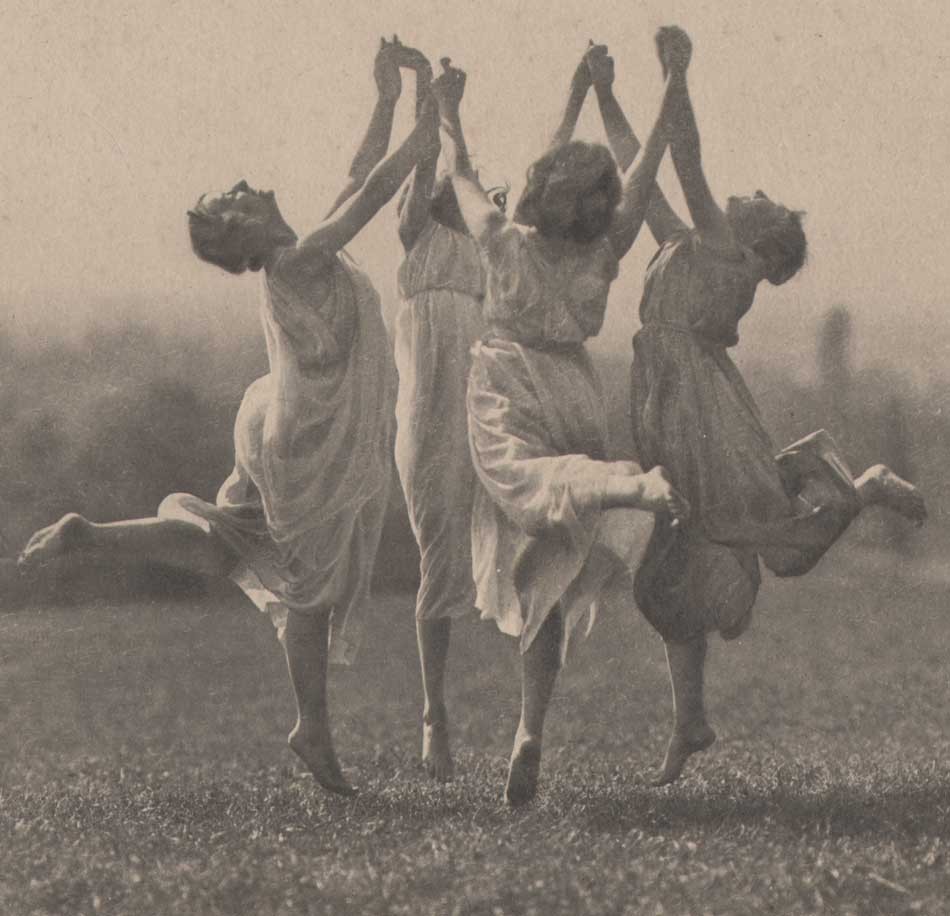 Detail: "Vers L'Idéal, Jeunes Filles Dansant : "Towards the Ideal, Young Girls Dancing" : Frederick Boissonnas, Swiss (1858-1946): hand-pulled photogravure by Munich's Verlagsanstalt F. Bruckmann A.-G. : 1911: 21.2 x 29.2 | 26.3 x 36.6 cm: Suggestive of an exuberant ritual acknowledging rebirth in spring, this photographic study of four female dancers can be dated to around 1911, when it was titled Vers L'Ideal "Towards the Ideal" and exhibited as part of the London Salon of Photography, where it was shown cropped to the central figures. These dancers were students attending a school teaching the "Dalcroze Method" of music pedagogy in Hellerau, Germany, now part of Dresden. The school was founded in 1910 by the Swiss composer, musician and music educator Émile Jaques-Dalcroze. (1865-1950) From: PhotoSeed Archive
Detail: "Vers L'Idéal, Jeunes Filles Dansant : "Towards the Ideal, Young Girls Dancing" : Frederick Boissonnas, Swiss (1858-1946): hand-pulled photogravure by Munich's Verlagsanstalt F. Bruckmann A.-G. : 1911: 21.2 x 29.2 | 26.3 x 36.6 cm: Suggestive of an exuberant ritual acknowledging rebirth in spring, this photographic study of four female dancers can be dated to around 1911, when it was titled Vers L'Ideal "Towards the Ideal" and exhibited as part of the London Salon of Photography, where it was shown cropped to the central figures. These dancers were students attending a school teaching the "Dalcroze Method" of music pedagogy in Hellerau, Germany, now part of Dresden. The school was founded in 1910 by the Swiss composer, musician and music educator Émile Jaques-Dalcroze. (1865-1950) From: PhotoSeed Archive
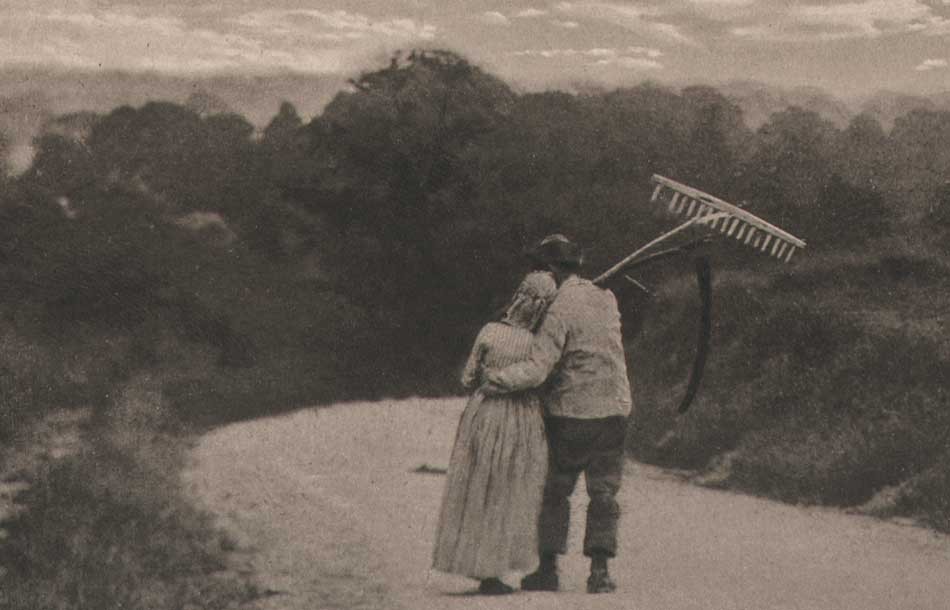 Detail: "Sweet Springtime" : Ralph Winwood-Robinson, English (1862-1942): hand-pulled, Chine-collé edition photogravure from limited-edition portfolio "Amateur-Kunst: 37 Photogravuren Nach Naturaufnahmen" (Amateur Art: 37 photo Engravings after nature Photographs) published by Richard Paulussen at Vienna's Gesellschaft für Vervielfältigende Kunst: 1891: 20.6 x 26.8 | 35.6 x 48.2 cm: Titled "Sweet Springtime", this romantic landscape genre study showing a couple walking together (please see this website for uncropped version) down a road past a windmill was taken by the son of renowned English photographer Henry Peach Robinson. It was exhibited in Vienna during the groundbreaking 1891 "Internationale Ausstellung Künstlerischer Photographien" (International Exhibition of Art Photographers) organized by the Club of Amateur Photographers in Austria (Club der Amateur Photographen in Wien) the same year.: From: PhotoSeed Archive
Detail: "Sweet Springtime" : Ralph Winwood-Robinson, English (1862-1942): hand-pulled, Chine-collé edition photogravure from limited-edition portfolio "Amateur-Kunst: 37 Photogravuren Nach Naturaufnahmen" (Amateur Art: 37 photo Engravings after nature Photographs) published by Richard Paulussen at Vienna's Gesellschaft für Vervielfältigende Kunst: 1891: 20.6 x 26.8 | 35.6 x 48.2 cm: Titled "Sweet Springtime", this romantic landscape genre study showing a couple walking together (please see this website for uncropped version) down a road past a windmill was taken by the son of renowned English photographer Henry Peach Robinson. It was exhibited in Vienna during the groundbreaking 1891 "Internationale Ausstellung Künstlerischer Photographien" (International Exhibition of Art Photographers) organized by the Club of Amateur Photographers in Austria (Club der Amateur Photographen in Wien) the same year.: From: PhotoSeed Archive
